The ideal combo of oatmeal, pancake and muffin. They’re protein and fibre-full and naturally sweet (no refined sugar), bursting with berries (zero dryness here) and filling. They’re quick to make, and super convenient as they can be made in advance, frozen and defrosted when cravings strike. They also look rather irresistible on any breakfast table, so great for when you have guests.
Viewing entries in
Sweet
I wanted chocolate. I wanted peanuts. I wanted caramel. And so came together three revered ingredients to make this simple but deeply luscious dessert. I admit to a glimmer of inspiration from the Season 11 contestant of RuPaul’s Drag Race contestant, the drag queen with the moniker Silky Nutmeg Ganache. But apart from that, I attribute this recipe to greed.
OK, so I’m going to tell you about a brilliant new diet to ensure you lose all that Christmas flab.
It throws 5:2, Keto, raw food, Mediterranean and intermittent fasting out of the window. If you’re disillusioned with all those malware-laden pop up adverts on illegal streaming sites that you secretly clicked on promising flat belly magic trick, let me right that for you.
After some hardcore, scientific studies on how people gain weight, which foods trigger fat gain and how we’re rotting our metabolism, my dad had an epiphany and realised that all these diets were ignoring the obvious.
All those Instagram/YouTube stars chronicling the secrets to peachy bums, thigh gaps, hotdog legs and concave stomachs have been holding back their industry secrets. It’s not food groups that need to be cut out, but letters. All the foods (and often drinks) that stand in the way of a lean, rippling bikini bod have something in common: biscuits, cookies, bread, chocolate, cake, bagels, beer, cocktails, champagne, and brownies. Yes. That’s right – you’ve wasted money and/or time logging on to My Fitness Pal, consulting dieticians, and calorie counting when I have just given you the secret to fat loss. Cut out the Bs and Cs and you are on your way to fitfluencer stardom.
Pregnancy is the benchmark by which weight gain is measured in my household, and my dad came back from India in his second trimester.
Turns out feasting on gulab jamun, breakfast, lunch and dinner dosas, curry upon curry, daily afternoon tea and even straight up jaggery does that to you. This drastic increase from two to five months’ gestation in the space of two weeks, plus a stomach of steel allowing evasion of the revolting bug that had churned up the rest of my family’s insides, meant that a new diet and regime was mandatory. And when my dad commits to something, he is an all-or-nothing person. And let me tell you, cutting out B and C foods is far easier than you might think. In fact, it’s practically seamless. Don’t worry about cheat meals or relapses because this is a diet that works perfectly with whatever lifestyle you were already leading.
My dad’s commitment to the diet has been so fervent and admirable that when I offered him a Jerusalem bagel (from last week) he refused.
He heroically turned down the molten chocolate brownies that I brought into work. He didn’t even respond to me when the exotic perfume of these thick, soft and chewy spice cookies wafted round the house (commendable).
You see the diet works so well that if you’re clever about it, and careful, you don’t really need to sacrifice anything at all.
His resolve has been so strong that cookies are now banned from our house, as are bagels, biscuits, chocolate and brownies.
Instead, we have a whole inventory of agels, and iscuits, hocolate and rownies and ookies.
My dad has had five of these spice ookies today and he’s still fully committed to the diet - and so can you. Just like that one calorie that gets left floating in the can when you have diet coke, so all the muffin-top inducing calories are left behind when the B and C’s are seamlessly spliced from your favourite treat.
This is the diet to be on because these (c)ookies are the ambrosia of the (c)ookie world – they’re a one bowl wonder and can be whizzed up in a matter of minutes.
There’s no freezing, chilling or resting meaning that they can go from flour packet to final product-in–mouth in about half an hour (pausing en route for some of that dough). I know cookies can be a very subjective, personal and emotional topic, but these are undeniably the top tier: slightly crisp on the outside and soft thic(cc)k and chewy. If you fear that the batch may disappear before you get a look in, feel free to double it – the results will be the same. They can also be stored in an airtight container in a freezer for up to three months which is ideal if you want to whip them out for unexpected occasions (emergencies).
Thick & Chewy Spice Cookies - Recipe
Makes 12-14 cookies
Ingredients
220g white spelt flour (or plain white flour, if you prefer)
2 ½ tsp baking powder
60g caster sugar
1 tsp ground ginger
½ tsp ground cloves
1 tsp ground cinnamon
1 ½ tsp baking soda
100g unsalted butter, at room temperature, roughly cut into cubes
100g golden syrup
20g treacle
¼ tsp salt
1 tsp mixed spice
large baking tray lined with baking parchment
Method
1) Preheat oven to 160°C.
2) If using a food processor (super quick), pour in all the dry ingredients and whizz to combine. Then add in the butter and pulse until the mixture becomes like damp sand. If making by hand, in a large bowl stir together dry ingredients. Then add in the butter and rub into the dry mixture with your fingertips until it reaches a damp sand-like consistency.
3) In a small pan over a low heat, pour in the syrup and treacle, and stir until combined and warm. Pour into the sand-like mixture, and pulse until it just about comes together into a dough, taking care not to over mix. If making by hand, pour the treacle into the sand-like mixture, and stir together until it forms a dough.
4) Make the cookies by breaking off pieces of the dough with your hands and rolling them into a sphere. I make each one 35g to ensure that they bake consistently. Then space the spheres on a baking tray at least 5cm apart. Place in the preheated oven to bake for 8-12 minutes until golden but soft to the touch. They will continue to bake once removed from the oven so taking them out slightly underdone ensures that they have a chewy centre.
5) Allow to cool before eating (they will be too friable when straight out of the oven), then devour. Once cool, they can be kept in a sealed airtight box in a freezer for up to 3 months.
HUNGRY FOR MORE?
This bread is the love child of a brioche and stollen. The dough is soft, buttery and ridiculously moreish. And the filling is like that marzipan core of stollen except less overpoweringly almondy, lighter and less tooth-achingly sweet (which means you can have more of it, of course). One of my many intolerances is not gluten, nuts or dairy but overpromising. If the title promises a filling, I want that filling, and I want it in abundance. If it says caramel, I want luscious rivers of it; if it’s olives on a pizza, I want at least one for every 2cm squared (NB I am disappointed by this every time - unless I make it myself). And, if it is a frangipane bread, I demand every mouthful to be molten with frangipane.
So, in response, this bread will not fail to meet expectations: not only a show stopper in appearance, it is also ambrosial. I had to make this several times in order to photograph it before it was inhaled by surrounding friends/family.
If you want to have plain bread, just leave out the frangipane and follow the instructions below. Similarly, if you’re feeling experimental add another filling in place of the frangipanes - think Nutella, marmalade, fruit conserve…
Ingredients (makes 2 loaves)
For the bread
30g fresh yeast (or 15g dry yeast)
100g caster sugar
250ml lukewarm milk (normal or any non-dairy alternative)
2 large eggs, beaten
1 tsp salt
700g white spelt flour (or plain wheat) + more for kneading
100g unsalted butter, at room temperature
For the frangipane
180g caster sugar
150g unsalted butter, at room temperature
4 eggs
½ tsp salt
250g ground almonds
1 ½ tsp almond extract
2 large baking sheets lined with baking parchment
Method
1) In the bowl of an electric mixer (or large mixing bowl), cream together fresh yeast and caster sugar until the sugar begins to dissolve and turns the yeast liquid. If using dry yeast, add it into the milk first and allow to sit for five minutes before continuing with step 2.
2) Pour in lukewarm milk, 3/4 of the beaten eggs (i.e. 1 ½ eggs, keeping the other half aside to paint the bread) and salt, and whisk together. Whisk in 100g grams of the flour to begin to incorporate air.
3) Add the remaining flour into the mixture and mix together. Once combined, either using a mixer fitted with the dough hook, or on a heavily floured surface knead the dough for about 5 minutes until it is smooth and bounces back when pressed with your thumb. Temperature and humidity can affect the dough texture so you may need to add a touch more flour if it is truly unworkable, though try to keep it to a minimum as too much will make the bread tough and the dough difficult to roll out. I find that using the dough hook initially until combined and then kneading by hand for the last stretch particularly effective.
4) Place in a large oiled bowl in a warm spot and cover with a cloth or clingfilm to allow to rise until doubled in size (about 45 minutes to an hour).
5) At this point, if you wish to make the bread without the frangipane, proceed to step 7a
6) To make the frangipane, beat together the sugar and butter until light and fluffy. You can do this by hand or in a mixer fitted with the paddle attachment. Beat in the eggs (don’t worry if it looks slightly curdled at this point), then stir in salt, ground almonds and almond extract. It should be a smooth almondy paste.
7) Once the dough has risen, punch back down, turn it onto a heavily floured surface
a. For bread without filling: divide dough into two (to make two loaves). Shape as desired, but if you favour a plaited loaf, as I do, taking one of the dough halves, divide it into three or four pieces (depending on whether you prefer a three- way or four-way plait.) Roll each piece into a long, even strand of about 3cm in diameter. Then pinch the ends together and plait as normal. When you reach the end of the plait, pinch the strands together and tuck under. Repeat for the second loaf, place on a baking tray and cover. Leave to rise for about half an hour.
b. For bread laced with frangipane: place the dough on a large, flat, heavily floured surface and roll it to a rectangle of about 60 x 30cm and about ¾ cm thick. Tip the frangipane mixture into the centre of the dough, and spread it out evenly with a spatula right up to the edges. Then, from the long side, roll the dough to make a long tight coil. Finish with the seal at the base of the roll. Then slice the roll into two (in order to make two loaves). Take one long roll and holding the knife directly above the roll, with the blade parallel to the length of the roll, bisect it running the knife through the centre along the its length. Once split, with the open halves separate, pinch them at the top and then cross one over the other repeatedly in a kind of two string plait. Pinch at the end and tuck it under then place on baking tray. Repeat with the other half.
8) Cover both breads with a cloth, and allow to rise in a warm place for 45 minutes. Preheat the oven to 200 °C.
9) With the remaining beaten egg, brush the tops of the breads. Place the breads in the oven to bake for 10 minutes. Then reduce the oven temperature to 180 °C and allow to bake for a further 10-15 minutes. Ovens can be temperamental, so check every 5-10 minutes to ensure that the bread doesn’t burn. If it looks like it is beginning to catch, cover with aluminium foil and continue to bake. Remove from the oven when the outside is a deep golden colour. Place on a cooling rack and allow to reach room temperature, then devour. Best eaten on day of baking, but the bread can be frozen in a sealed air tight container for up to 3 months.
HUNGRY FOR MORE?
If I told you that a vegan, refined sugar-free, protein-rich, wheat-free, ancient-grain (and if you so desire, gluten-free) cookie existed, you’d think it was the stuff of myth and legend or, alternatively, something so disgusting that it couldn’t be deemed edible.
Well, it does exist.
After an overindulgent stay in NYC, I made these for my birthday. They aren’t overpoweringly sweet, and they aren’t going to be equivalent to the 500 calories a pop thick, fudgy cookies you see in bakeries. However, they are delicious in their own right, soft and just sweet enough. Plus, being vaguely healthy automatically entitles one to devour 5x the quantity. In fact, for a snack to be officially deemed a source of protein, it needs to contain 6g protein. Well, 3 of these cookies contain just that.
They are extremely quick to conjure up and would be good for that weak-point, late afternoon slump when you crave something sweet, and delicious, too, paired with a (vegan) ice cream for dessert, or even with a wedge of stilton and a dollop of pear compote if you’re going down the non-vegan route. If you want a slightly more savoury option, substitute the dates with figs as in the photos.
Ingredients (makes 20 medium cookies)
160g pitted medjool dates, roughly chopped (about 10) (if you want a more savoury cookie, substitute dates with figs, as per the photos)
4 tbsp orange juice
4 tbsp water
1 tsp vanilla
½ tsp finely grated orange zest
80g smooth peanut butter
200g spelt flour (or gluten free flour)
½ tsp mixed spice
¼ tsp salt
baking tray lined with baking parchment
4-5cm round cookie cutter
Method
1) Pre-heat oven to 180°C
2) Place the chopped dates, orange juice, water, vanilla extract and orange zest in a small pan over a medium/high heat and allow to come to a boil. Stir continuously for about 4/5 minutes until all the liquid has evaporated and the dates have turned into a thick, sticky pulp.
3) Place the date mixture together with the peanut butter in a blender and pulse until smooth. Pour in the spelt flour, mixed spice, and salt and pulse until it comes together to form a slightly sticky dough.
4) Lightly flour a board and roll out the dough to a 0.5cm thickness. Stamp out cookies with the cutter and place on the baking tray. Bake in the oven for 7-10 minutes until firm and slightly golden. Allow to cool, then devour.
HUNGRY FOR MORE?
...& 14 Thoughts from the Kitchen Sink
From the moronic to the morbid, here’s an insight into what happens when I bake and let my mind wander:
- Drowning in a vat of sticky bread dough would probably be the worst way to die.
- When you sieve icing sugar and it puffs into the air in clouds, how many calories are there in one mouthful of air?
- Why do so many obscure meats taste like chicken and not beef?
- What is the significance of sometimes craving baby food - especially rusks, and pureed apple and banana?
- Why do we delude ourselves that avocado on toast has been ‘smashed’? I’ve never seen anyone smash an avocado. I suppose ‘smeared’ doesn’t have the same ring to it.
- If I could subsist on one food for the rest of my life it would most likely be oats.
- Nandos’ ‘hot’ sauce is anachronistic. It was created about 20 years ago and people’s (i.e.my brother’s and my) tolerance for heat has gone up. They should downgrade it to ‘medium’.
- What was the exact moment when someone decided to put sugar, milk, butter and flour together to make the very first cake?
- How do you know nigella seeds are nigella seeds and not mouse droppings?
- If 2017 was the year of slime porn, why can’t 2018 be the year of dough porn?
- Earlier this year some pig farmers tried to halt the use of pig terminology as connotative of greed. Imagine if other farmers were to do the same: we couldn’t exclaim something was cheesy, or call people ugly cows, or ask people with whom we’re angry if they want beef, or complain that bland people are vanilla, or exclaim that someone is mutton dressed up as lamb, or taunt cowards as being chicken…
- How many times in my life has a waiter spat in my food on purpose?
- Why do I have six jars of preserved lemons in my cupboard when I only use a small shaving of one once a year?
- The smell of freshly baked bread should be a perfume.
That’s enough musing for one day.
Here’s the recipe for an exceedingly luscious cake. It is succulent, and filled with roasted strawberries so that there is at least one deliquescing in every bite. The berries on the surface turn almost jam-like in the oven. Absurdly quick and easy to make, it is totally moreish.
NB. This cake can be made gluten-free by substituting the flour for gluten free.
Luscious Strawberry cake
Serves 6-8 (depending on level of greed)
Ingredients
85g unsalted butter, at room temperature
160g caster sugar + 2 tbsp for the topping
1 large egg
120ml milk
1 tsp vanilla extract
190g white spelt flour (or gluten-free equivalent)
1 1/2 tsp baking powder
1/2 tsp salt
400g strawberries, after having been hulled and halved
20cm diameter round springform cake tin, either totally lined with baking parchment (if you’re feeling lazy and you don’t mind crinkly cake sides), or thoroughly greased with butter and the base lined with a circle of baking parchment
Method
1) Preheat the oven to 180°C.
2) Either by hand or in a stand mixer fitted with the paddle, beat the butter and sugar together until soft, light and fluffy (which should take about three minutes). Then pour in the egg, milk and vanilla extract and beat to combine. It may look slightly curdled but that is not a problem.
3) Into the wet ingredients sieve the flour, baking powder and salt. Gently fold the dry ingredients through until the batter is smooth and fully combined. Pour into the prepared cake tin.
4) Arrange the strawberries cut side down in the batter. You make need to overlap some or push some down to fit them all in. Sprinkle the 2 tbsp of caster sugar over the top and place in the oven.
5) Bake for 45-55 minutes (depending on oven), checking after 30 minutes. You may need to cover the top with aluminium foil if the surface looks at risk of becoming too dark. When ready, the top should be a deep gold and a cake tester should come out batterless (moisture from the strawberries will prevent it from coming out totally clean).
6) Allow to cool on a wire rack and devour on the day, or within two days, of baking.
(Adapted from Smitten Kitchen)
HUNGRY FOR MORE?
A trip to Toronto when I was seven years’ old is anchored for me by one thing: not the CN tower, or Niagara Falls or my cousin’s wedding, but a visit to the farmers’ market, and in particular, a potentially life-changing stall. A tall, russet-cheeked man was in command, his floured apron stretched taught over his protuberant belly.
And on his table lay not the garish, sprinkle- speckled swirls that would have drawn a normal child. Instead, tray after tray of rubbly slabs of oat and date crumble bars were arrayed.
The date layer of the bars was jaw-clenchingly sticky, and thick – not like the mean, shop-bought equivalent. The oaty outer layers were both crunchy and then soft, golden and not overly sweet, allowing the natural date sweetness to shine through.
. For the last seventeen years I’ve been raiding bakeries and markets, seeking to relive the experience, but the date and oat crumble bars always disappoint – too saccharine, too solid, too floury. In between raids, I’ve been working on my own: these are the closest I have come to Toronto’s best kept secret. I added the crushed amaretti to give them a little twist. Feel free to leave the sugar out of the crumble if your palate is adjusted to the less-sweet.
It’s incredibly hard to resist them when they emerge from the oven golden and crisp, but I think they taste even better when they have cooled and the flavours are more distinct (or maybe try them both ways, just to be sure…).
NB. They can be made gluten-free by substituting gluten-free flour for spelt.
Ingredients
Date filling
400g medjool dates, pitted & roughly chopped (about 20)
3 tbsp fresh orange juice
120ml water
2 tsp vanilla extract
½ tsp mixed spice
½ tsp finely grated orange zest
Crumble
250g oats
120g butter
100g wholemeal spelt flour
50g dry amaretti biscuits
40g light brown muscovado sugar
¼ tsp mixed spice
½ tsp vanilla extract
¼ tsp salt
A square 20cm baking tin (or tin of equivalent area), lined with baking parchment, with sides and base fully covered.
Method
1) Preheat oven to 180°C
2) Place all ingredients for the date filling in a pot and place on a medium heat. Stir as the mixture begins to simmer. After about 5 minutes, when the dates have broken down into more of a paste and all the water has evaporated, remove from the heat and set aside.
3) Pour all the crumble ingredients into a blender and pulse until the mixture still has some texture and is slightly coarser than sand.
4) Pour 2/3 of the crumble mixture into the base of the tin, and, with your fingers or the back of a spoon, press the mixture down evenly across the base of the tin until firm and compact. Pour the date filling over and spread evenly across the base. Then pour over the remaining crumble mixture and press down until even and as compact as possible.
5) Place in oven to bake for 15-20 minutes until golden and firm to the touch.
6) Slice and allow to cool before devouring. Keeps well in an air tight container in fridge for up to 5 days, or in freezer for 2 months (also tastes delicious when frozen).
HUNGRY FOR MORE?
Maybe they think that all the gluttony and swollen stomachs affect our ability to digest information, that all the turkey/mince/fruit/chocolate/stuffing becomes blinding and we are no longer able to read paragraphs of text. Instead, we have to have things numbered so as to reassure us that whatever we are reading won’t detract too long from the Christmas stasis.
Every newspaper or magazine clearly has some greedy journalist on its team who takes it upon him or herself to rate every mince pie out there to save us all the hard work. Then the subjective lists are compiled and played back to us year after year, despite the foods remaining the same, in the identical, consumable, numbered format.
In response to this, and inspired by an affront to my eyes when opening the newspaper magazine this weekend, I thought I would do a light review of the food adverts themselves:
WAITROSE
Apparently, it’s for fruit lovers: congealed, glistening and with blood/jam trickling through its rivulets. But what is it? Depends how you like your desserts, but I’ll pass.
1/5
SAINSBURY’S
I know Christmas is supposedly about family and coming together, but the picture of “grandma” with a prawn coming out of her head doesn’t conjure up any feelings of warmth for me
1/5
BOURSIN
I’ve caught members of my family spooning Boursin directly into their mouths. I was cynical at first about their Christmas rebrand with the addition of the “merry” epithet. But somehow, heady with garlicky creaminess, it has caught on in my household – we are now asking each other whether we’d like some “Merry Boursin” on our toast.
4/5
LIDL
Lidl has gone down the particularly salivating route in showing us the turkeys pre-slaughter. They are relaxing free range by a bale of hay with the sun shining to stained glass effect through the translucent wattles. Delicious.
0/5
Anyway, with all this Christmas “magic” abounding (and as a remedy for all this gaudiness), we might as well move on to an actual “magic” cake. Making a cake is magical enough, but there is a childlike joy when you put a homogeneous mix into the oven and it emerges, burnished, in perfectly ordered layers. This particular magic cake is like a perfectly formed French entremet, but without the effort. All it requires is eggs to be separated and whisked and somehow it all falls into place. When making the speculoos topping, I would advise making a bit extra to allow some innocent “sampling” during the process (it’s ambrosial).
Ingredients
Speculoos layer
300g Speculoos cookies + 100g for decoration
220ml unsweetened condensed milk
¼ tsp salt
Cake
3 eggs, separated
75g caster sugar
90g unsalted butter
50g plain flour
¼ tsp salt
300ml milk
4 small pears, peeled, cored and diced into 1cm cubes
21cm square cake tin (or round tin with similar area) fully lined with baking parchment. It doesn’t matter if the tin is marginally larger or smaller
Method
1) Preheat the oven to 150°C
2) Put all the ingredients for the speculoos layer into a blender and blitz until smooth, and set aside.
3) Melt the butter and set aside to cool. In a bowl (if doing by hand) or electric mixer beat the sugar with the egg yolks until thick and pale. Pour in the butter and 150g of the Speculoos layer and gently combine. Then sieve in the flour and salt and fold to combine. Pour in the milk and combine.
4) In the bone-dry bowl of an electric mixer or by hand, whisk the egg whites vigorously until they thicken and hold their shape in stiff peaks. Very gently fold them into the batter, taking care to preserve the aeration.
5) Scatter the diced pear evenly on the bottom of the cake tin, then gently pour the batter on top. Smooth the surface with a knife and place in the oven to cake for 35 minutes. The cake will still be soft when you remove it from the oven but this is how it is meant to be. Put it onto a rack to cool to room temperature, then place in the fridge for an hour to set.
6) To serve, lift the cake out of the tin on the serving plate using the baking parchment and remove baking parchment. I choose to slice off the cake edges in order to better expose the layers. Spread the remaining speculoos layer on top and over it crumble the decorative speculoos cookies.
Recipe adapted from "Magic Cakes" by Christelle Huet-Gomez
It’s on an almost daily basis that I find my thoughts converging on that scene in Matilda: Bruce vs the chocolate cake – moist, dense, dark, and yes, revolting. It’s a tempting challenge, and only on a handful of occasions in my life have I come close to those chocolatey depths (or heights, depending on your perspective).
The first time was at my 9th birthday party which took place in the civilized private room of a pottery painting shop, surrounded by friends from my all-girls school, all politely detailing their teacups with flowers, and hearts, and stars. The birthday cake arrived, tall and majestic, lavishly enrobed in sumptuous swathes of soft chocolate buttercream.
All I can say in mitigation of what was to come was that at least I waited until my slice was placed in a bowl. But then the urge became overpowering, and it was with unbridled joy that I plunged my face into my bowl and into the luscious embrace of the cake.
But my Bruce experiences don’t end there. I waited a further nine years until I was at university, when a five pence coin thrown into a neighbour’s dessert meant that it had to be devoured without cutlery. This was a curse to many, but an opportunity I wholeheartedly seized. Why waste time on cutlery when you can cut to the chase, pig-in-trough style, with an audience?
The desire was mostly satisfied then but I still dream up opportunities to replicate it. I imagine this cake would be peak territory for such caveman antics: a base layer of moist and rich chocolate cake (ticks the Bruce box), a golden middle tier of coffee cake, and a fluffy vanilla sponge top tier. The buttercream is deeply chocolatey with a pinch of salt to counteract the sweetness, and the cake is topped with a mirror ganache drip glaze (easier to do than you may think). Nigella famously writes in her recipe: “Feeds twelve, or one with a broken heart”. This feeds twenty, or one with an overpowering Man vs Food, Matilda’s Bruce desire.
Although this cake has multiple elements and steps it is not difficult to carry out.
- If you wish to have all three layers identical, then just triple the quantity of one cake.
- Feel free to experiment with buttercreams as well (for example, vanilla, coffee, or caramel).
- Additionally, I use dark fruits to decorate the cake, but you can keep it plain, or venture down more chocolatey routes. It is also delicious kept simple, without the mirror chocolate ganache.
- This is effectively three cakes in one so you can just make one of the cakes, and make a third of the icing in which to cloak it.
- The chocolate cake recipe makes slightly more than necessary, hence the muffin cups into which the excess mixture is poured – a bonus in my book…
Ingredients
The vanilla and coffee cakes:
450g unsalted butter, at room temperature
450g caster sugar
2 tsp vanilla extract
4 tbsp milk
8 large eggs, at room temperature
450g self-raising flour, sieved
½ tsp salt
1 tbsp espresso powder, dissolved in 1 tsp boiling water
The chocolate cake:
400g plain flour
250g caster sugar
100g light muscovado sugar
50 high quality cocoa powder
2 tsp baking powder
1 tsp bicarbonate of soda
½ tsp salt
3 large eggs, at room temperature
140g soured cream
1 tbsp vanilla extract
175g unsalted butter, melted
125g corn or vegetable oil
300ml cold water
Salted cocolate buttercream:
250g high quality 70% dark chocolate
375g unsalted butter, at room temperature
680g icing sugar, sieved
½ tsp salt
4 tsp vanilla extract
Mirror chocolate ganache:
100g double cream
100g high quality 70% dark chocolate
Equipment:
3 (or 2 if you wash one up in between making vanilla/coffee and chocolate cakes) x 20cm diameter round cake tins, buttered, with the base lined with a circle of baking parchment
1 muffin tin with 5 muffin cases
piping bag fitted with a 2-3mm round nozzle
Method
The vanilla cake and the coffee cake:
1) Preheat fan oven to 180C. In a large bowl with a spoon, or in a mixer fitted with the paddle, beat together butter and sugar for about 3 minutes until the mixture turns fluffy, soft and almost white. Beat in the vanilla and milk.
2) Then beat in one egg at a time alternating each egg with a tablespoon of flour. Don’t panic if it looks slightly curdled, as this is normal. Add in the rest of the flour and salt and, by hand, gently fold them into the mixture.
3) Pour half the mixture into one of the lined baking tins – this is the vanilla cake. For the coffee cake, add in the dissolved espresso powder into the remaining mixture and fold in gently. Pour into the second baking tin and place both in the oven to bake for 30-40 minutes until golden on top and a skewer comes out clean. After 30 minutes, you may need to cover them with tinfoil to prevent the surface from burning.
4) Once cooked, remove from oven and place on a rack to cool.
The chocolate cake:
1) Preheat fan oven to 180C. Into a large bowl, sieve all the dry ingredients and mix through. In a separate medium sized bowl, whisk together the eggs, soured cream and vanilla.
2) In a third, large bowl, either by hand or in a mixer fitted with the paddle, beat together oil, butter and water until combined. Into this bowl, pour the dry ingredients and fold gently to combine. Then pour in the egg, cream, vanilla mixture and fold gently together until smooth and just combined.
3) Pour off 300g of the mixture into a separate bowl and divide equally between 5 muffin cases. Pour the rest of the mixture into the prepared cake tin. Place muffins and large cake in the oven. Bake the muffins for 20 minutes, and the large cake for 40-50 minutes until a skewer comes out clean. Check the large cake after 30 minutes, as you make need to cover it with tinfoil to prevent the surface from burning. Once cooked through, remove from the oven and place on a baking rack to cool.
The salted chocolate buttercream:
1) Melt the chocolate in a bowl sitting on top of a pan of boiling water (don’t let the water touch the base of the bowl containing chocolate). Set the melted chocolate aside to cool slightly.
2) In a mixer fitted with a paddle, or in a large bowl with a spoon, beat together the icing sugar and butter until combined. Pour in the melted chocolate, salt and vanilla, and beat once more until combined.
The chocolate mirror ganache:
1) Make this only once the cake is iced. Heat the double cream in a small pan over a medium heat until it just begins to bubble. Remove from heat immediately and stir in the chocolate until it has melted and both combine into a glossy ganache.
Assembly:
1) The cakes should be of equal depth, so line the three cakes alongside each other and, with a long-serrated knife, slice the domes off each to make them even. I then place the cakes in the freezer for 10 minutes as it makes them easier to ice.
2) Place the chocolate cake on the stand on which you wish to serve the cake. This will be the bottom most layer. Place about a fifth of the icing mixture on top and spread it carefully with a spatula. Place the coffee cake directly on top and repeat, finally placing the vanilla layer on top.
3) At this point, if you are impatient, you can continue to ice the rest of the cake with the remaining buttercream, and proceed directly to stage 4. If, however, you want to ice the cake perfectly, it is advisable to do a crumb layer. This involves placing another fifth of the buttercream on the top of the cake and using a spatula to spread it evenly in as thin layer as possible around the cake, coating and filling any irregularities or gaps so that the sides and top are totally smooth and flat. Once this is done, place the cake in the fridge for a further 30 minutes until the icing is slightly hard to the touch. Remove from the fridge, and place the remaining icing onto the top of the cake and use a spatula to spread it off the top and around the sides. I dip the spatula in hot water to help achieve a smooth result. Place the cake back in the fridge while making the ganache.
4) Spoon a third of the ganache into the piping bag. Begin by drawing a line round the edge of the cake surface as a border. Then to make a drip, hold the piping bag very still with the nozzle pointing directly down, and put consistent pressure on the bag to allow the drop to fall from the edge down the side of the cake. Stop when the drip is nearly at the length you want. Continue along the edge of the cake making drips of different lengths. Once this is done, pour the remaining ganache onto the top of the cake and spread with a spatula to cover the surface.
5) Top with dark fruits or any decoration of choice, and serve.
All cake recipes are adapted from Nigella Lawson’s Chocolate Fudge Cake and Victoria Sponge Cake recipes
HUNGRY FOR MORE?
Adorned with dew drops of glaucous fruits, the damson tree was innocent in its fairy tale perfection. Plump and firm, tart and succulent they were ideal contenders for picking. There seemed at first glance to be very few, but as the minutes rolled by, our bags heavier and the ladder creaking, the tree continued to proffer its bounty. The result: 6kg of damsons and a swollen stomach from ones that never quite made it into the bag.
Our supply of sugar rather pitiful in the wake of the unsurpassed abundance, I heaved an Olympian quantity back from the supermarket. The one bag that decided to split has left a coating of sticky grit on any coins that I dig out of the corners of my bag.
Then on to the stove went the damsons, the heated sugar and a touch of water. They blistered, bubbled and broke out of their skins. The stones rose to the surface like witches on trial and had to be picked out one by one. Meanwhile the mixture boiled and thickened, giving off a foamy pink effervescence that I carved off as it supposedly tastes slightly bitter (although I rather enjoyed spooning it directly into my mouth). Then as it reached its rich amethyst depths and a satisfying viscose texture, I took it off and poured it into the sterilised jars: therapeutic and deeply satisfying…the first-time round.
But as I tried to leave the kitchen I was bludgeoned with another 3kg worth of damsons. I was pelted, too, with threats of waste and rotting fruit if I didn’t make jam immediately. The kitchen became heated with the upset from my father who had cultivated and nurtured the tree for years.
So, I gave in and became a slave to the damson tree once more, boiling, straining, stirring pouring. And now we have half a fridge thronging with jar upon jar of jam. And what does one do when he or she has a year’s supply of jam? Well, I find eating it straight from the jar perfectly acceptable, but others need a medium as an excuse. So I made scones. These are not the dry, stale and overly sweet ones that leave you desperately seeking a currant to relieve you from the accumulating doughy mass at the top of your palate. These are soft, light, moist and crumbly. Rustic in shape, they are best eaten immediately or on the same day (though it is unlikely they will survive longer).
Spelt Scone Recipe – makes 12
500g white spelt flour (can be substituted with plain)
4 ½ tsp cream of tartar
2 tsp bicarbonate of soda
(optional: 2 tbsp sugar if would like them sweet)
1/2 tsp salt
125g cold unsalted butter, diced
300ml milk
1 egg, beaten, for egg wash
6cm round cookie cutter
Large baking sheet, lined with baking parchment
Method
1) Preheat the oven to 220°C.
2) Into a large bowl sift all the dry ingredients. Add in the butter and with fingertips rub it into the dry ingredients until like damp sand. Pour in the milk and very gently fold in until just combined (there may still be pockets of flour).
3) Turn the dough out onto a floured surface and knead it lightly for about 10 seconds. Roll out to a 3cm thickness and then cut out as many scones as possible. Lightly re-knead the scraps of dough and roll out once more to cut out the last remaining scones. Space them out on the tray and blush with the beat egg. Place in oven to bake for 8-10 minutes until they are shiny and golden.
Damson Jam Recipe (makes about 3kg, 9 jars)
NB. This recipe can be adapted for any number of damsons by maintaining the ratio
2kg damsons (slightly under-ripe and not too soft)
2kg sugar
200ml water
9 jam jars, sterilised
Method
1) Pour sugar into an over proof dish and place in oven heated to a low temperature (around 120°C) while the damsons are prepared. Place a couple of small plates into a fridge to cool – these will be used to check the jam’s consistency later.
2) Grease a large stainless-steel pot with butter to prevent the fruit from sticking. Then pour in the damsons and water and stew over a medium-low heat, stirring gently until the damsons’ skins break. Pour in the warmed sugar and stir over medium-low heat until the sugar has dissolved.
3) Increase the heat to medium-high and allow to boil (controllably), stirring occasionally to prevent the fruit from sticking. After a few minutes, as the fruits break down, a pink foam will rise to the surface. Using a slotted spoon, siphon this off into a bowl. If some remains it won’t ruin the jam, it just doesn’t taste as pure as the rest. Then, as the stones begin to rise up, siphon off those too.
4) After about 15 minutes of boiling, when all the stones have been removed, pour a teaspoon of the liquid onto a cold plate. Let it sit for about a minute then tilt the plate, if the liquid is no longer watery, with a viscosity between a sauce and a jam, and wrinkles when pushed with the finger, it is set. For the more scientifically-minded, it should be 105°C on a sugar thermometer. Pour the jam into the sterilised jars and allow to come to room temperature before sealing them with lids.
HUNGRY FOR MORE?
Entremets, soufflés, macarons, choux buns - even making ciabatta, a two day process, which culminates in a dough whose tenacious elasticity has been known to reduce some people to tears - I’ve generally met their challenges.
However, hubris met nemesis a couple of weeks ago. I came home to the nutty toasted perfume of a new recipe my mom had tried out: ridiculously simple, five ingredient coconut wafers so thin you could see the sunset through them, so tender that they crumbled in anticipation of hitting one’s tongue, and so light and moreish that a second batch was immediately required in order to satisfy my family’s greed.
I duly crumbed, clumped, chilled, and sliced. “Make them thinner,” my mom said. And I did, each slice crumbling into thousands of buttery coconut crumbs. I pressed them together and started again. And again. Unfortunately, it was only my patience that turned out thin, and the petulant three year old in me ended up scooping together the entire mixture and, from a height, throwing it down onto the tray.
Finally, I managed to get the fragments to coagulate by adding water. Things went more smoothly, but the biscuits, when baked, were slightly tougher, less flaky and less moreish than the original batch. Nevertheless, my brother took them to university. One of his friends, suffering from tonsillitis, reached into the box of biscuits, and in taking out one, touched many. The rest were binned, mostly due to the possibility of their having being infected with tonsillitis, but clearly not delicious enough to warrant risking it – a failure in my book.
After nursing my crumbled confidence for several days I swerved off the rocky path of coconut wafers to try my hand at financiers. I have always admired them - perfectly bite sized and innocent- looking with the flush of raspberry in the centre. They are also simple to make, requiring few ingredients, and turning out both delicious and delicate.
The history is much debated, but some say they were create by nuns of the Order of the Visitation and then adapted by a French baker, Lasne, to sell in the Parisian financial district where their almond content allowed them to keep well in the pockets of bankers.
They are elegant and dainty, slightly crunchy on the outside, the tender blond crumb perfumed with a slight orange tang and moistened by the burst of raspberry. They do keep rather well and would bless a summer’s picnic.
Recipe:
Makes 30 (approx)
50g unsalted butter
50g plain flour
160g icing sugar
140g ground almonds
1/2 tsp salt
200g egg whites (6 large eggs)
1/4 tsp almond extract
zest of 1/4 orange
60g raspberries (minimum of 30 raspberries i.e. 1 per financier)
Very well-greased and flour- dusted 3 x 12 hole mini cupcake tins (with 2.5cm diameter circles) OR 1 to be used 3 times
Method:
- Melt the butter in a small pan over a medium heat. When completely melted, stir the bottom of the pan continuously until the butter turns a deep gold colour and nutty in aroma. Set aside to cool.
- Sieve the flour and icing sugar into large bowl. Stir in the ground almonds and salt. Once combined, pour in the egg whites, almond extract, zest and slightly cooled butter and stir to fully combine. Cover the bowl and allow the mixture to chill in the fridge for 2 hours.
- Preheat the oven to 180C.
- Spoon the batter into the holes until each is two thirds full. Press a raspberry into the centre of each - the batter should rise to all the way to the top.
- Place in the oven to bake for 10-12 minutes or until light gold in colour. Transfer to a wire rack to cool (to avoid them becoming soggy) or devour immediately.
Moreishly light & flaky pastry swirled with chewy & caramelised cinnamon dusted apricots & sultanas
ANTI-VALENTINES ANCIENT ROMAN-STYLE
Candlelit dinner in a restaurant suddenly eye-wateringly expensive, a single rose rattling in its cellophane wrapper, chocolates filled with chemical cherry liqueur, and greetings cards covered with hearts and teddy bears and hearts and pictures of champagne and hearts: these are contemporary references to St Valentine’s Day.
How much more seductive would it be to celebrate Lupercalia as the Ancients did?
On the 15th February, naked youths of noble birth, anointed with the blood of sacrificed goats, and carrying strips of the animals’ hide, would run through Rome in a spirit of hilarity and lash waiting females in order to promote fertility and assist with pregnancy.
If this sounds too overtly carnal, how about taking the advice of Ovid in his Ars Amatoria on how to secure a woman or man, how to seduce him or her, and how to keep him or her from being stolen by another? His tips include knowing where to look to find the beloved as he or she will not just fall from heaven.
According to Ovid, the theatre is a particularly good place to meet beautiful women. He warns men to wear well cut and spotless togas, and to avoid having dirty, long fingernails and visible nasal hairs.
Beware, too, the persuasive effects of low lighting and alcohol which can mask a woman’s true looks, he says.
Women, however, he advises, should use to their advantage all the tricks that cosmetics can offer, while not letting any man observe their application: hide the work in progress, he suggests. Wear simple, unostentatious clothes, revealing a slightly exposed shoulder or upper arm. Sing, play an instrument and learn to play board games, he tells women, and beware of fops.
But if all this sounds too much like hard work, I heartily recommend that you make these cookies. Simple to make, they are rich and decadent and infinitely seductive.
Ingredients (Makes 24)
300g good quality dark chocolate (70% cocoa)
160g Nutella
45g unsalted butter
225g plain flour
35g unsweetened cocoa powder
1/4 baking powder
1/2 tsp salt
4 large eggs
300g caster sugar
finely grated zest of 2 medium-sized oranges
1 tbsp fresh orange juice
80g icing sugar
2 baking sheets, lined with non-stick baking parchment
Method
- Place a heatproof bowl over a saucepan of boiling water (without the water touching the bottom of the bowl). Into the bowl break the chocolate into pieces and add in Nutella and butter. Allow to melt slowly, stirring occasionally until it turns glossy, molten and smooth. Remove the bowl from heat and set aside to cool.
- In a large bowl, sieve together flour, cocoa powder, baking powder and salt.
- In an electric mixer fitter with the paddle, or in a large bowl by hand, beat together eggs and sugar for 2-3 minutes until creamy, thick and pale. Pour in orange zest and juice and beat again to combine.
- Pour the molten chocolate mix into the egg mixture and very gently fold together so as not to lose the aeration. Pour in the sieved dry ingredients and, again, fold gently until just combined.
- Cover bowl and let the mixture cool in the fridge for half an hour.
- Preheat oven to 170°C. Sieve icing sugar into a bowl. Remove the cookie dough from the fridge and roll the dough into spheres of about 40g each. Roll each one in the icing sugar to coat thoroughly, then place on the tray, leaving about 5cm space between each.
- Place in oven to cook for 8-12 minutes, (checking after 8). They should be soft to the touch and feel slightly undercooked. Remove from oven and set aside to cool. They will continue to cook as they cool. If you can manage to resist them, store in a an airtight container for a week (they get fudgier over time), or freeze in an airtight container for 2 months.
HUNGRY FOR MORE?
This is the cinnamon apple crumble pie 2.0. Tried, tested, and enhanced...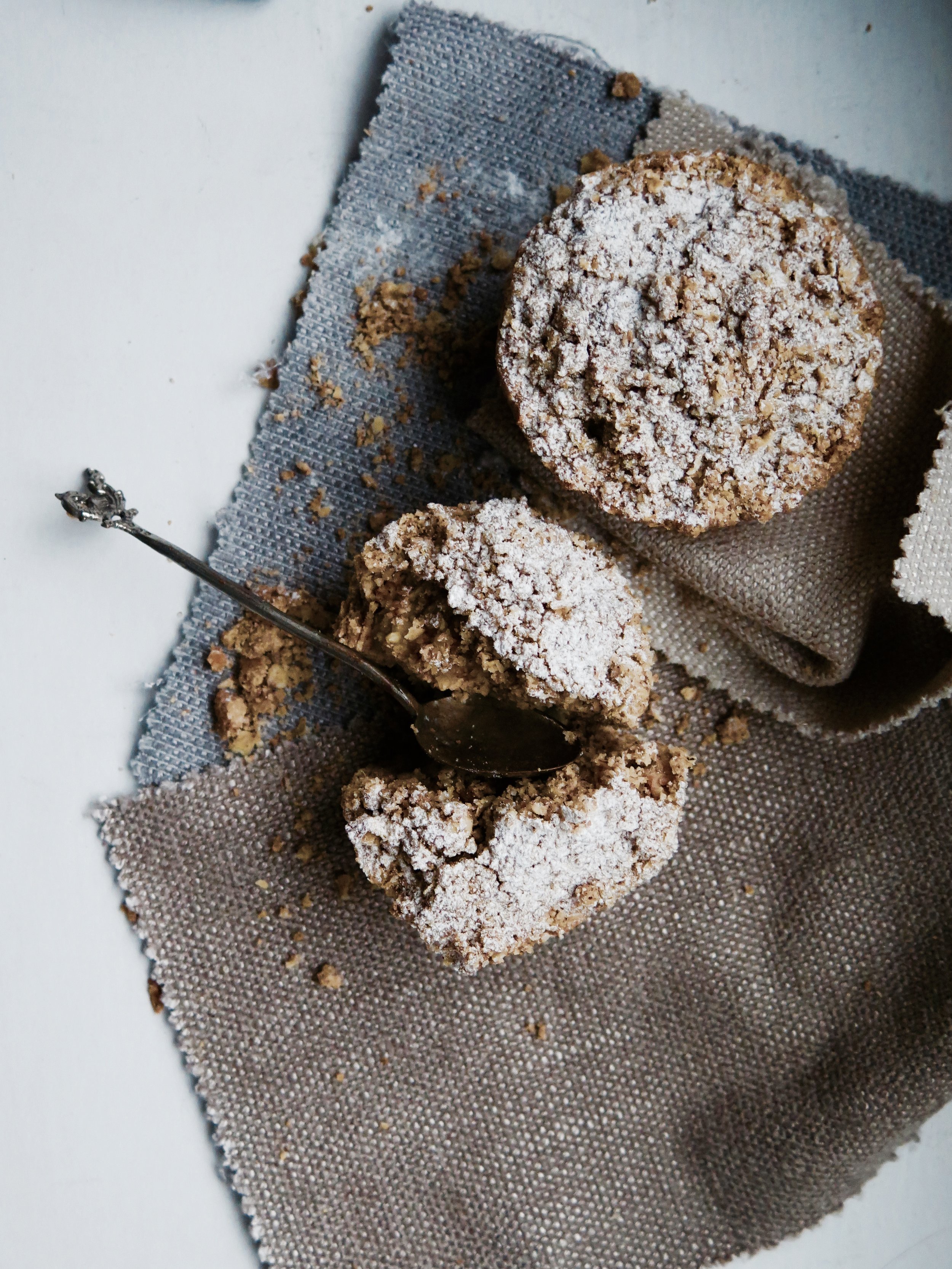 Soft, crunchy, crumbly, fresh, sweet, and on the cusp of sour – the Gail’s Bakery apple crumble cake is what I crave. It’s the ultimate winter treat, although I gaze longingly through the bakery window at them year-round.
Soft, crunchy, crumbly, fresh, sweet, and on the cusp of sour – the Gail’s Bakery apple crumble cake is what I crave. It’s the ultimate winter treat, although I gaze longingly through the bakery window at them year-round.
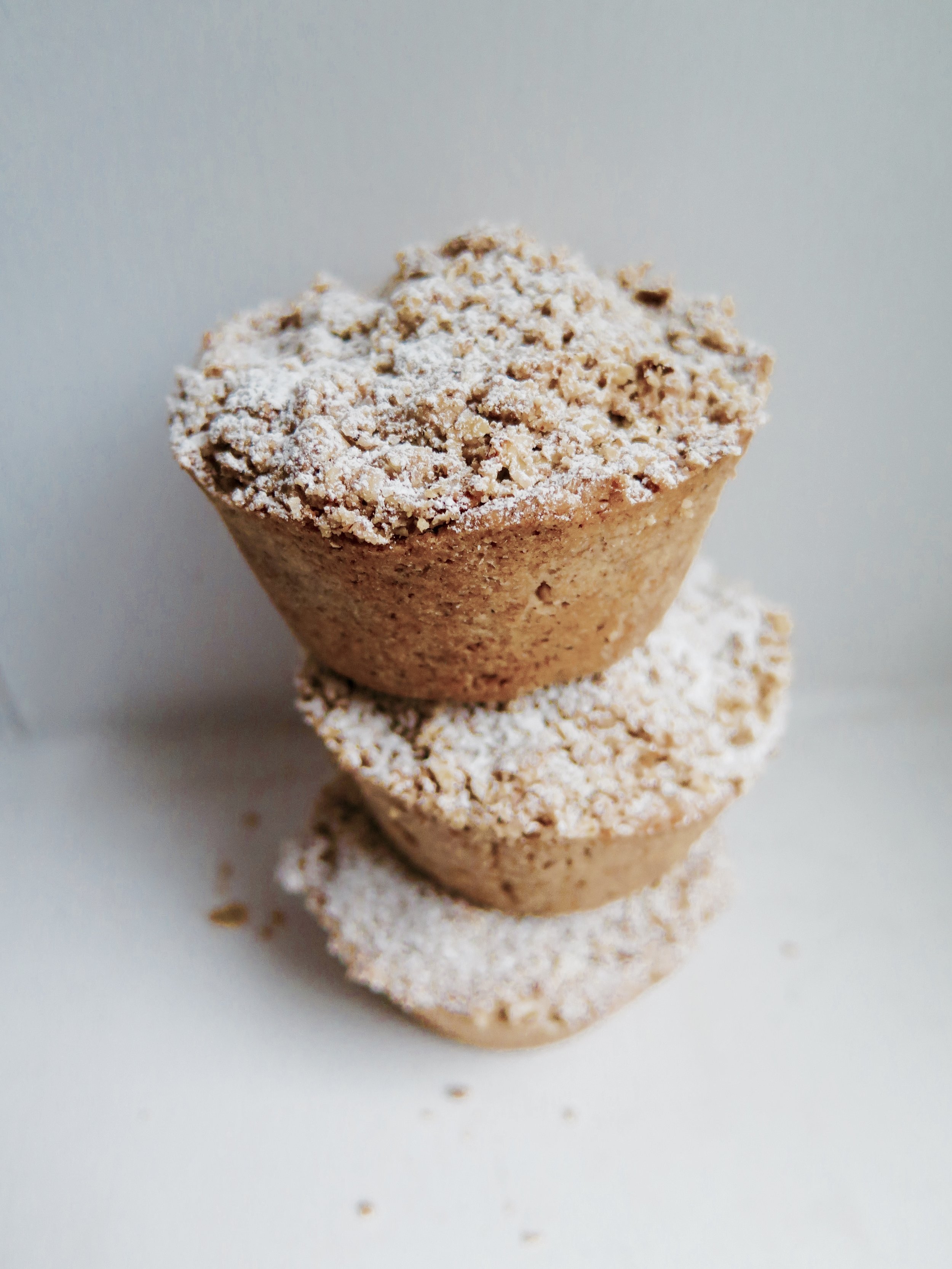
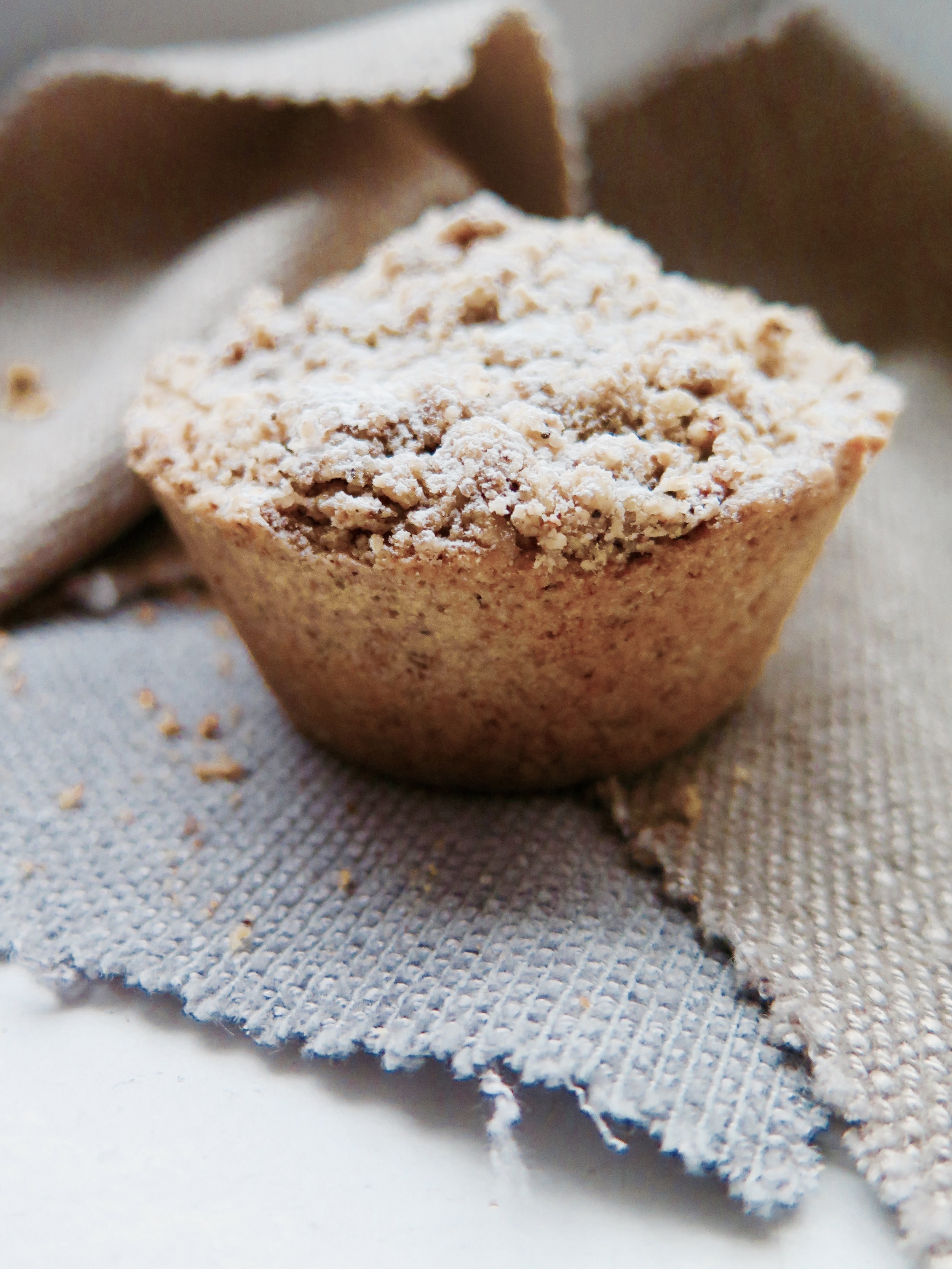 I bought the Gail’s Artisan Bakery Cookbook a few months ago in the hope that they had divulged the secret of their signature apple crumble cake. They hadn’t.
I bought the Gail’s Artisan Bakery Cookbook a few months ago in the hope that they had divulged the secret of their signature apple crumble cake. They hadn’t.
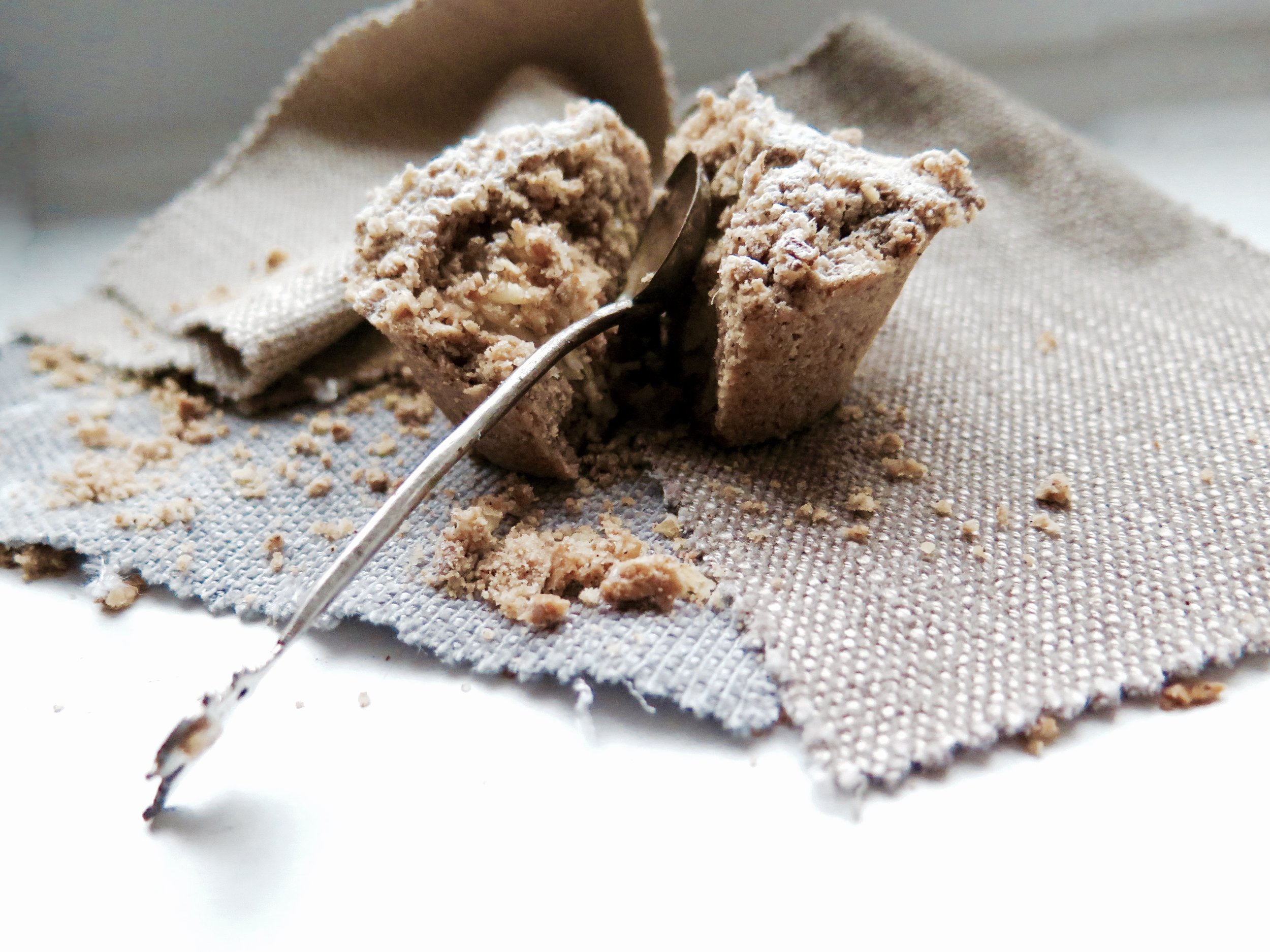
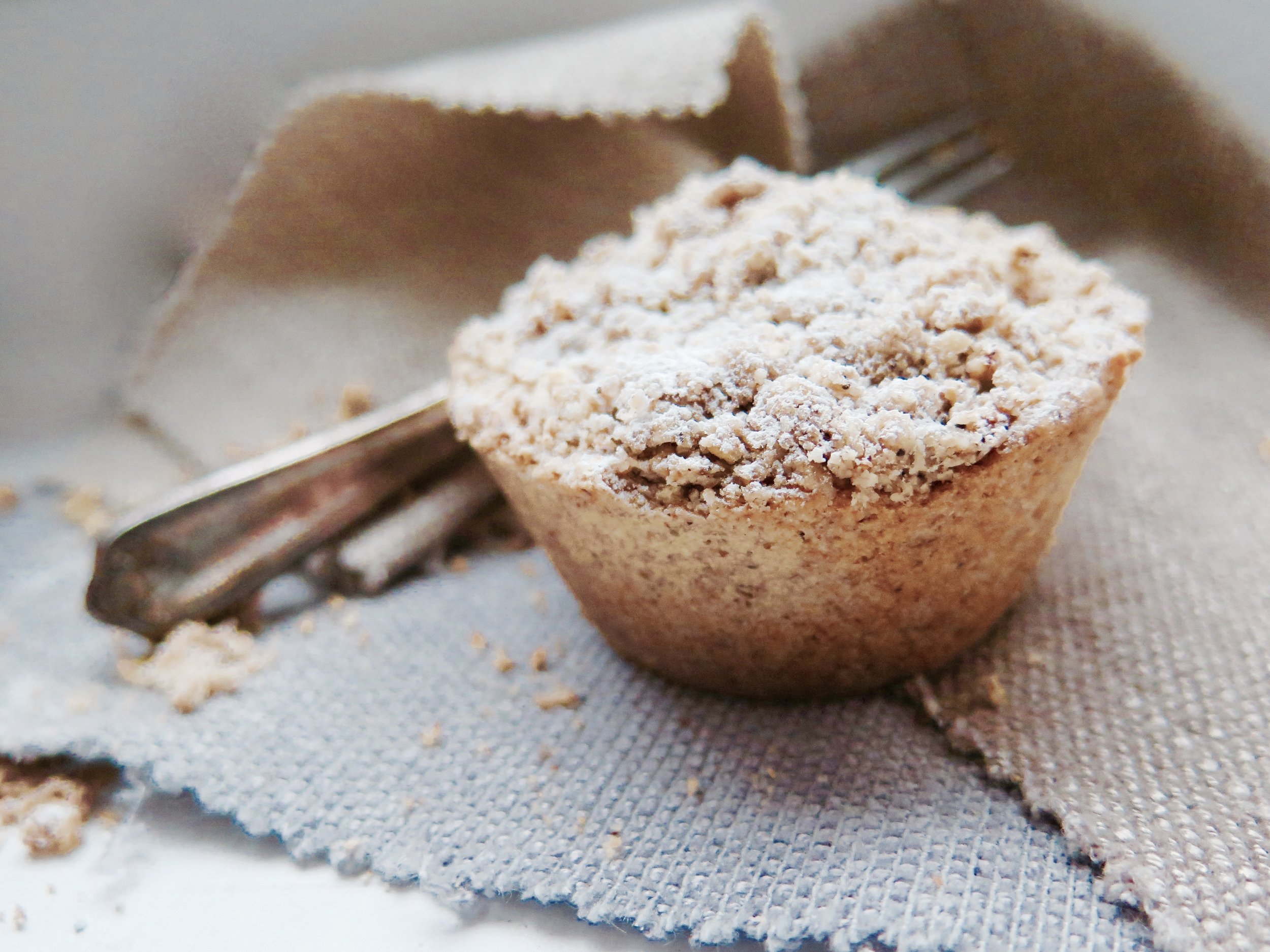
As a result I’ve just had to develop my own recipe – more wholesome, with more cinnamon and less sugar, I’ve heard they may even be superior…
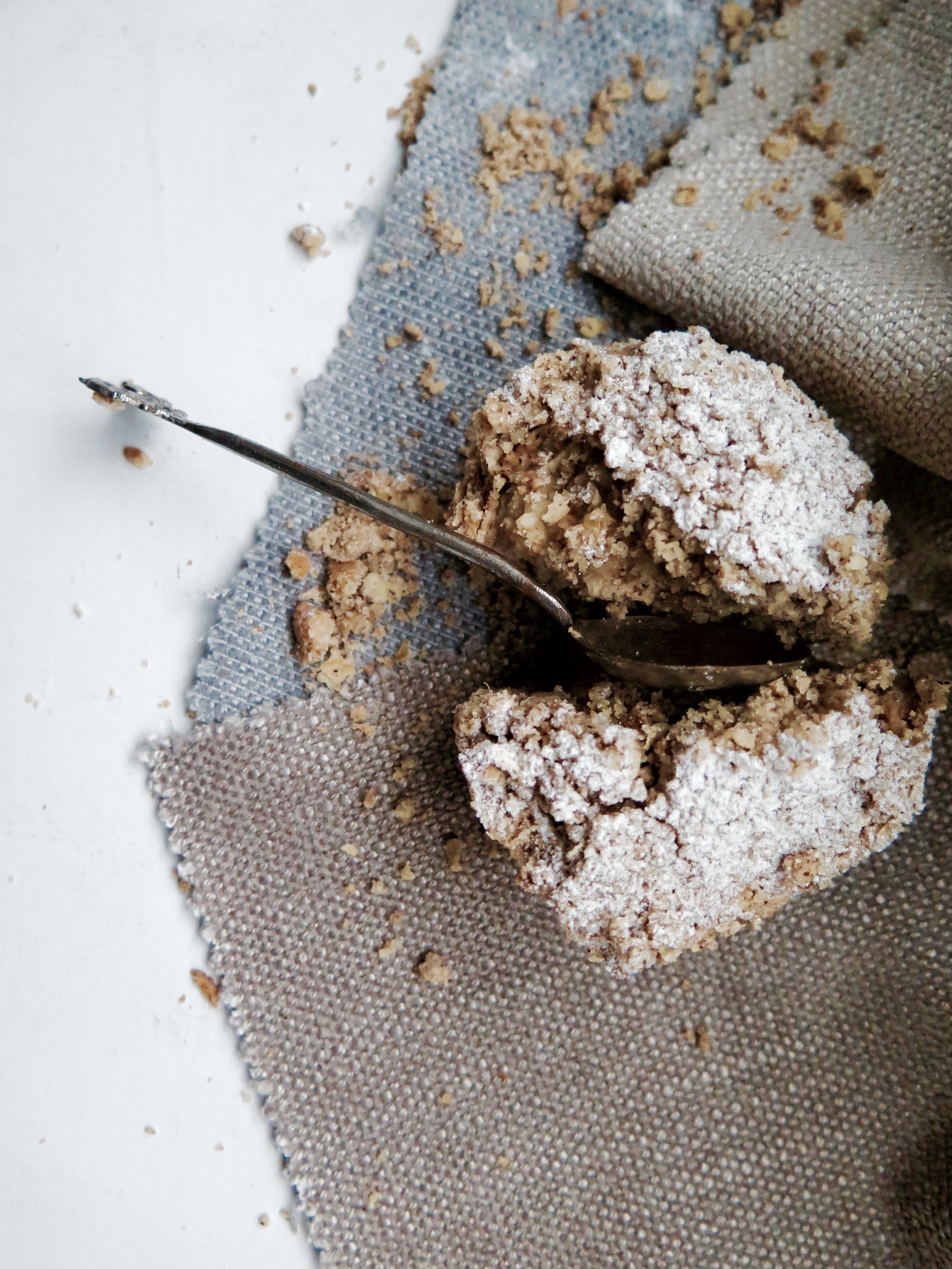
Ingredients
(Makes 15)
Pastry
320g (11.3 oz) wholegrain spelt flour
110g (3.9oz) icing sugar
2 tsp cinnamon
½ tsp salt
165g (5.8oz) butter, roughly chopped into cubes
1 large egg, beaten
Apple Filling
700 (1lb 5oz) grams of peeled, cored and coarsely grated Bramley apples (about 3 large apples)
70g (2.5oz) caster sugar
Crumble topping
80g (2.8oz) wholegrain spelt flour
45g (1.6oz) oats
45g (1.6oz) caster sugar
50g (1.7oz) butter
2 tsp cinnamon
¼ tsp salt
15 hole muffin/cupcake tin, greased (usually they come in 12s, in which case you will need 2 x muffin trays
Method
Pastry
- In a blender, blitz together dry ingredients. Then add in the butter and pulse until the mixture resembles damp sand. Pour in the egg and continue to pulse until the mixture clumps together into a dough. Avoid mixing it more than necessary.
- Flatten the dough roughly into a disc and wrap in cling film or baking parchment. Chill in the freezer while you make the other elements.
Apple Filling
- Place all ingredients in a pan and stir over a high heat for about 5 minutes until the apple turns soft but some texture still remains. Strain the mixture using a sieve, pressing down to get rid of excess liquid (about 250ml, which incidentally tastes like a delicious mulled cider). Set aside to cool.
Crumble
- Place all ingredients in a blender and pulse until the mixture resembles damp sand.
Assembly
- Preheat an oven to 180˚C.
- On a floured surface, roll out the chilled pasty to a thickness of 0.5cm. Cut the pastry into circles with an area similar to that of the muffin tin holes (about 8-10cm), and press each circle in the holes. You may need to patchwork the pieces together.
- Prick the pastry lining the muffin holes with a fork, and bake in the oven for 8-10 minutes, or cooked through and beginning to golden slightly.
- Take the tin out of the oven and spoon 2tbsp of the cooked apple into each pastry shells. Top the cakes by spooning a few tablespoons of the crumb topping over each cake, patting it down and then sprinkling the rest of the mixture over. I like to clump some of it together before scattering it over in order to add further texture and rustic appeal.
- Bake in the oven for 8-10 minutes until the crumble topping is golden and crisp. Serve hot or cold.
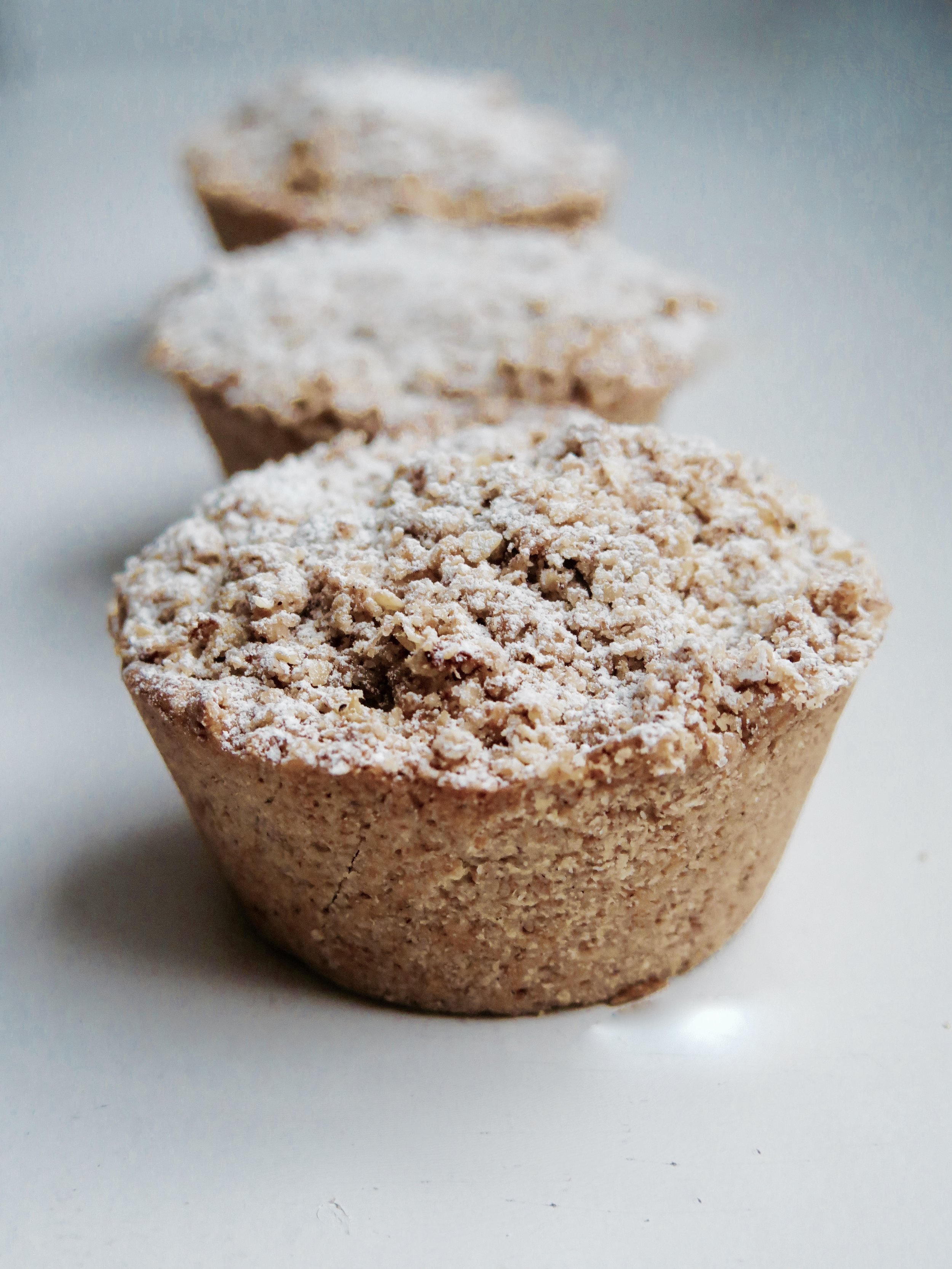
Afternoon tea. What do you think of when someone says those words? Tiers of fluffy isosceles sandwiches, miniature entremets layered with fruit, caramel, and chocolate, and maybe a scone glistening with strawberries. Crisp napkins, high ceilings, the tinkling of fine bone china…
Near where I live there is an Austrian tea room. The window is filled with garish glace cherry- adorned, deflated pastries, crusted squiggles of festering cream, and opera cake melding into a brown sludge. It opened 60 years ago, and the décor and pastries appear not to have been refreshed since.
Inside, it is dark and cramped, and the airless atmosphere is thickened with hot breath and the oversweet smell of fat and sugar.
Their Linzer biscuits, however, remind me of Jammie Dodgers – those jam-filled, shortbread biscuits of my childhood that only other people’s mothers allowed – and inspired me to re- interpret them.
These have a slight Moroccan edge: spiced, delicate with a slight chewiness, filled with the tangy conserve of your choice.
I like marmalade for the tart/bitter contrast against the sweetness of the pastry, but strawberry also works well. Of course, you can go for any shape, but I am rather taken by the cog-like –quirky take on a Jammie Dodger look.
Ingredients
290g (10.125 ounces) white spelt flour (or plain flour if unavailable)
140g (5 ounces) ground almonds
100g (3.5 ounces) caster sugar
¼ tsp salt
2 ½ tsp cinnamon
¼ tsp ground cloves
¼ tsp almond extract
1 tsp grated lemon zest (about ½ lemon)
1 tsp grated orange zest (about ½ medium orange)
225g (8 ounces) unsalted butter
200g (7 ounces) marmalade or jam of choice (I used marmalade and strawberry)
30g (1 ounce) icing sugar
Large and small cookie cutters (I used 7cm and 3.5cm diameter rings)
2 large baking sheets, lined with baking parhcment
Method
- Pour flour, ground almonds, caster sugar, salt cinnoman, cloves,orange and lemons zest, and almond extract into a food processor and pulse until fully combined. Add in the chopped butter and pulse again until the mixture forms a damp sand-like texture. Keep pulsing until it clumps tighter to form a dough.
- Divide the dough into two rounds and flatten both onto sheets of baking parchment, wrap them and place them in the freezer for about 20 minutes or the fridge for an hour.
- Preheat the oven to 160˚C (325˚F). Remove the disks of dough from the freezer/fridge – if they are too firm to roll, let them sit for a few minutes. Ona thoroughly floured board, roll one disk out to a 3mm (1/8 inch) thickness. Cut out as many cookies as possible and set aside the scraps. Space the disks out on the baking trays as you go. Repeat with the second disk and use the smaller cutter to cut out small holes from the rounds. Press together the accumulated scraps and roll out again. Make sure there are an equal number of whole circles to circles with a cut out circle. A tip to avoid the cutter sticking in the dough is to dip it in flour first.
- Place the trays in the oven and bake for 12- 15 minutes until the cookies are golden but still soft to the touch – they will continue to cook as they cool. When cool, for aesthetic effect, sieve the icing sugar onto the rounds with the circles cut out of them. Then spread a teaspoon of the jam/marmalade onto the complete circles, and lightly press the cut-out layer on top. Devour, delicately, of course…
'Oats: a grain, which in England is generally given to horses, but in Scotland supports the people’ Samuel Johnson, The Dictionary of the English Language, 1755
If I were the type of person that leafed (ironically) through Cosmo, and stumbled across one of those lazy, page-filling content, tree diagrams which happened to ask “what is your spirit animal?”, I know what mine would be. A horse. Well, at least that’s what it would have been during the second year of my time at university in terms of comestibles…
Essay crises necessitate fuel in order to feed the adrenaline and, for me, that fuel came in the form of oats.
When you have a 9 am deadline approaching, and there is only one hour remaining, every minute is precious - so there is no time to spare for cooking oats over the hob until they break down into a creamy mulch.
That’s the excuse I gave myself. Instead, I developed the rather grotesque habit of eating oats straight from the packet, raw and desiccated. In my maddened and pressured state, I savoured the clagginess of the oats, where you can’t quite conjure up enough saliva to swallow them. Ideal.
I have since moved on from this stage (with the very occasional relapse) to a more acceptable way of dealing with my love of oats: Bircher muesli, invented by Bircher Benner, a pioneer of raw foodism, in the late 19th century as a way of curing his jaundice. It worked.
I feel, somewhat justifiably, that it runs in my blood (thick & creamy): my great-great-uncle was a frequent patient at Benner’s rather avant garde Swiss raw food clinic and, one sunny day, he stepped down from a plane on an impromptu visit from Scotland to South Africa with no clothes besides the ones on his back, a vegetable juicing contraption which he trailed behind him on a rickety little cart, and a proselytising passion for Bircher muesli.
I have tried many a Bircher muesli, from Swiss versions to Vietnamese attempts, but I feel I have concocted the ultimate version (excuse my arrogance). Creamy, healthy, juicy, and exotic, it’s effectively manna, and I would happily have it for every meal of the day (jaundiced or not).
The Best Bircher Muesli (Serves 5)
Ingredients
2 Braeburn apples, grated
Juice of 1/2 lemon
200ml orange juice
200g natural yogurt
200g almond and coconut milk (can be substituted with dairy or non-dairy alternatives)
3 tbsp maple syrup
1 tsp vanilla bean paste (if you can’t get hold of this, omit it, or substitute with ½ tsp vanilla extract)
50g desiccated coconut, lightly toasted in a pan on a low heat until pale gold)
200g porridge oats
Pinch of salt
200g of fresh fruit of your choice (blueberries, strawberries, raspberries, figs, sliced banana work well)
40g coconut chips (optional but adds great texture)
Method
- In a large bowl mix together all the ingredients apart from the fresh fruit and optional coconut chips. If you are making this the night before, cover the bowl with cling film and place in the fridge overnight to let the oats soak up the flavours. If you are serving the muesli immediately, stir the mixture for a couple of minutes to break down the oats until they are creamy.
- If you are leaving the muesli overnight, allow it to come to room temperature before serving. Scatter mixed berries and fruits and coconut chips over the top and serve.
How to bake and stay (reasonably) in shape.
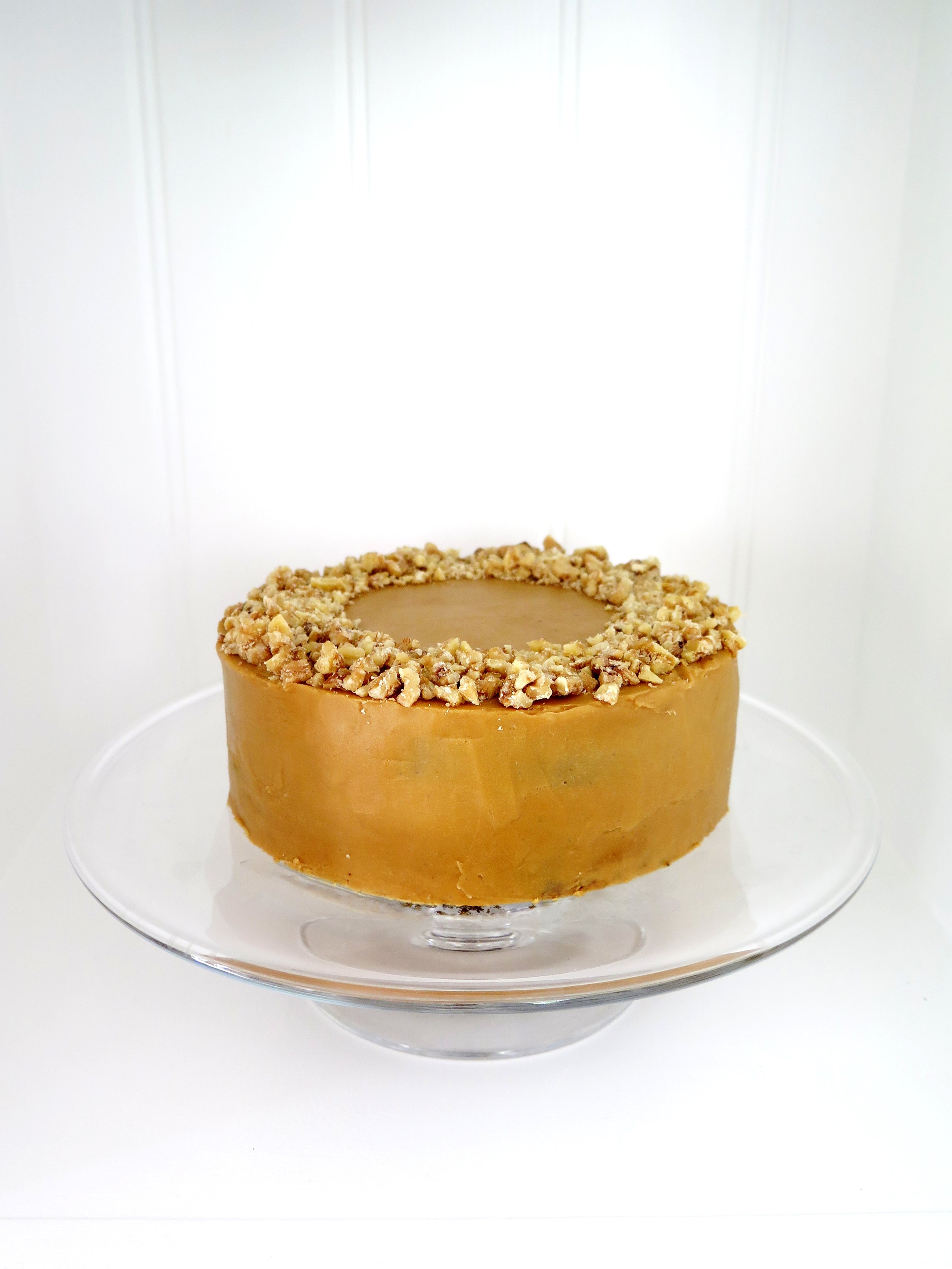
I am often asked how it is that I am not obese. I am by no means super skinny, but people wonder how I avoid rolling around the place when I am seemingly baking the whole time and have little resistance to delicious things. So, here’s my secret. Have a go.
What I need: a running machine; a radio; an oven; a timer
What I do:
Pour the batter into the cake tin, lovingly smooth the surface over with a spatula. One lick of the spatula before it goes in the sink (just a little indulgence). Carefully open the oven door, and bend down slowly so that the batter remains level. Place the cake tin tenderly on the rack. Set the oven timer. 22 minutes. Then GO.
Run up the stairs, two at a time. That’s one minute either side to rush back down. Turn up the radio. Leap on to the treadmill, and run. 10 mph minimum. 20 mins to go. Sweat, pound, sweat. 15 mins. Beyoncé’s screaming. Oven beeps. Run back down (Beyoncé’s mumbling). Open oven door, skewer the cake. Damn - not cooked. Rip out a sheet of tin foil. Cover the cake. Burn hand. Set timer: 7 mins more. Repeat process until skewer comes out clean. Place cake on rack and allow to cool.
Stretch and shower.
Hover over the cake with a knife.
You can make the cake sans-icing by simply halving the recipe and, before serving, dusting with a little icing sugar.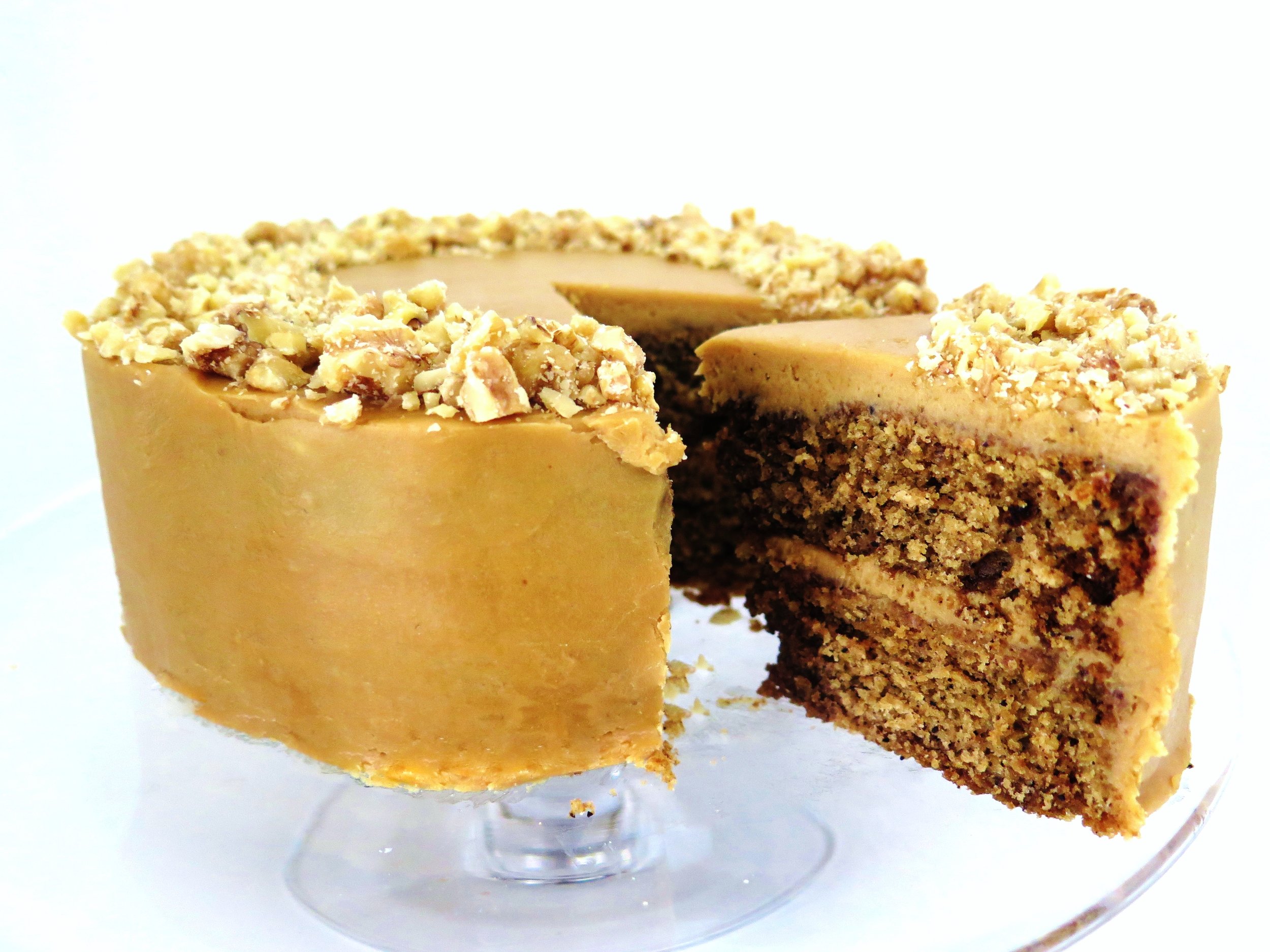
Ingredients
Cake
200g butter, at room temperature
170g caster sugar
30g light brown muscovado sugar
2 tbsp ground coffee
¼ tsp salt
70g toasted walnuts, ground to a fine sand
4 large eggs, beaten
1 tsp vanilla extract
1 ½ tsp instant coffee, dissolved in as little hot water as possible to make a smooth paste
240g self-rising flour, sieved
2 x 8 inch cake tins, greased and with bases lined with a circle of baking parchment
Coffee Syrup
40g golden syrup
50g caster sugar
2 tbsp instant coffee
100ml boiling water
Coffee Icing
300g butter, at room temperature
450g icing sugar
1 ½ tsp vanilla
2 tbsp instant coffee dissolved in as little hot water as possible to make a smooth paste
¼ tsp salt
Caramelised walnuts
60g walnuts
2 tbsp caster sugar
3 tbsp water
Method
- Preheat oven to 180˚C. Using an electric mixer, or with a vigorous hand, in a large bowl beat together the butter, caster sugar, muscovado, ground coffee and salt until light and fluffy.
- In a separate bowl, beat together the eggs, vanilla and dissolved instant coffee. Beat this into the butter-sugar-coffee-salt mix. Once combined, stir in the ground walnuts.
- Finally, gently fold the sieved flour into the mixture, being careful not to overbeat. Divide the mixture between the two tins and place in the oven to bake for 25 minutes (checking after 20) or until a skewer comes out clean.
- While the cakes are baking, make the coffee syrup. Dissolve the instant coffee in the water and pour into a small pan along with the syrup and sugar. On a medium high heat, stir until the sugar has dissolved, then allow to simmer for 5 minutes or until it thickens slightly to the consistency of maple syrup.
- Remove cakes from oven. Stab them all over with a cake tester or skewer, and spoon the syrup equally over the two cakes. Set aside on a rack and allow to cool.
Icing
- Beat together butter and icing sugar. Once combined, beat in the vanilla, coffee and salt.
- Remove the cakes from tins, place one on the serving plate and spread ¼ of the icing on its surface. Place the other cake on top and spread the icing evenly over the cake.
Caramelised Walnuts
- In a shallow pan, over a medium-high heat, stir together water and sugar until the sugar has dissolved. Then pour in the walnuts, and continue to stir and coat them until all the water has evaporated. Decant them on to a sheet of baking parchment, and allow them to cool.
- Once cool, chop roughly, and scatter as desired over the cake.
Is it just me, or is anyone else sick of logging on to Facebook, innocently hoping to drain away half an hour of one’s day (minimum) by looking at pictures of people one may or may not have half met once trying to prove how much fun they are having by posting pictures of themselves with friends/family, strained smiles stretched across their faces, and who are clearly not that immersed in the fun as they have had to spend half an hour trying to get one decent picture out of the hundred they’ve taken to emblazon it across their Facebook wall and maybe, just maybe, turn it into a cover photo?
And then – BAM - your gaze is diverted,
and you are staring down into the depths of a garishly coloured plastic bowl filled with some unidentifiable artificial gunk, pink fleshy hands massaging some other substance into it to form some putty-like emulsion which is then mushed and squeezed and squidged into a plastic mould, whizzed up, and extruded through a bag and…… oh look, it’s that Gooey Oreo, Jellied Eel and Green Marshmallow Mini Coffee Cup that “you’ve always wanted to make for your slumber party with the gals”.
Here’s an antidote. It is simple yet sophisticated, humble yet sumptuous, tangy but not cloyingly sweet, and light yet not so light when you’ve had 4+ pieces….
Ingredients
Pastry
200g white spelt flour (can be substituted with plain flour)
100g butter, roughly cubed
2 tbsp icing sugar
¼ tsp salt
1 small egg, beaten
12 x 36cm tart tin, greased and dusted with flour
Blueberry filling
800g frozen blueberries
250g caster sugar
1 tsp cinnamon
½ tsp nutmeg
2 tbsp cornflour
Zest of ½ medium sized orange
Method
- Place flour, butter, icing sugar and salt in a food processor, and blitz until it resembles damp sand. Pour in the beaten egg, and pulse until the mixture combines to form a soft dough. Remove from the processor, wrap in baking parchment and place in the fridge for half an hour (or freezer for 10-15 minutes) – this will prevent the dough from shrinking when it bakes.
- Preheat the oven to 180˚C. Lightly dust a surface with flour and roll out the dough in a rough rectangle to 0.5cm thickness. Roll the pastry around a rolling pin and transfer to the tin, pressing it into the fluting (if, indeed, your tin is fluted). Run a knife along the top edge of the tin to remove excess pastry. Prick the base of the pastry a few times with a fork, and place back in the fridge for 30 minutes (or freezer for 10 minutes).
- Prepare the pastry for blind baking by lining the inside with a sheet of tin foil and filling it with baking beads to weigh it down while it bakes and to prevent it from shrinking. Place in the oven for 15-20 minutes until the pastry is dry and beginning to turn golden. If it is cooking too slowly, you can remove the beads and tin foil after 15 minutes and continue to bake. Remove from oven and set aside to cool.
- To make the spiced blueberry filling, place a large pan over a high heat and pour in all the ingredients. Stir continuously until the sugar is dissolved in the juice that runs off the blueberries. When the mixture begins to boil, reduce the heat to medium-high and allow to simmer for 20-30 minutes, stirring occasionally to prevent it from catching, until the liquid is almost completely reduced and with the viscosity somewhere between a syrup and a jam. Allow to cool to room temperature, then pour into the pre-baked pastry case.
Passion Fruit & Coconut Double Chocolate Truffles

My household has recently been beset by a typical problem. My mom rather enjoys pressing the "+”button when ordering from Ocado. Whereas last week this resulted in a glut of cherries, this week it was passion fruit. Even after days of bisecting the plum-coloured orbs and slurping up the tangy yellow spawn (sans spoon, and only in the most ladylike way, obviously), the supply remained steady.
 Clearly, truffles were the solution. Most truffle recipes create a molten ganache centre by simply combining melted chocolate with the flavour/ingredient of choice and a dribble of cream. Easy? Perhaps. Zero depth of flavour? Indeed. I make a caramel base to add a darker, nuttier complexity.
Clearly, truffles were the solution. Most truffle recipes create a molten ganache centre by simply combining melted chocolate with the flavour/ingredient of choice and a dribble of cream. Easy? Perhaps. Zero depth of flavour? Indeed. I make a caramel base to add a darker, nuttier complexity.
This is poured over the dark chocolate to melt it, and the golden toasted coconut is then swirled in with the fresh and tangy passion fruit juice.
I recommend using good quality dark chocolate – the results are worth it. The tangy molten ganache is then frozen, later to be formed into spheres. These are encased in a crisp white chocolate and coconut shell to add a touch of sweetness and contrast of textures.
The name “passion fruit” does not, as you might assume, come from any aphrodisiac qualities of the fruit. Rather, it comes from the shape of flower which resembles a crown like that that of thorns around Jesus’ head – thus, passion derives from the "passion of Christ”. Indeed, these truffles are rather ambrosial – you could even say that eating them is a religious experience.
Ingredients (makes 50 - halve if strapped for time)
For the Ganache
150g 70% dark chocolate (good quality)
150g caster sugar
150g double cream
10g unsalted butter
10g light brown muscovado sugar
½ tsp salt
70g desiccated coconut
8 passion fruits, sieved to extract about 90ml of juice.
100g icing sugar, sifted
Large tray lined with baking parchment
For the shell
500g white chocolate
200g desiccated coconut
Pair of surgical gloves (optional)
- Chop the dark chocolate roughly, and set it aside in a large heatproof mixing bowl.
- To toast the coconut (70g), place a medium frying pan over a medium-high heat, pour the coconut in and stir continuously for 5 -8 minutes until the coconut turns a light golden colour. Add this to the dark chocolate.
- Place the caster sugar in saucepan over medium high heat, and when it starts to melt, stir gently with a spatula to avoid the sugar burning around the edges. Push unmelted sugar into the already caramelised sugar to aid the caramelising process.
- Once the sugar has turned a rich, dark gold colour, while still on the heat, pour in the cream, whisking all the time. If clumps form, don’t panic: keep whisking over medium low heat, and they will eventually melt.
- Once the lumps have dissolved, whisk in the muscovado sugar, butter, vanilla and salt and stir the bubbling mixture on a medium heat for another 2 minutes.
- Pour the hot mixture into the bowl of chopped dark chocolate and coconut and stir immediately until all the chocolate has melted and the caramel and chocolate are fully combined. Pour the passion fruit juice into the mixture, and stir to combine fully. Pour this into a shallow tray, and place in the freezer for an hour to set slightly.
- Once it has become slightly more solid, remove the tray of mixture from the freezer. Use a teaspoon to scoop out dollops, and roll each between the palms of your hands to form 2cm diameter spheres. Roll the spheres in the icing sugar to coat them finely, and then place them on a baking tray with space around each sphere to avoid their sticking together. Once all the mixture has been rolled into spheres, place the baking tray in the freezer for half an hour or until the spheres are firm and cold to touch. You may need to do this in batches as the ganache mixture melts very quickly.
- Break half the white chocolate (250g) into pieces and place in a bone-dry, heatproof bowl (any drop of water will make the chocolate seize). Place the bowl over a pot of boiling water (without the boiling water touching the base of the heatproof bowl), and stir occasionally until the chocolate is melted.
- Remove the dark chocolate spheres from the freezer, and one at a time, skewer with a toothpick and coat by spooning the melted white chocolate over each frozen chocolate sphere. Remove the skewer, replace the coated truffle on the baking tray, and replace in the freezer for 10 minutes for the first layer to set.
Melt the rest of the white chocolate (using the same method as before), and place the desiccated coconut (200g) in a bowl. Remove the truffles from the freezer. If you don’t want to get too messy, wear surgical gloves to do this stage. With one hand, roll the truffle in the melted white chocolate. Then, drop it into the coconut and with your other hand roll it to coat it. Once the batch is complete, place back in the freezer for a minimum 10 minutes to set.
I never caught on to the Disney hype – I endured a few of the films when I was younger but was never enthralled by its saccharine princesses and unrealistic princes. I rejected the dressing up stage of childhood, and have none of the nostalgia that is awakened in many when hearing or singing the songs. My only knowledge of Lion King is from Cindies (arguably the stickiest night club in Cambridge) which is played for 30 seconds without fail every Wednesday evening to excite the Disney addicts and to jolt inebriated students out of their drunken kisses.
What I did love was the sugar-glazed brutality of the original Charlie and the Chocolate Factory film.
I adored the Chocolate Room, and my six year old self spent a lot of time fantasising about edible wallpaper and edible TV adverts. However, the first scene, where Augustus Gloop falls into the ‘chocolate’ river, is almost too painful to watch.
It was concocted using 150,000 gallons of water, real chocolate and real ice cream, yet despite its authenticity, its watery thinness is more the stuff of sewers than of dreams.
If I were going to bathe in chocolate it would need to be velvety, glossy and thick… and after 15 years of dwelling on this I’ve come to terms with the fact that this tart is probably the closest I will get to doing that.
Ingredients
Chocolate pastry
225g plain flour
30g cocoa
150g unsalted butter, chopped into cubes
110g white caster sugar
3 egg yolks
¼ tsp salt
1 tsp vanilla extract
1 tbsp ice water
baking beads/uncooked rice/dry beans
4 fresh figs, halved (optional)
12 x 36cm tart tin, greased and dusted with flour
Salted caramel chocolate ganache
300g 70% good quality dark chocolate
300g white caster sugar
300ml double cream
20g light brown muscovado sugar
20g butter
1tsp vanilla extract
1 tsp salt
Pastry Method
- Preheat the oven to 200˚C
- Blitz all the ingredients in a blender. Pulse until into turns into a damp sand texture. Tip out on to a surface and press it so that it clumps together into dough. Wrap the dough in baking parchment and put it in the fridge for an hour, or in the freezer for 15 minutes.
- Dust a surface with flour and roll the pastry out in a rectangle to a thickness of 0.5cm. Any excess can be frozen and used within 2 months. Transfer the pastry to the greased and floured tin to line it. Don’t panic if it crumbles in the transition, just patchwork it together in the tin. Place a sheet of baking parchment or tin foil over the pastry, and fill it with the baking beads to weigh it down to prevent the pastry from shrinking as it cooks.
- Place it in the oven to bake for 10 minutes. Remove from the oven and remove the baking parchment and baking beads. Reduce the oven temperature to 150˚C, and place the pastry back in to bake for a further 10-15 minutes until it is fully cooked. Set aside to cool.
Salted Caramel Chocolate Ganache Method
- Chop the dark chocolate roughly, and set it aside in a heatproof mixing bowl.
- Place the caster sugar in a saucepan over medium high heat and, when it starts to melt, stir gently with a rubber spatula to avoid it burning around the edges. Push any unmelted sugar into the already caramelised sugar to aid the caramelising process.
- Once the sugar has turned a rich, dark gold colour, while still on the heat, pour in the cream whisking all the time. If clumps form, don’t panic: keep whisking over medium low heat, and they will eventually melt.
- Once the lumps have dissolved, whisk in the muscovado sugar, butter, vanilla and salt, and stir the bubbling mixture on a medium heat for another 2 minutes.
- Pour the mixture into the bowl of chopped dark chocolate and stir immediately until all the chocolate has melted and the caramel and chocolate are fully combined.
- Pour into the tart shell, smooth the surface over with a palate knife, and place this in the fridge for an hour (or freezer for half an hour) to set. Decorate with sliced figs to serve.

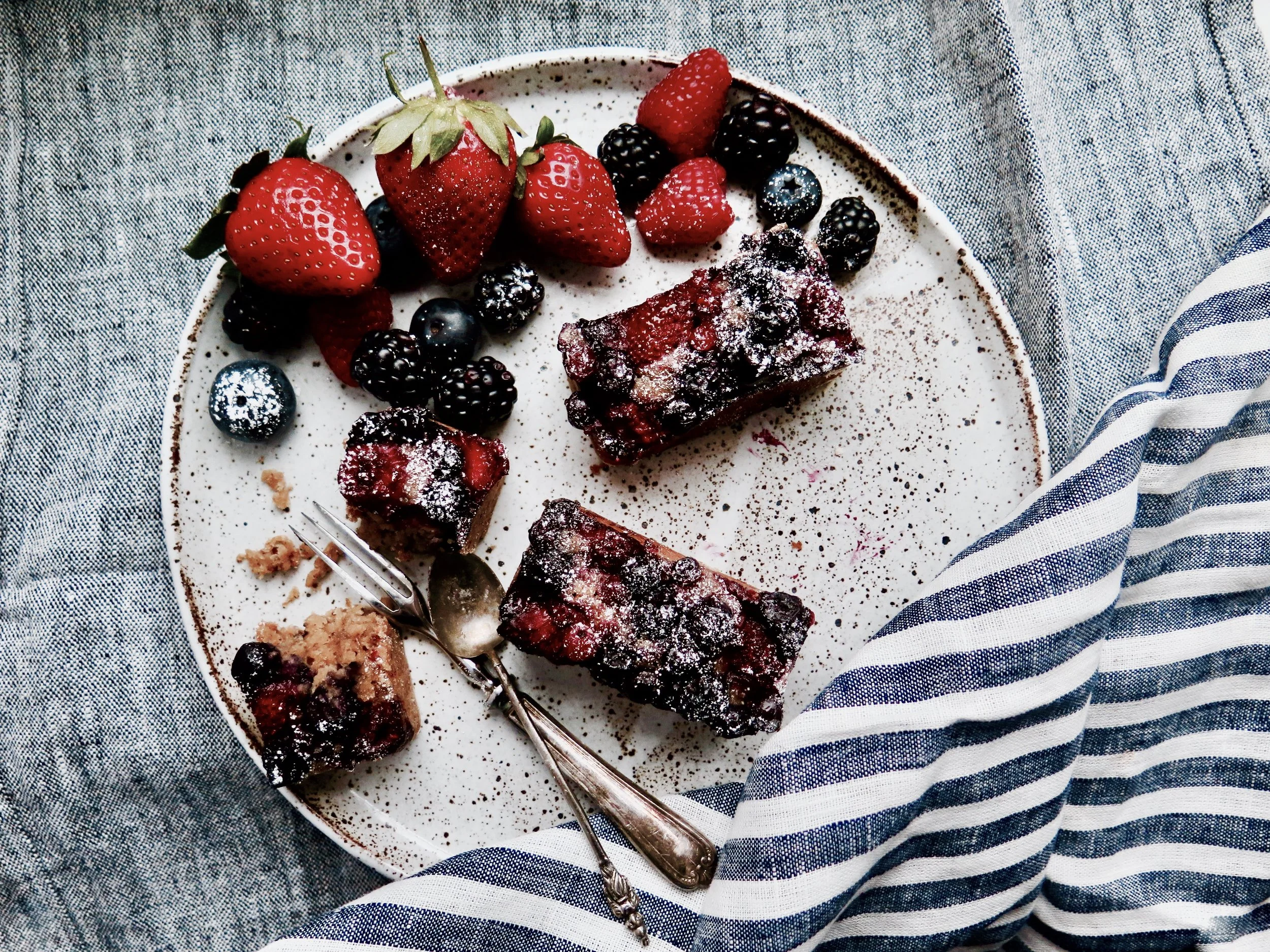


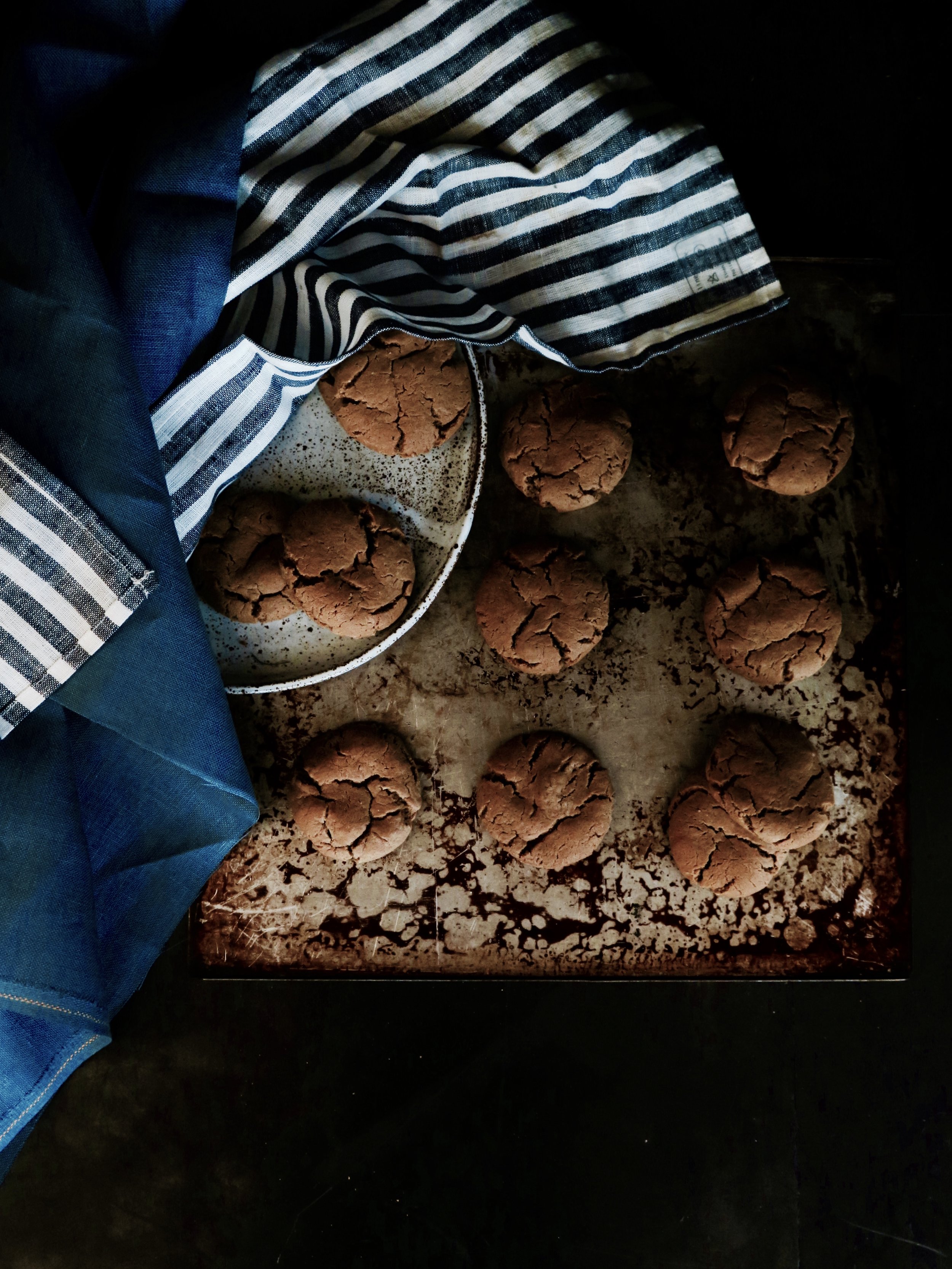

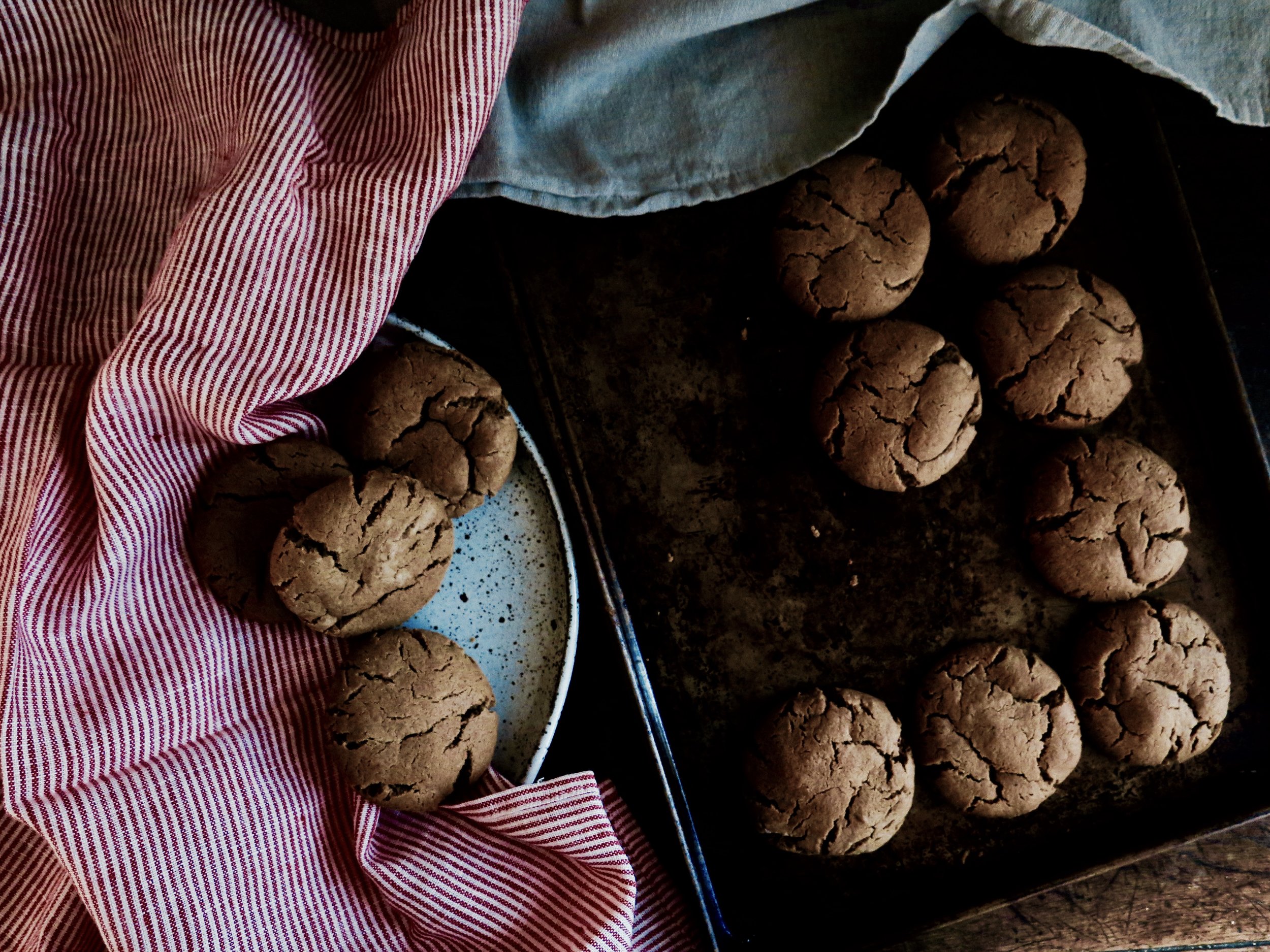




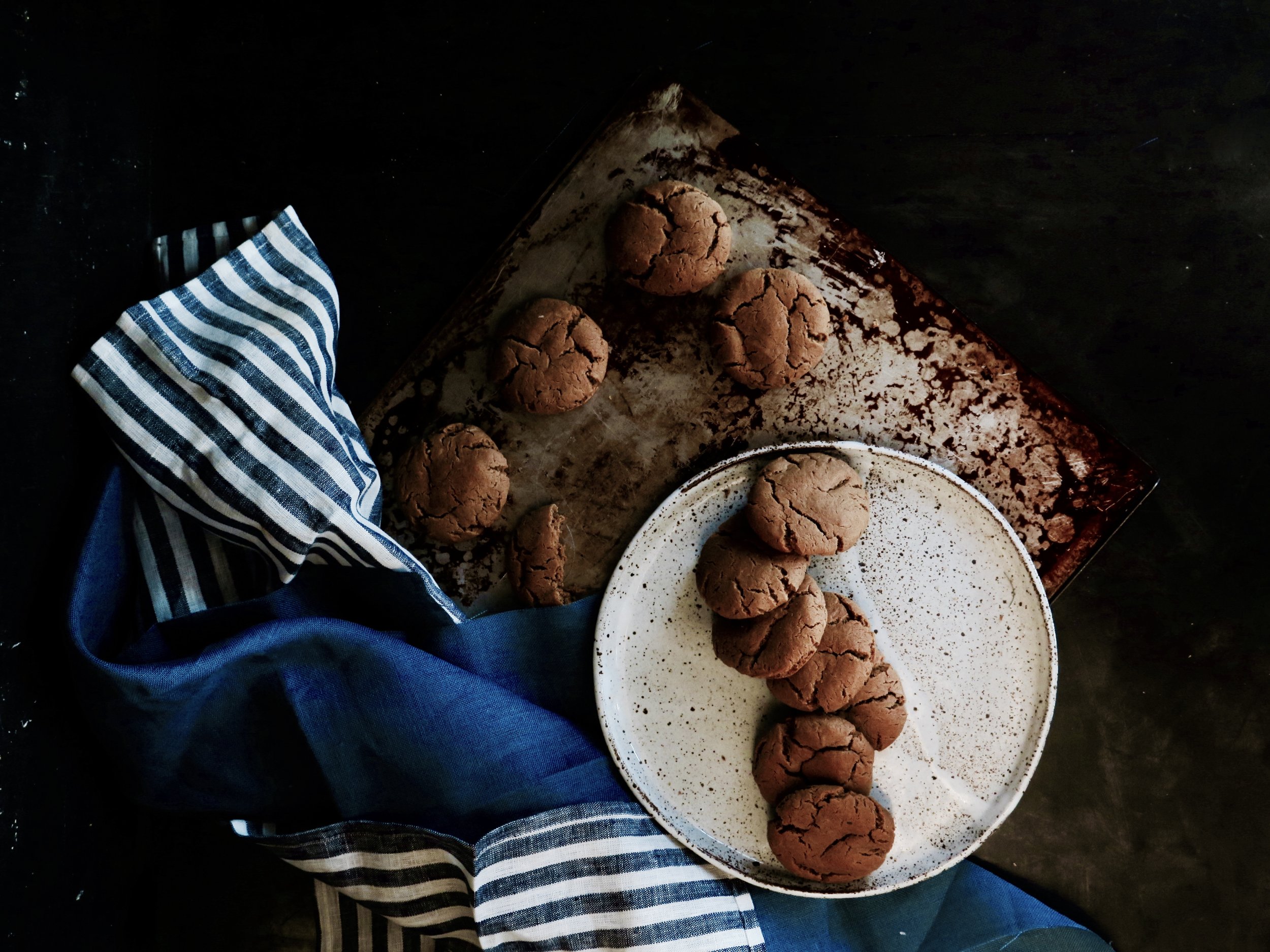



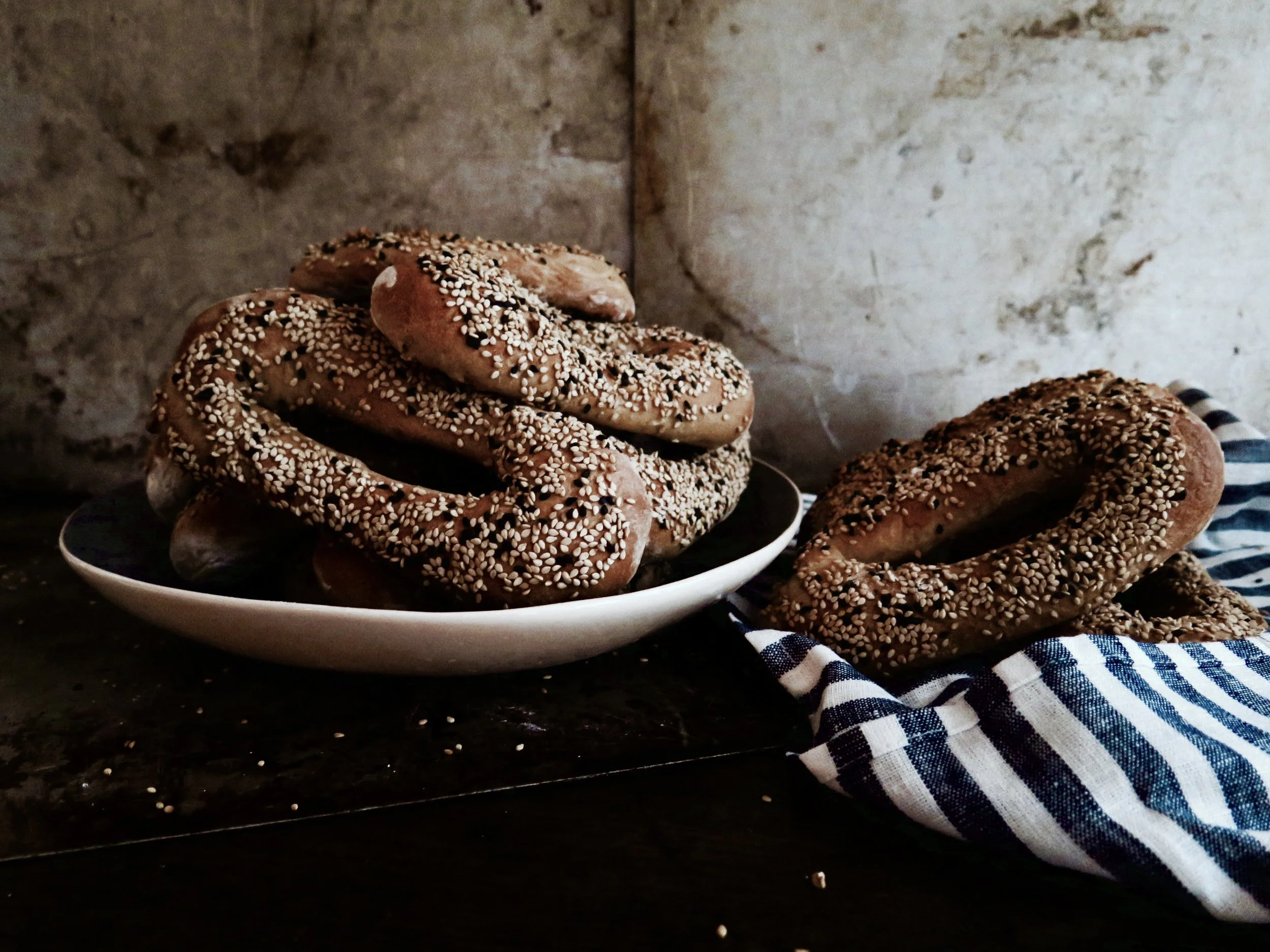
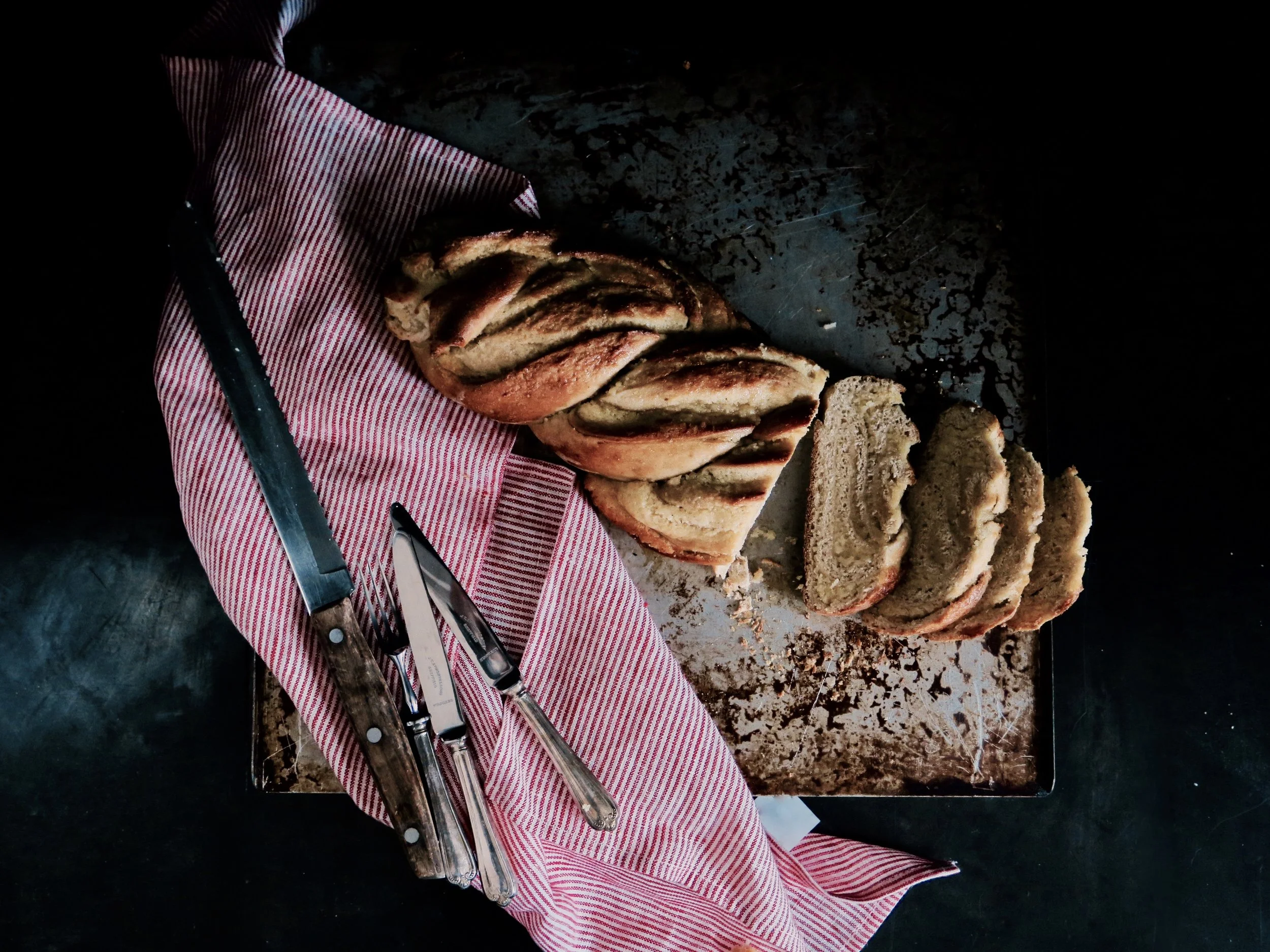
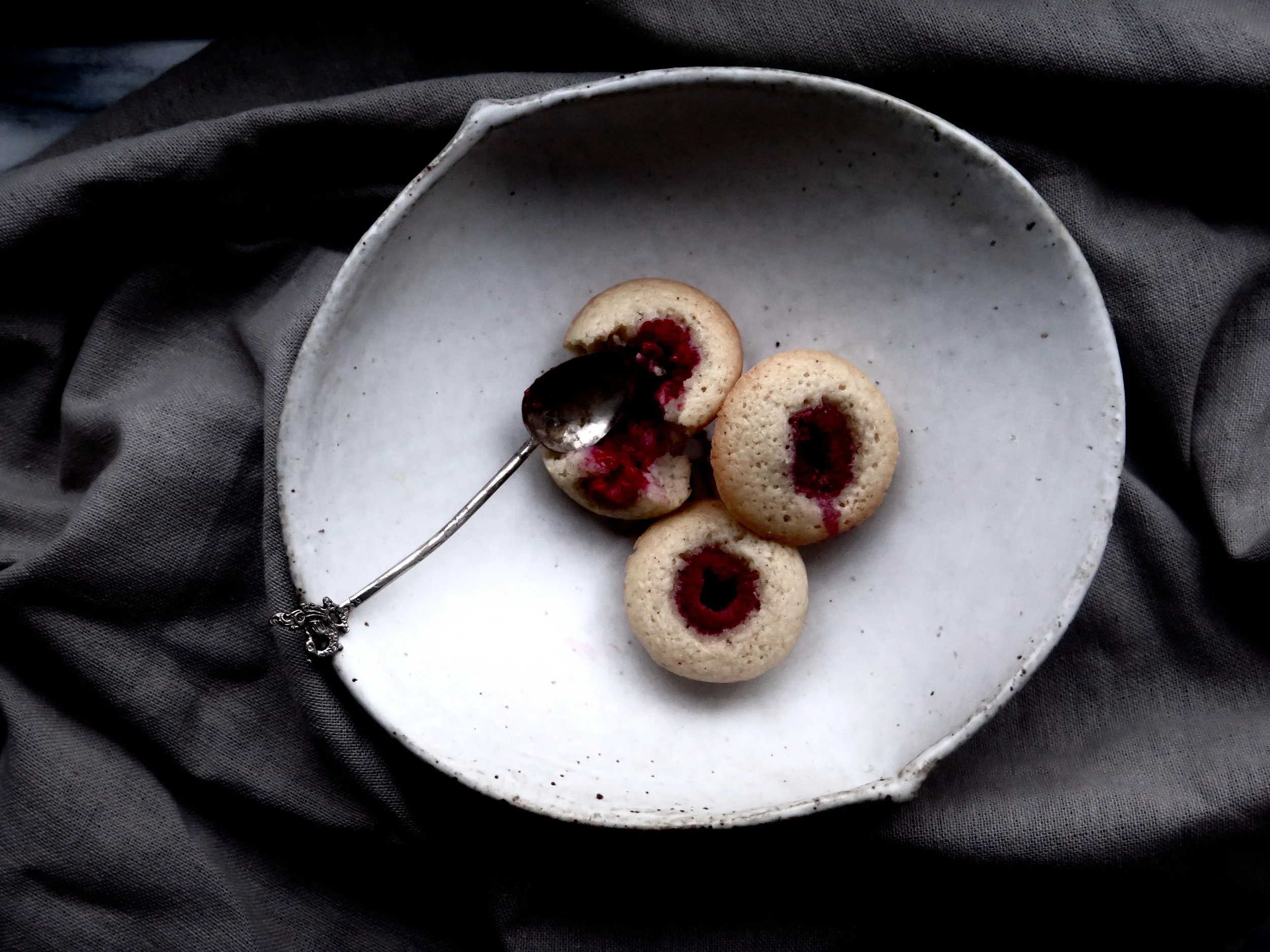
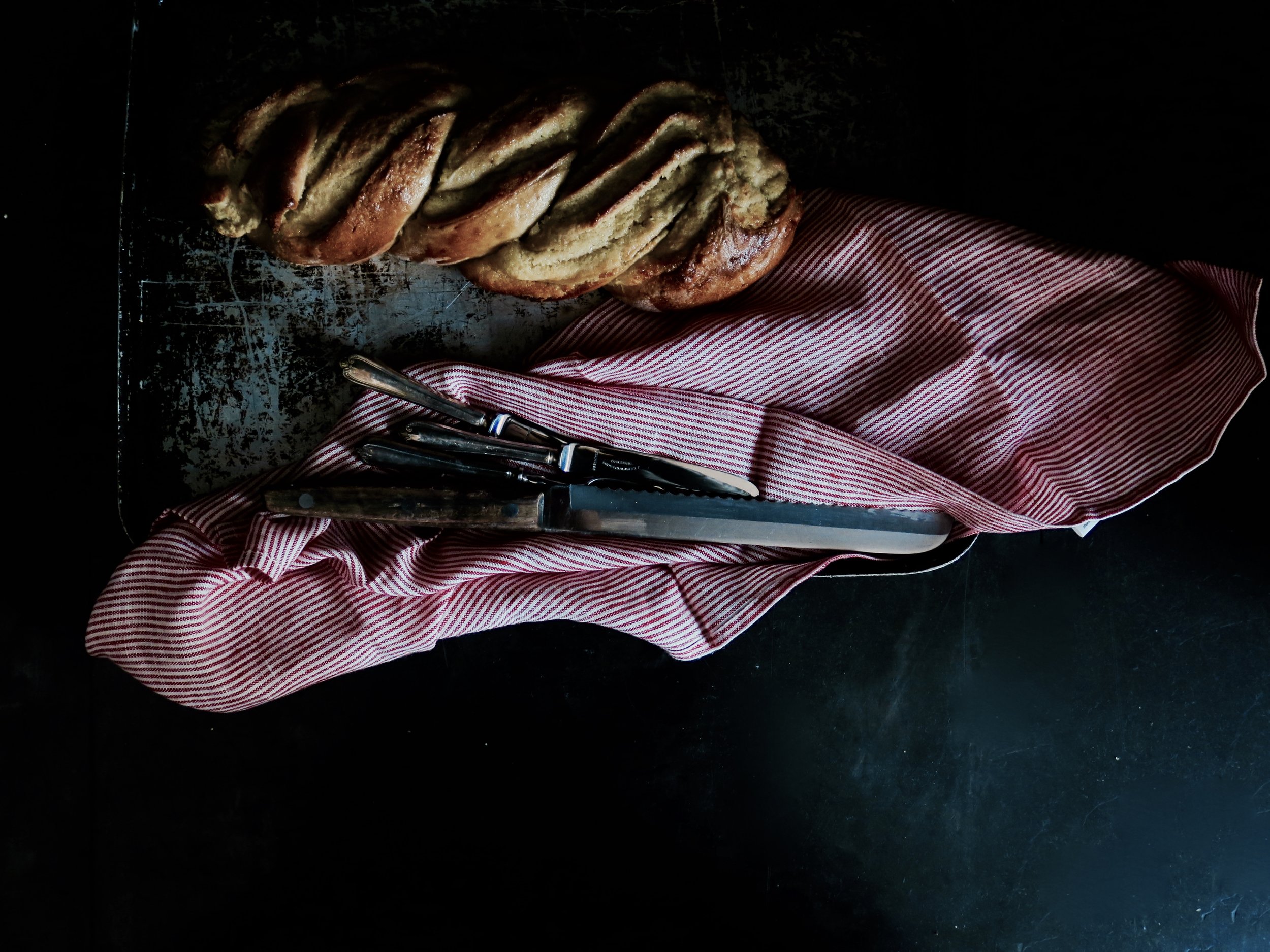










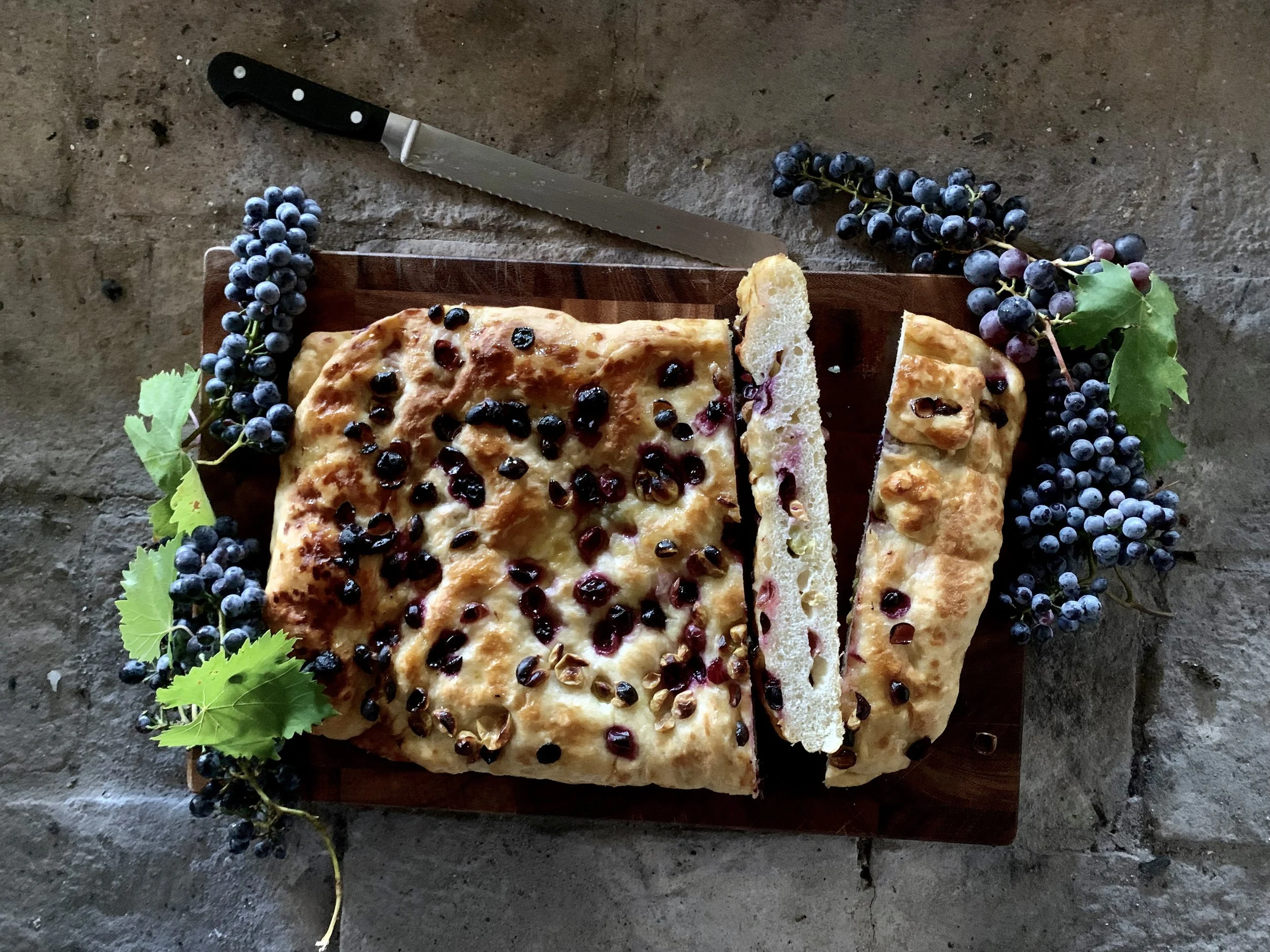
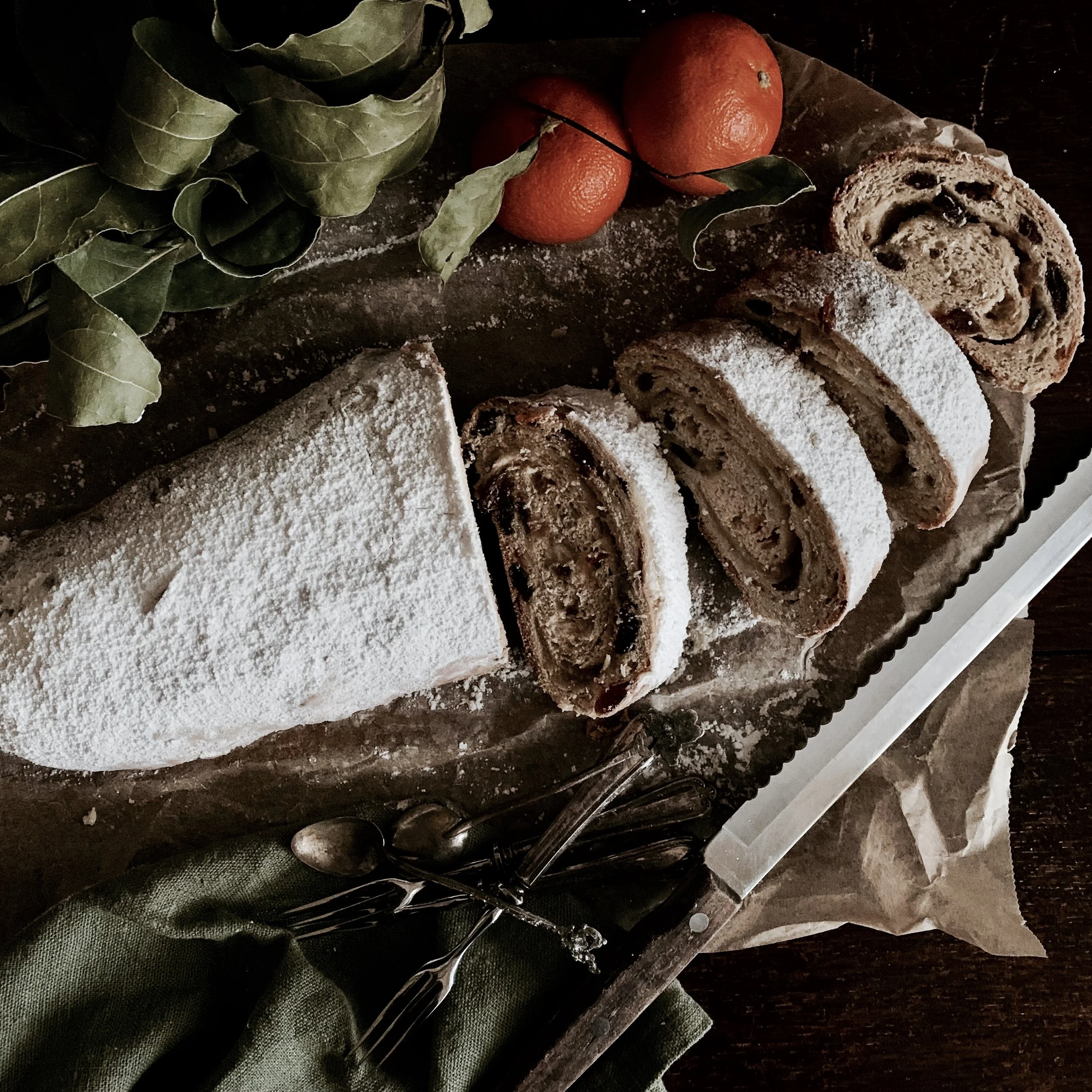

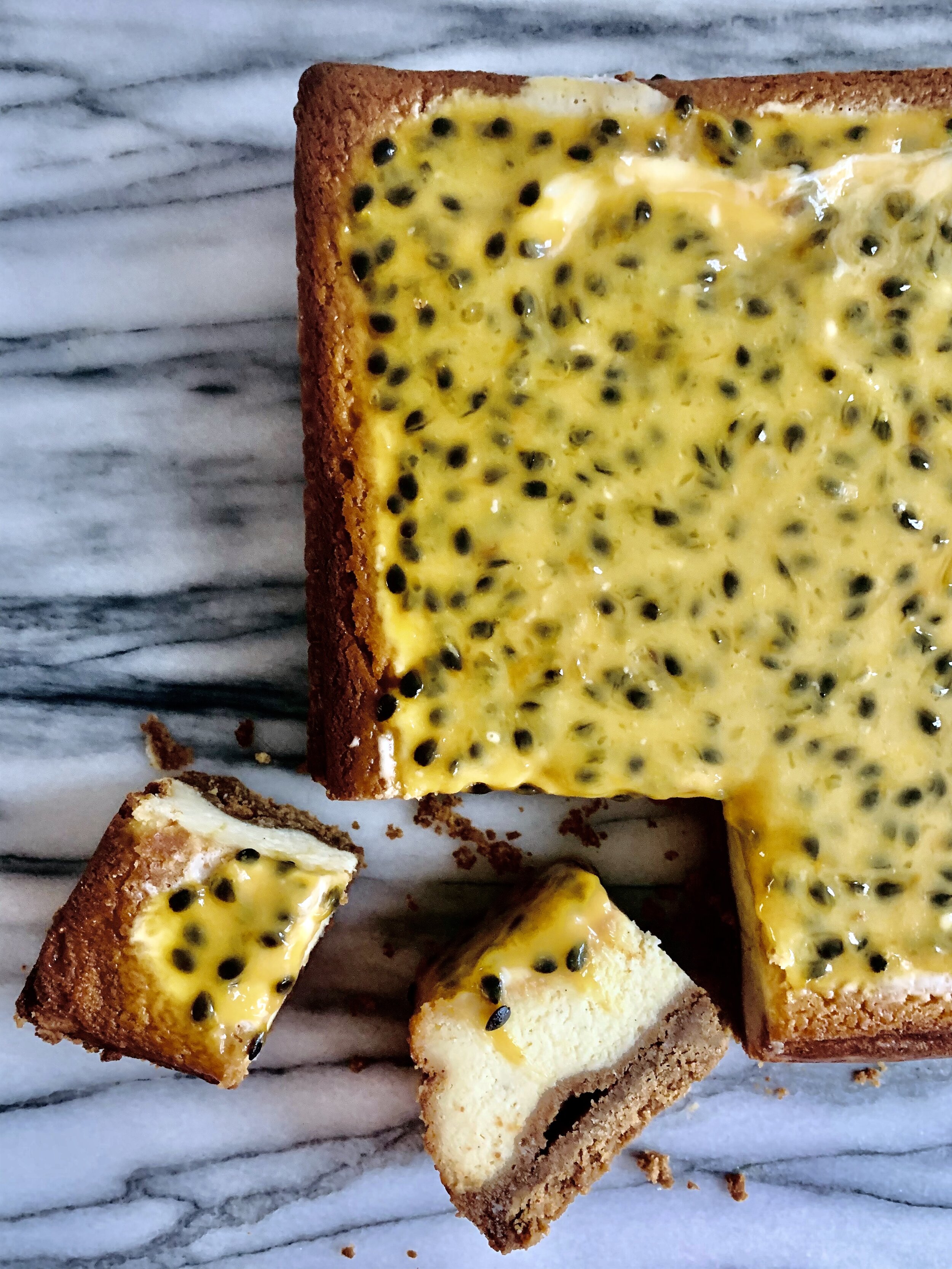
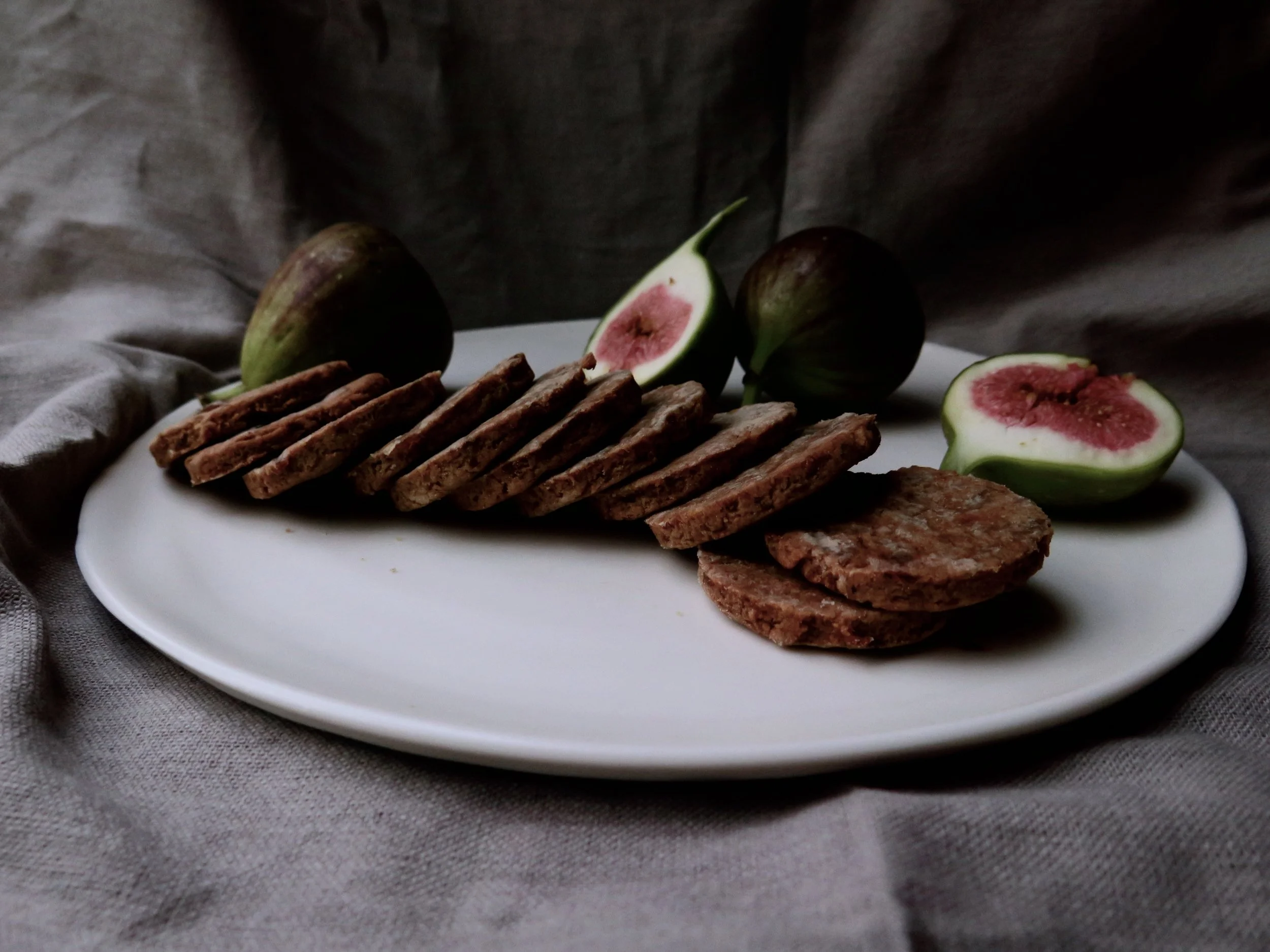


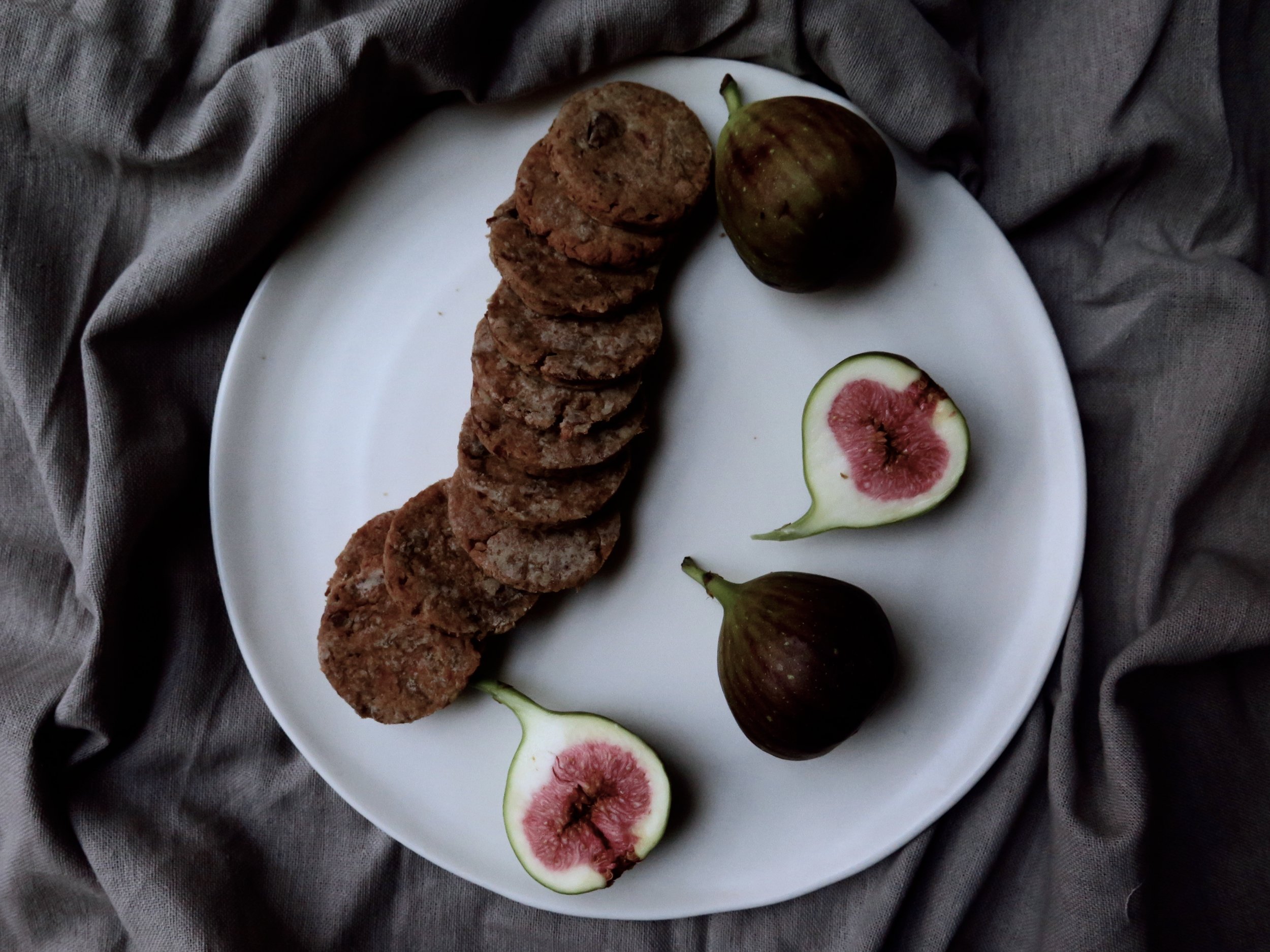







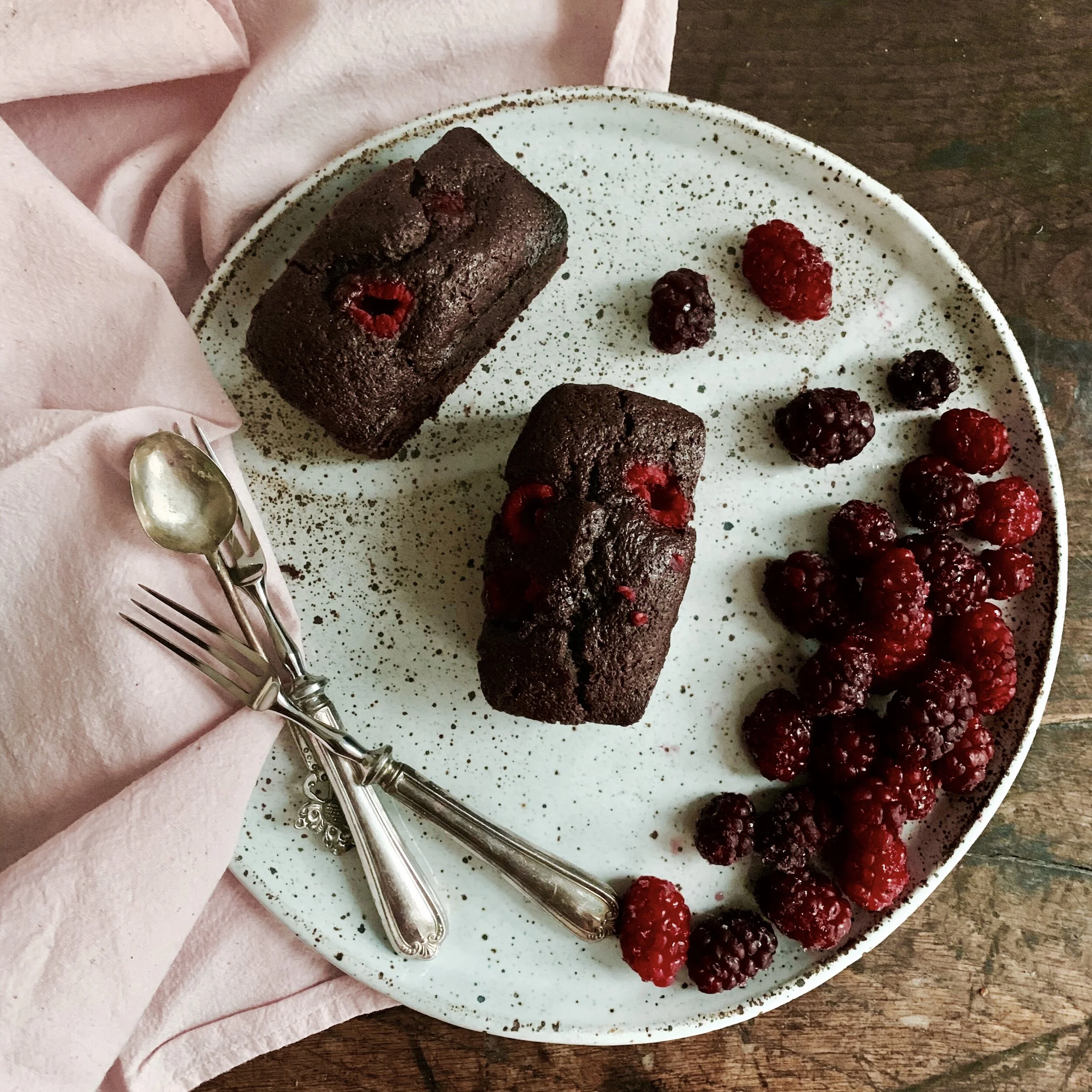
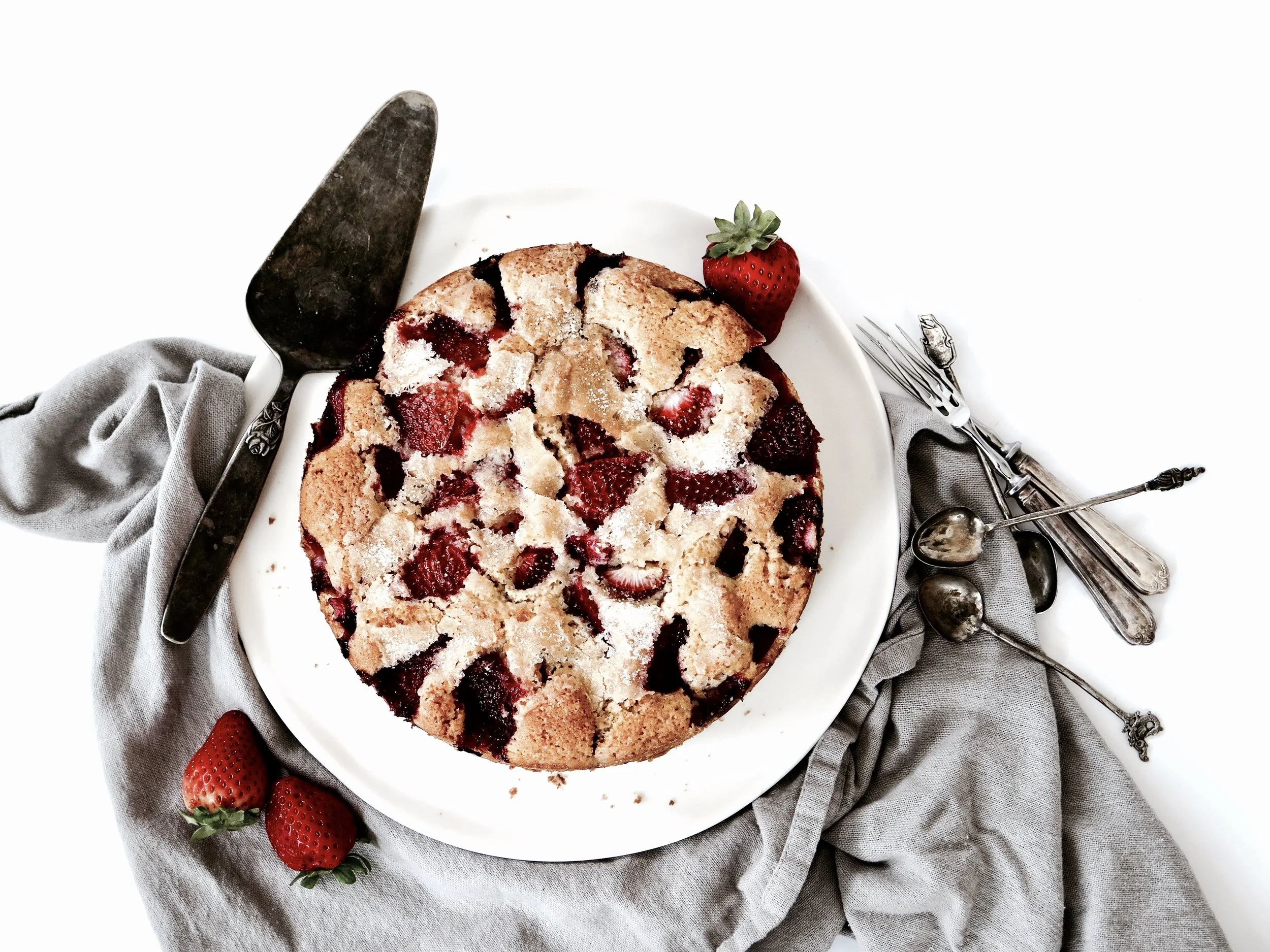








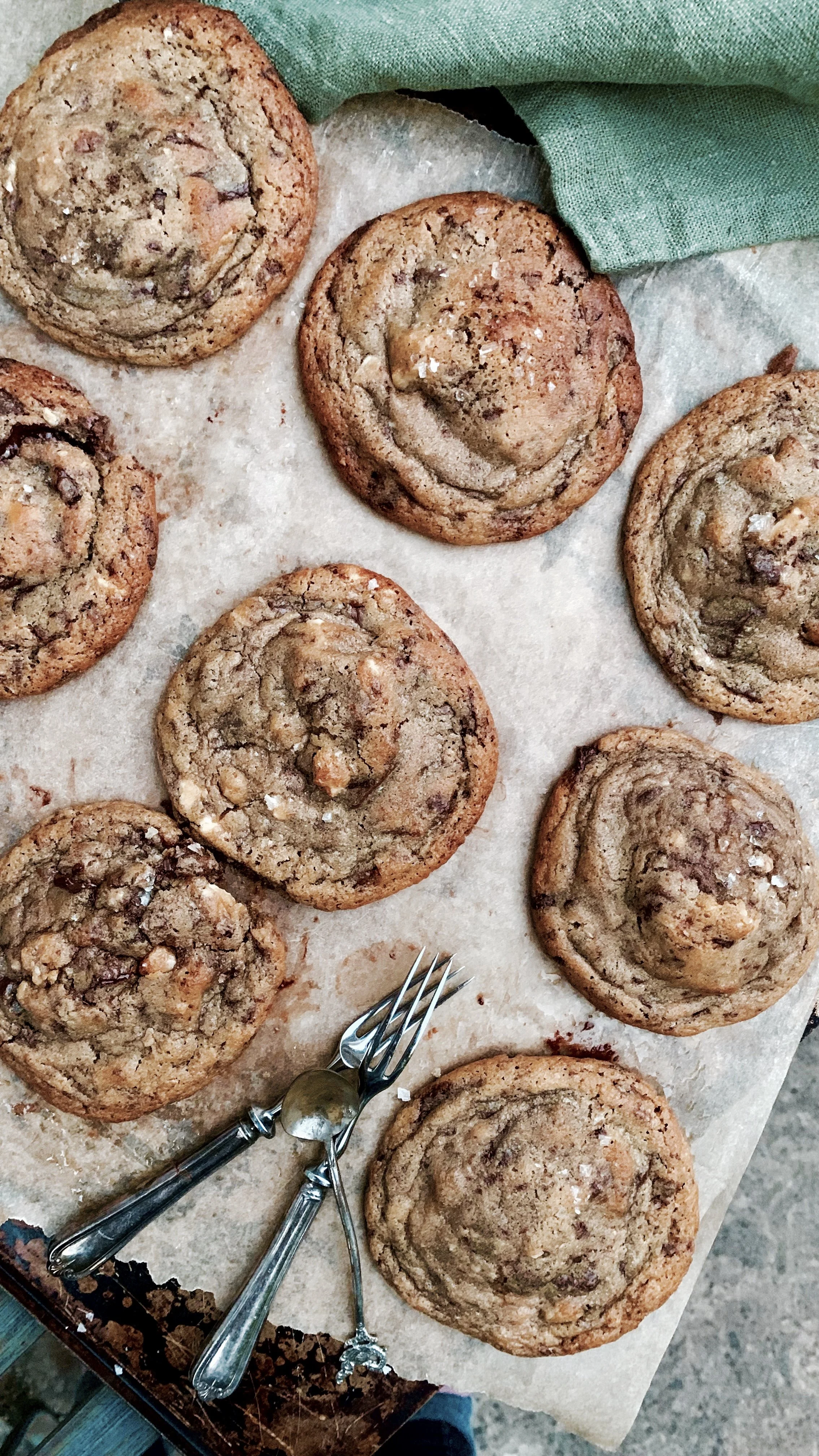
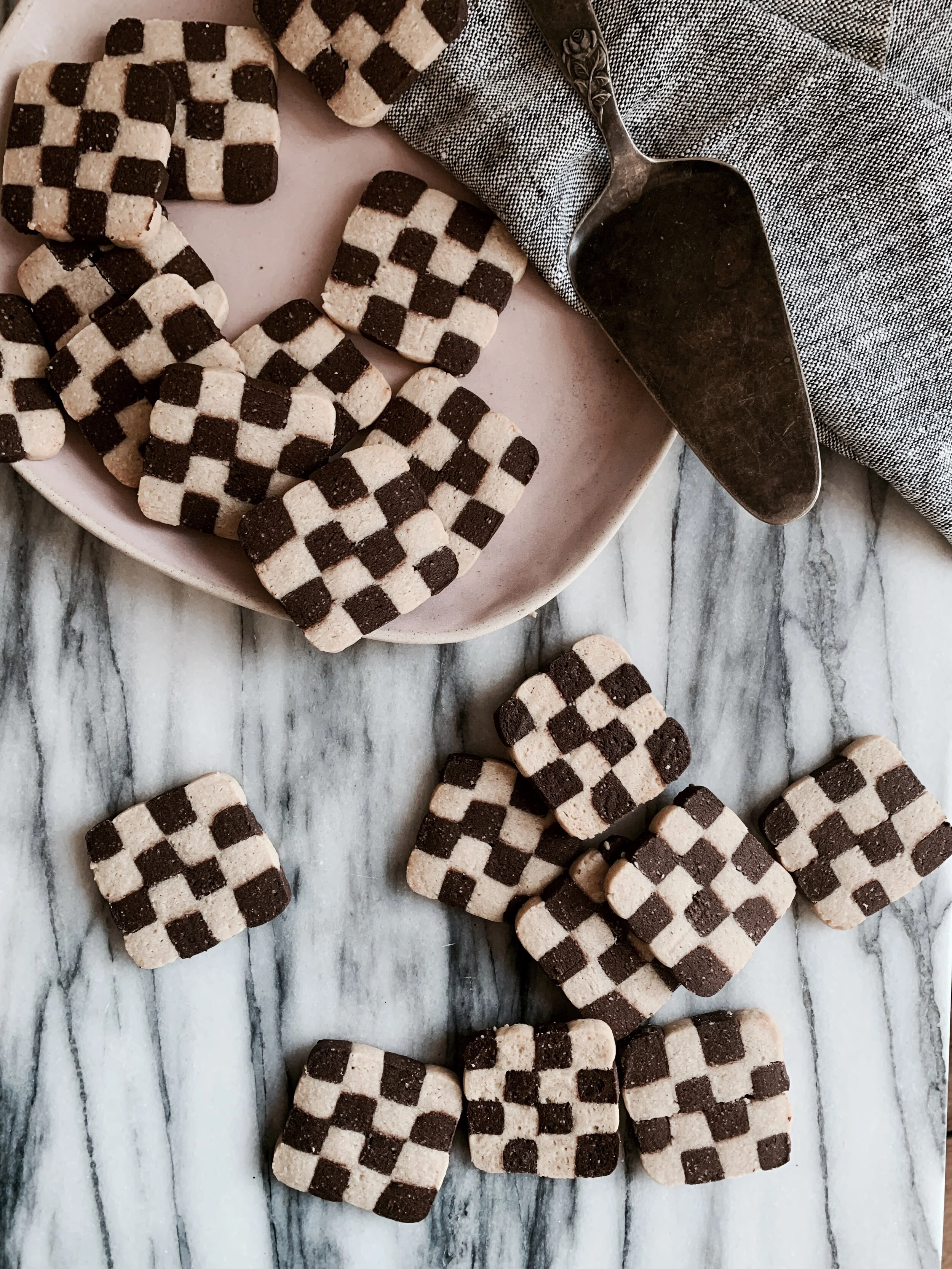
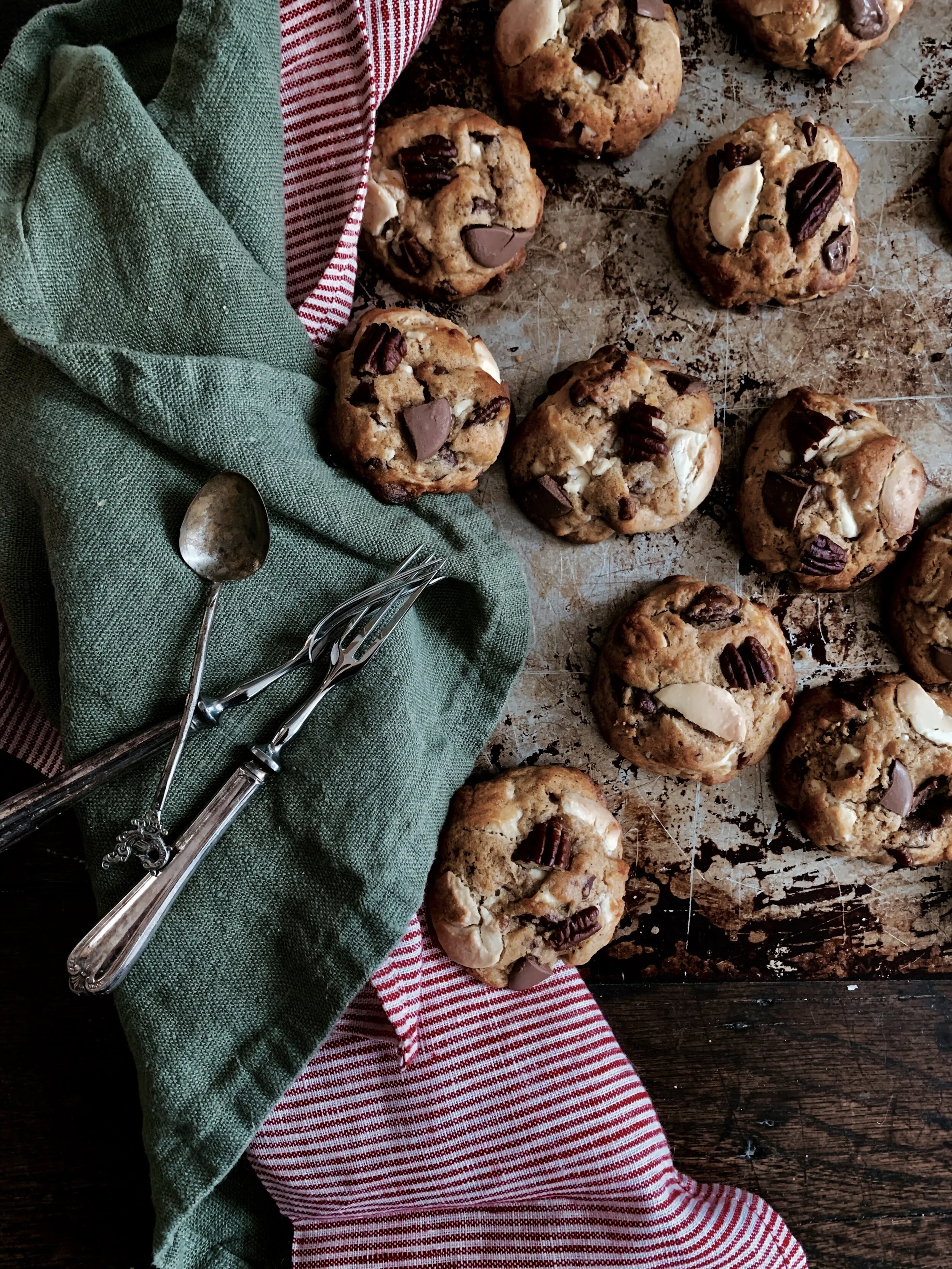
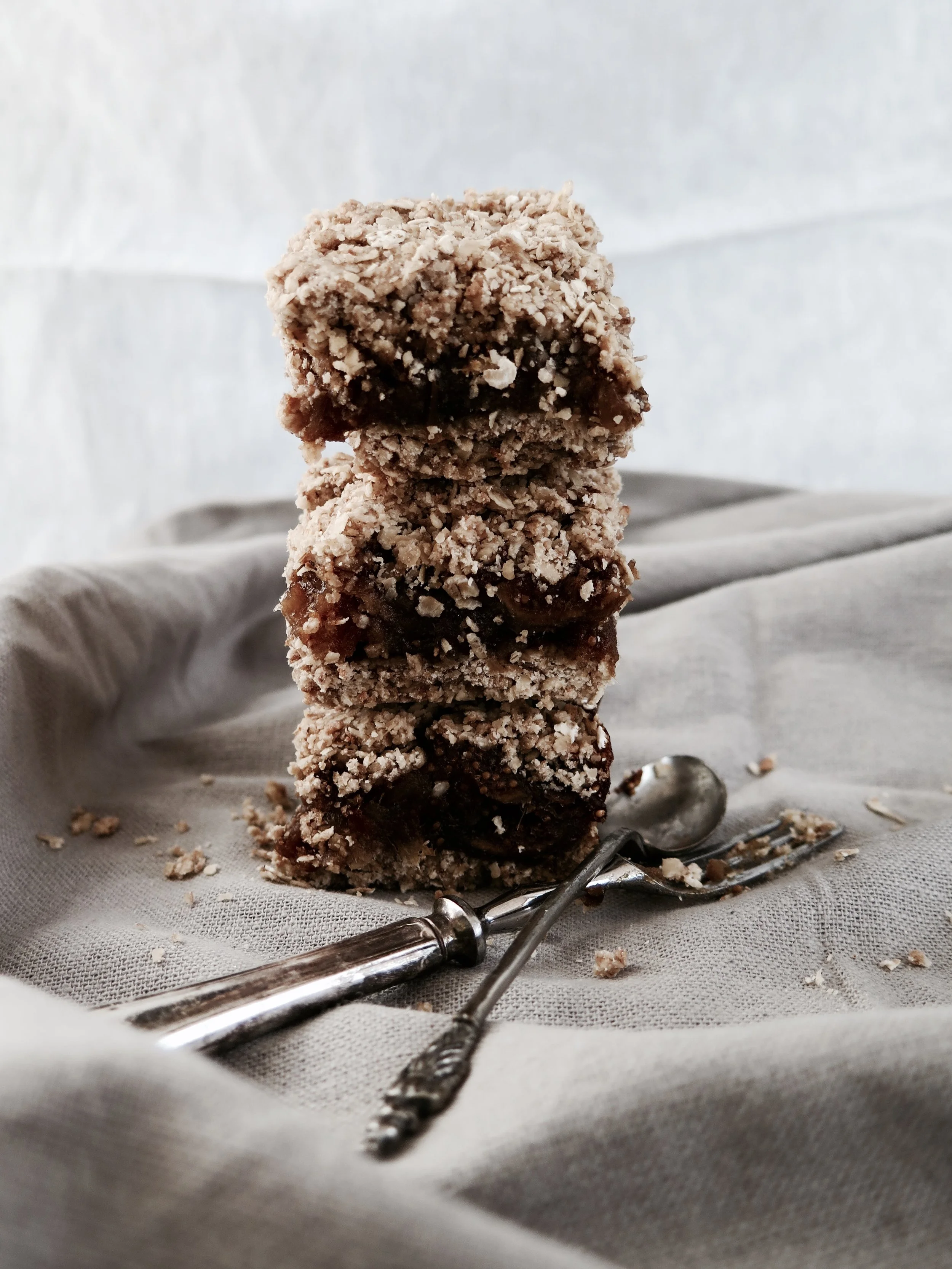

















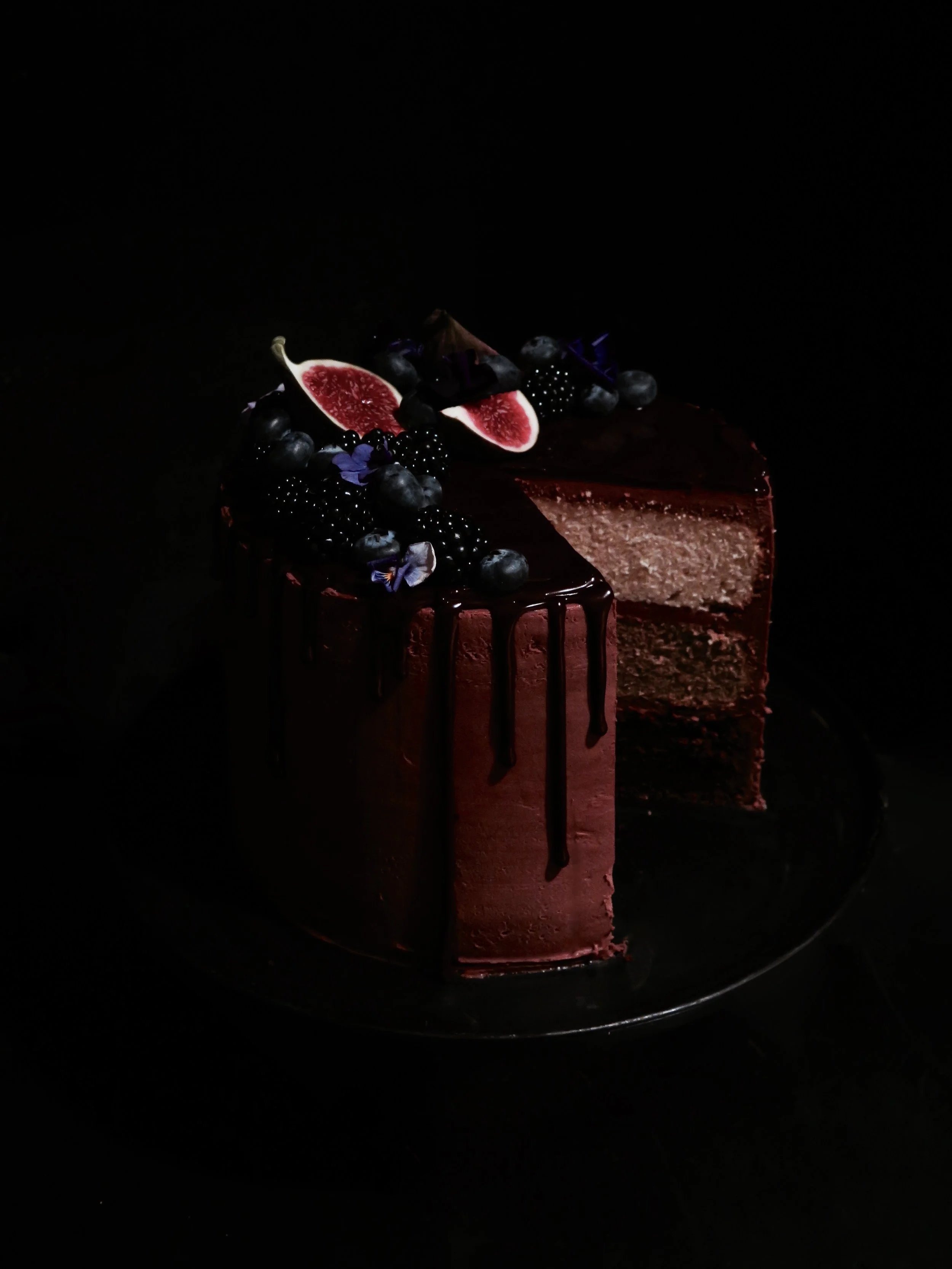




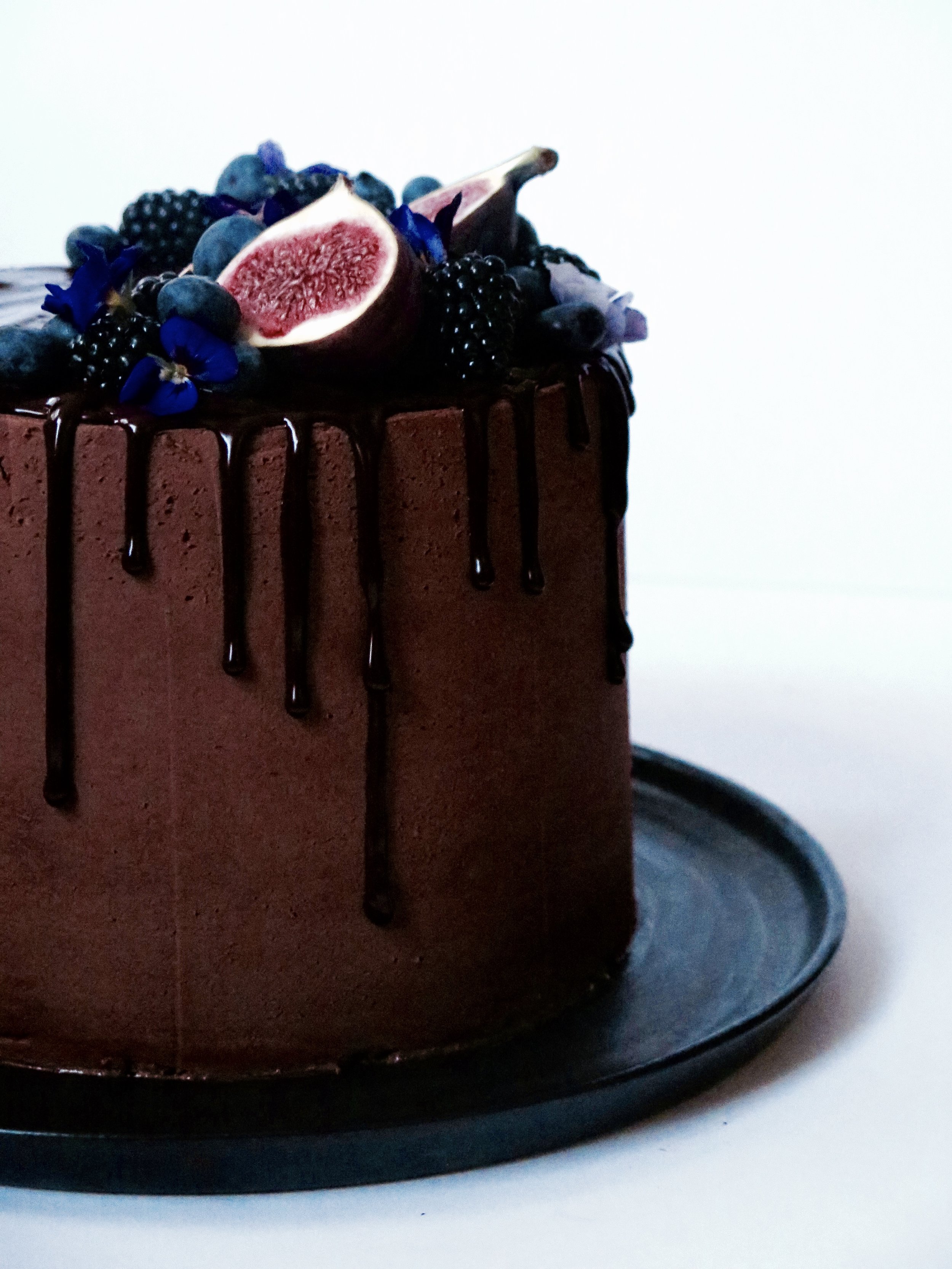


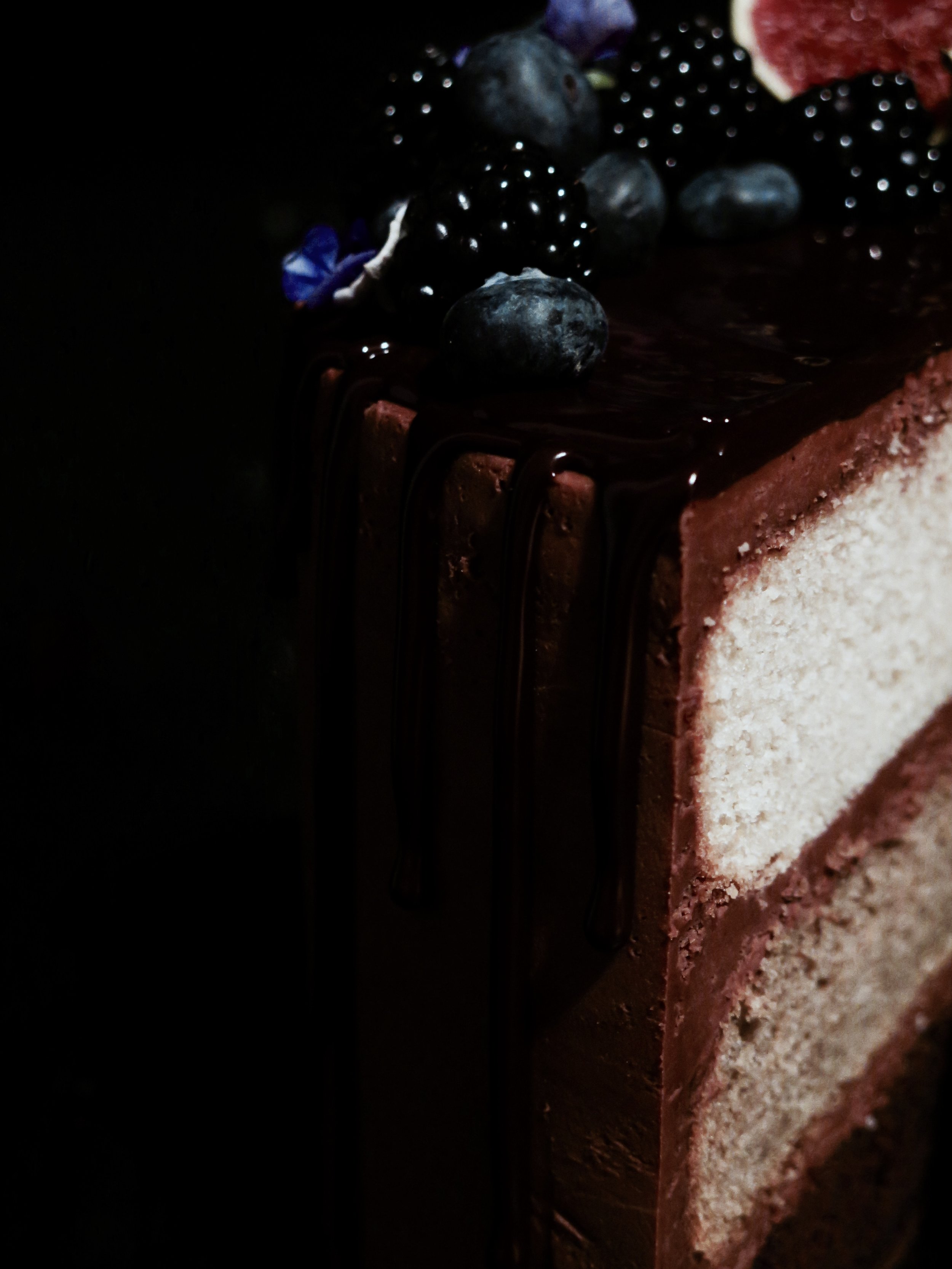

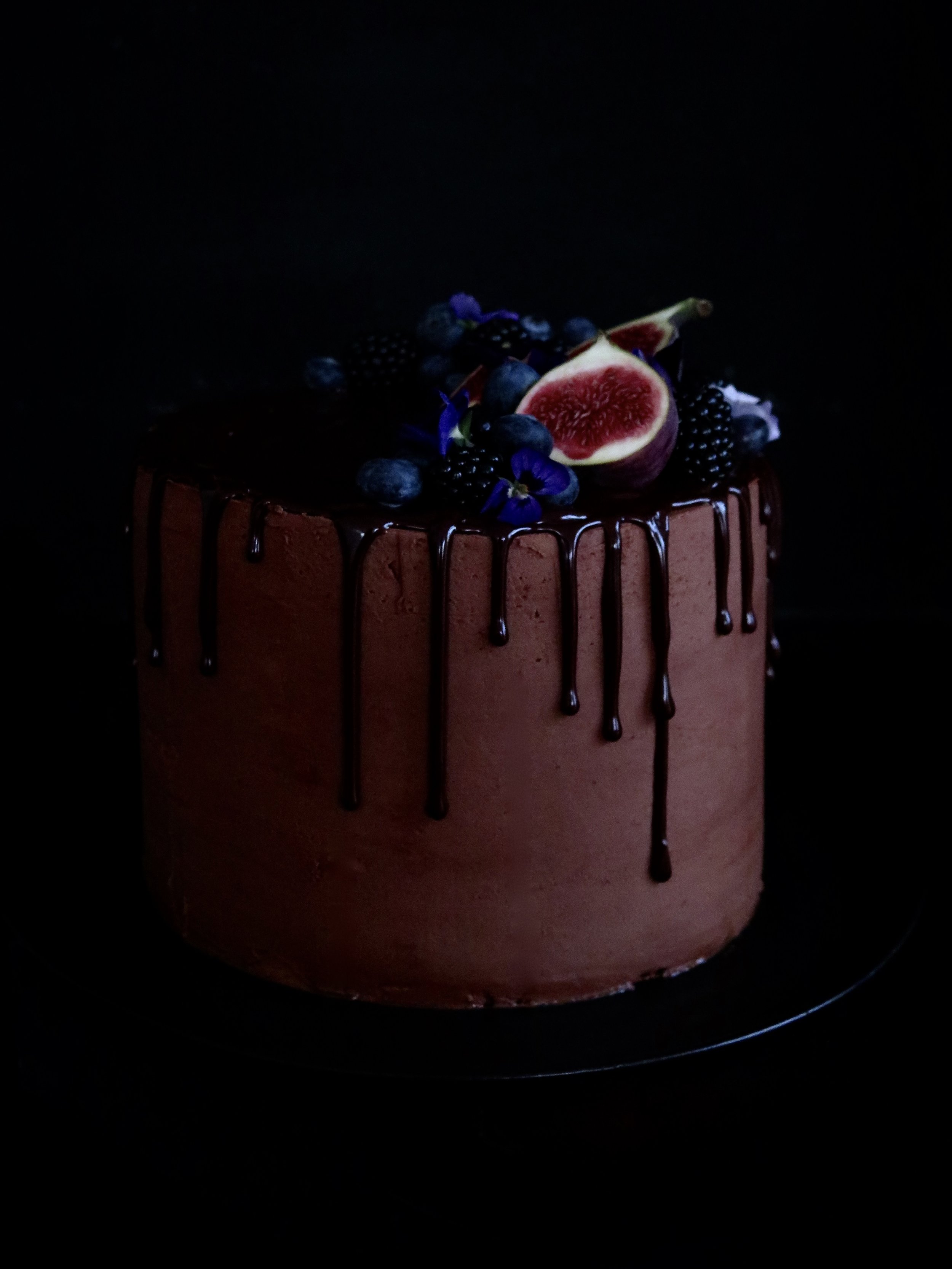
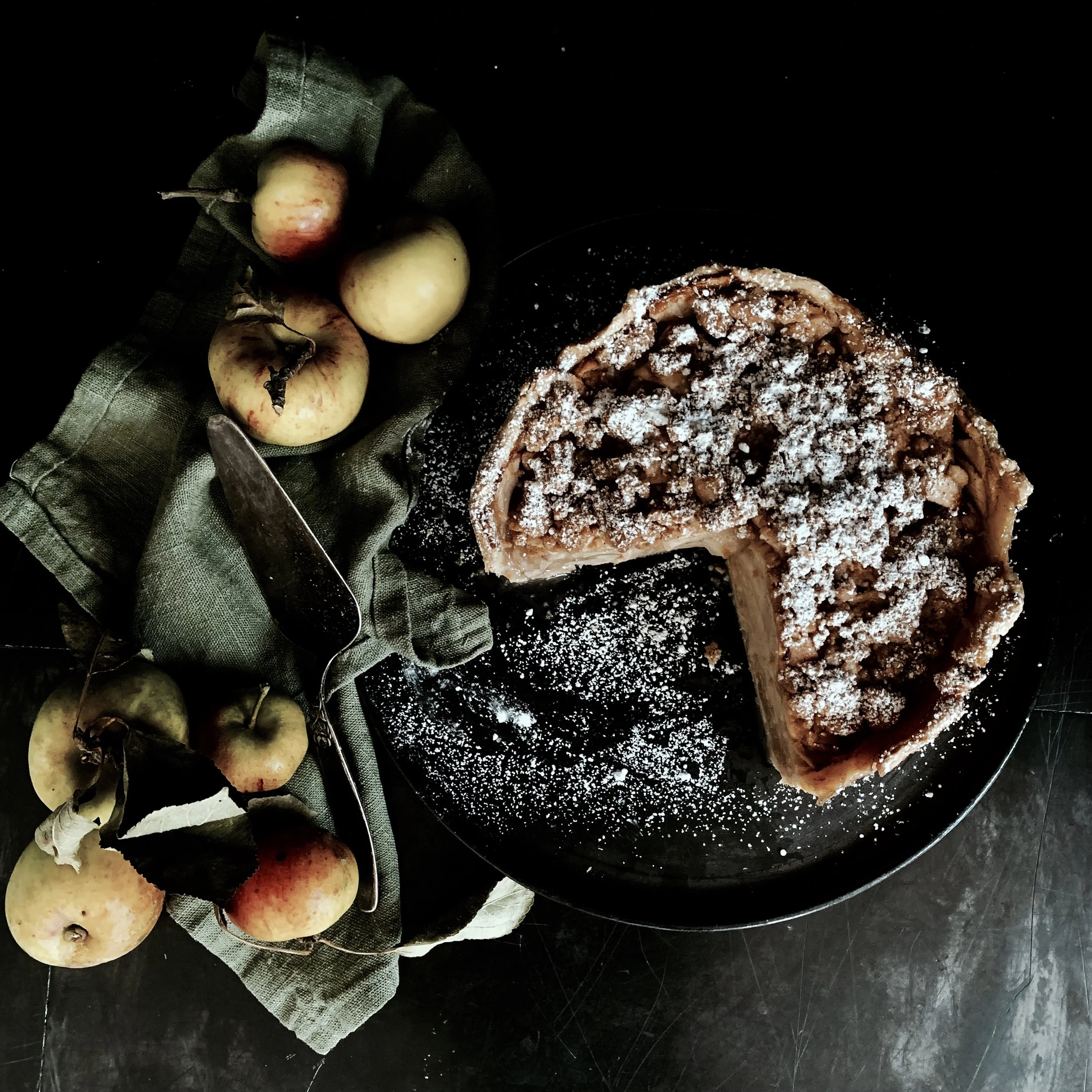
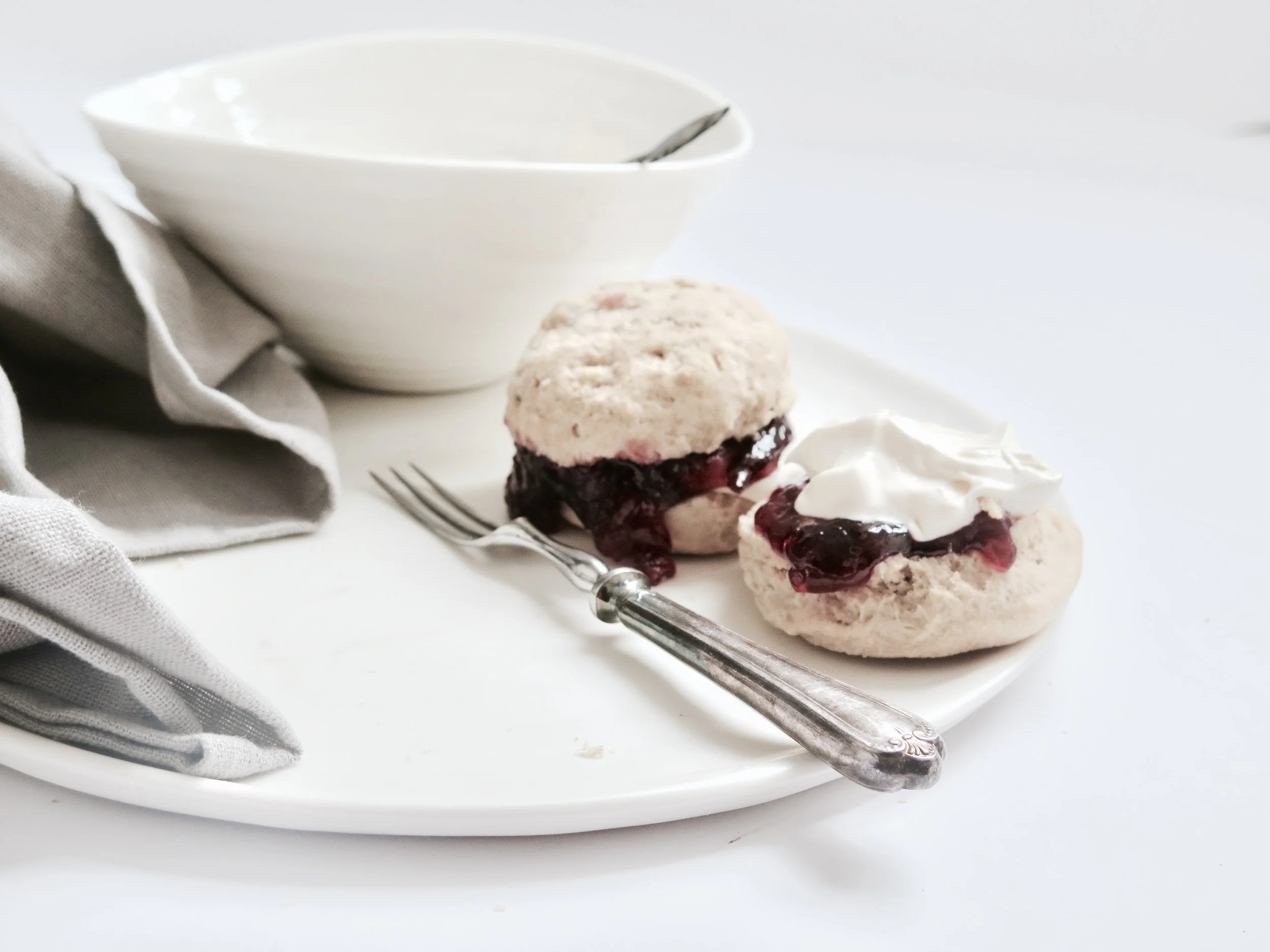


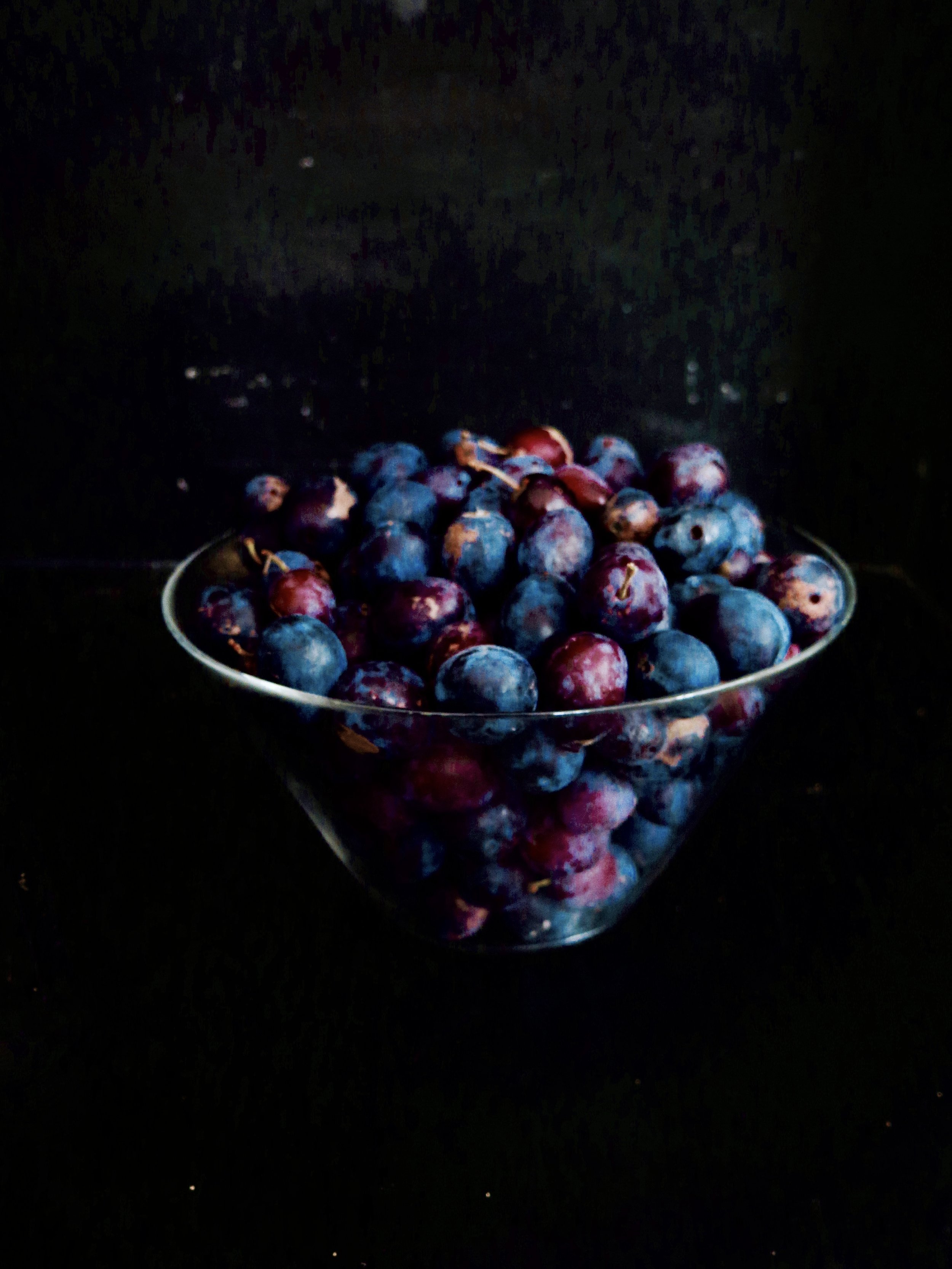








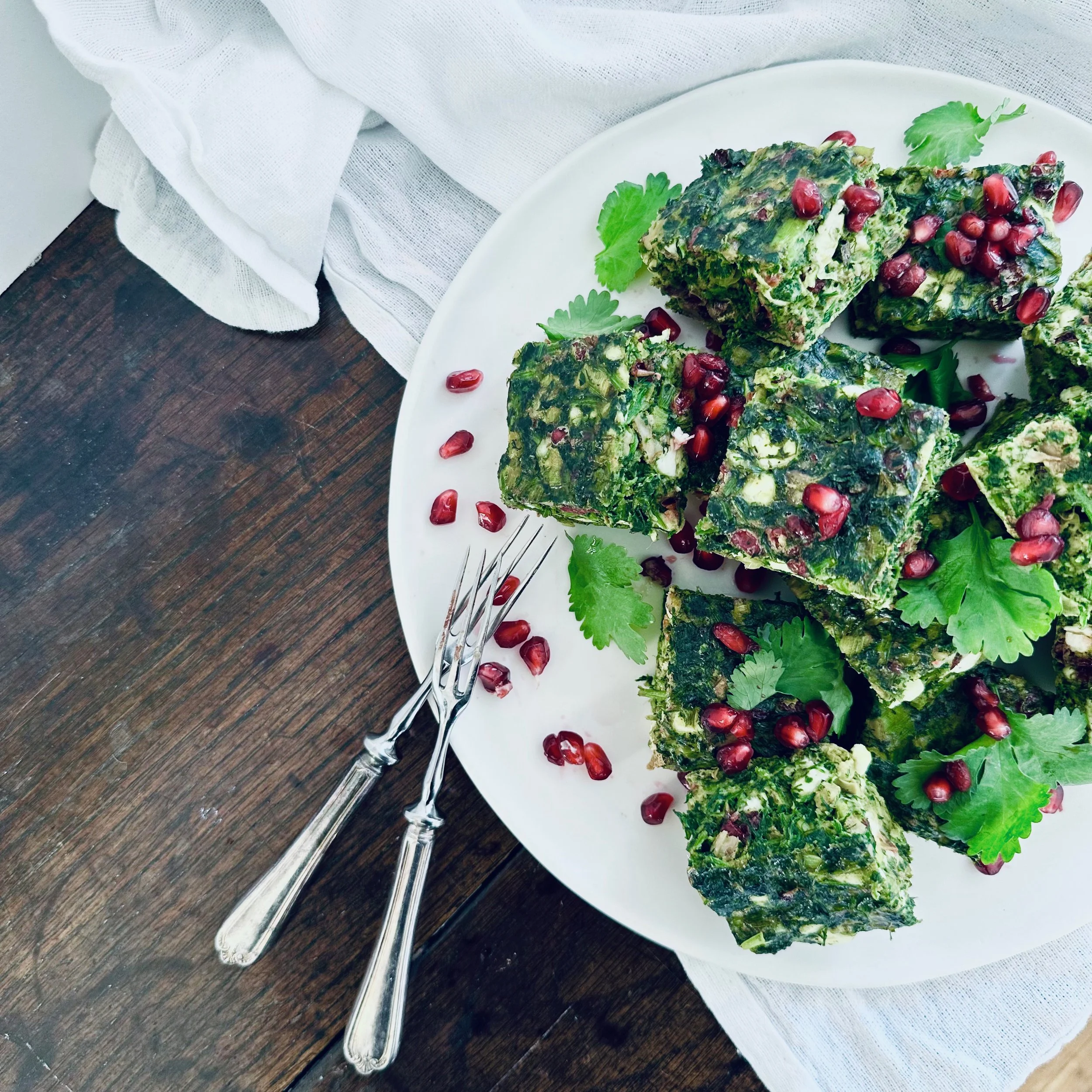
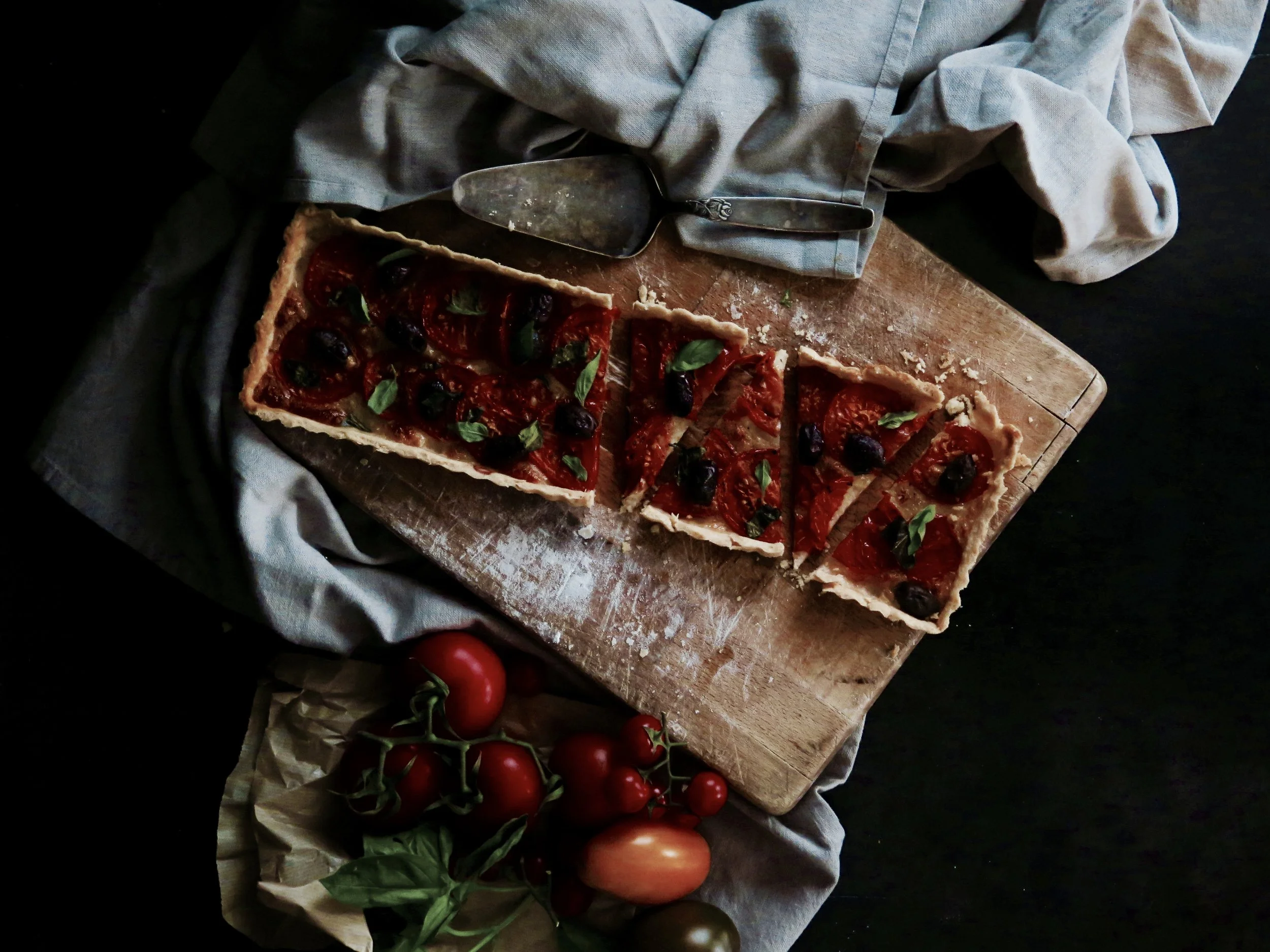











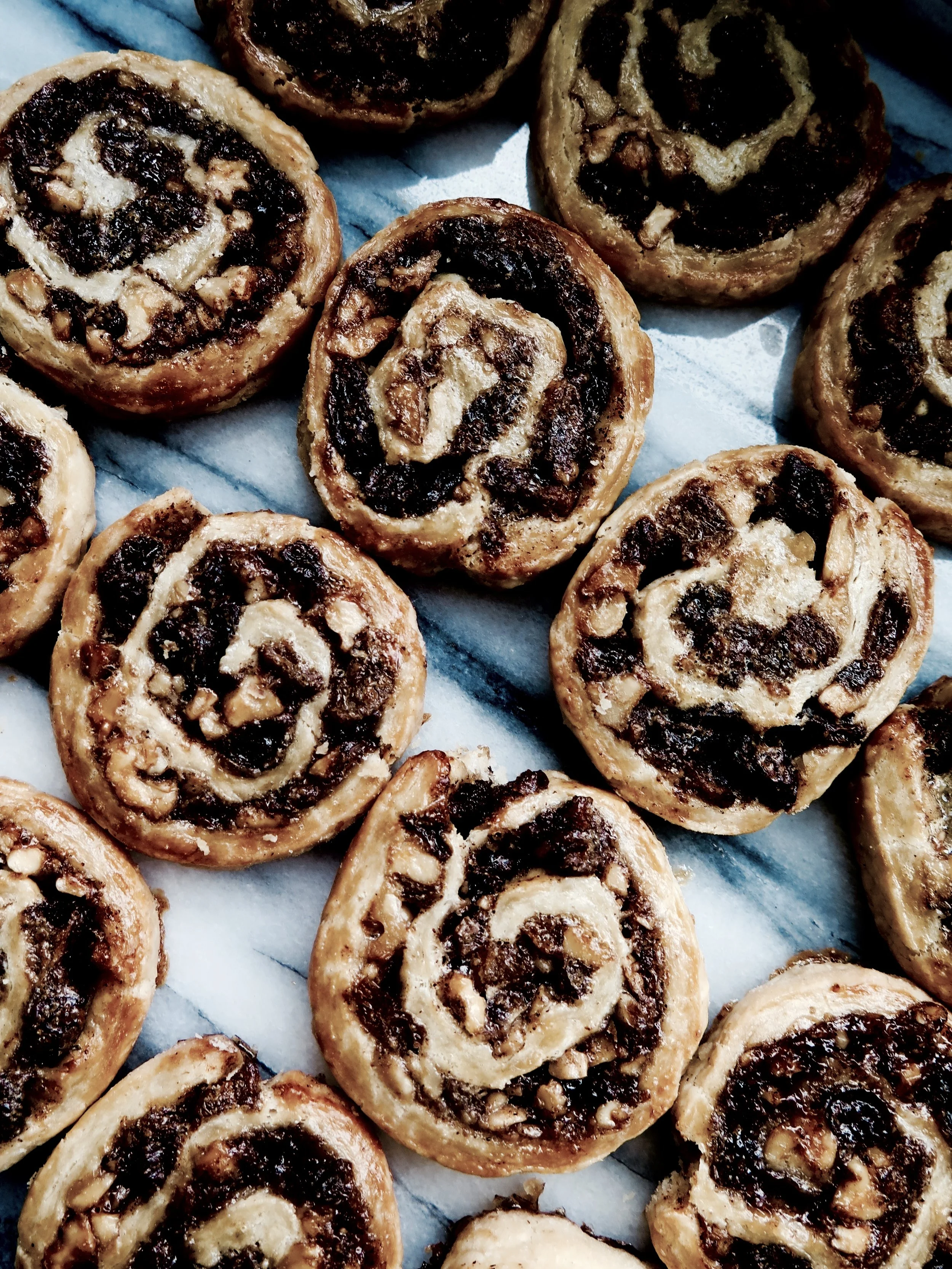
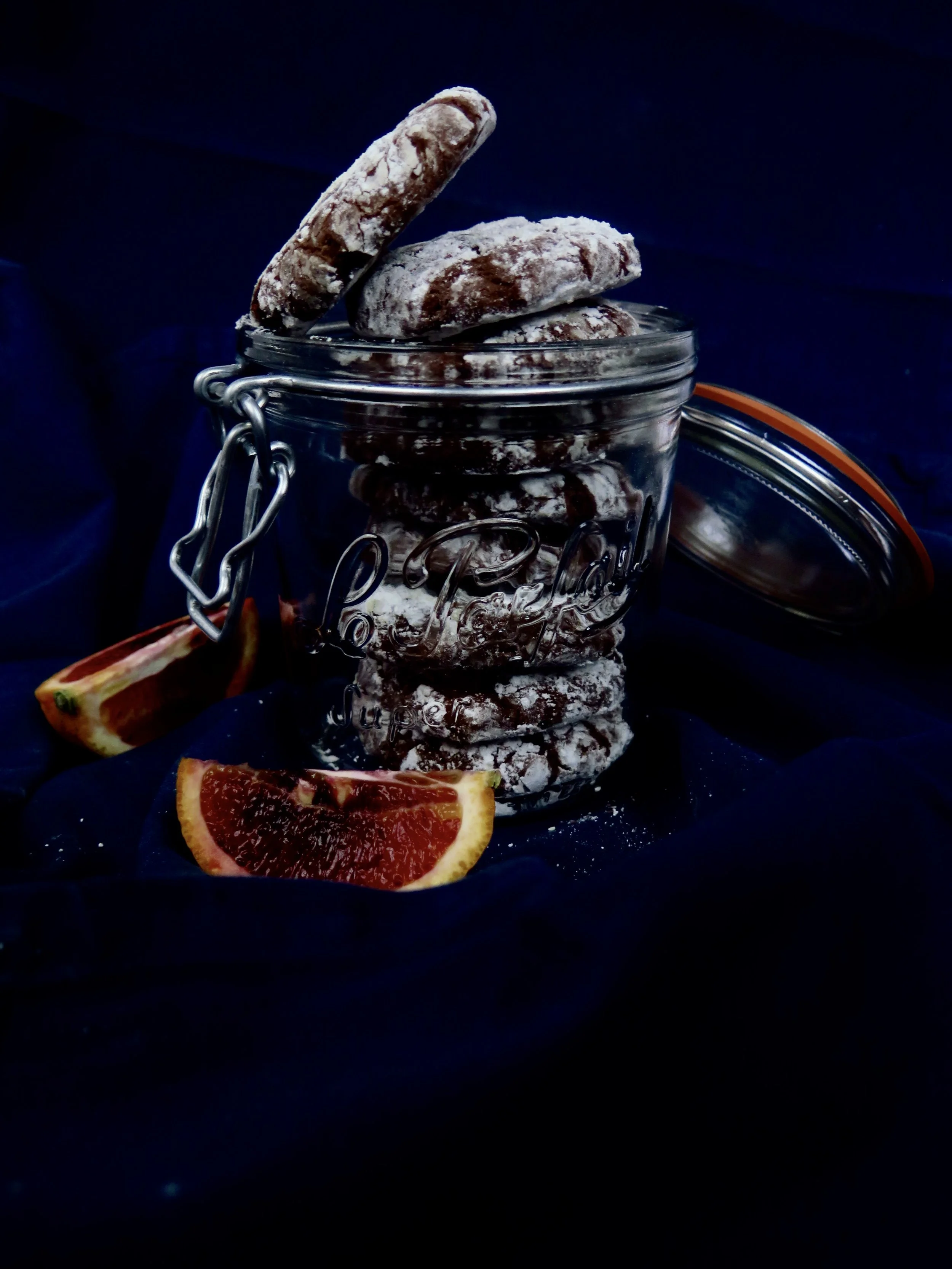
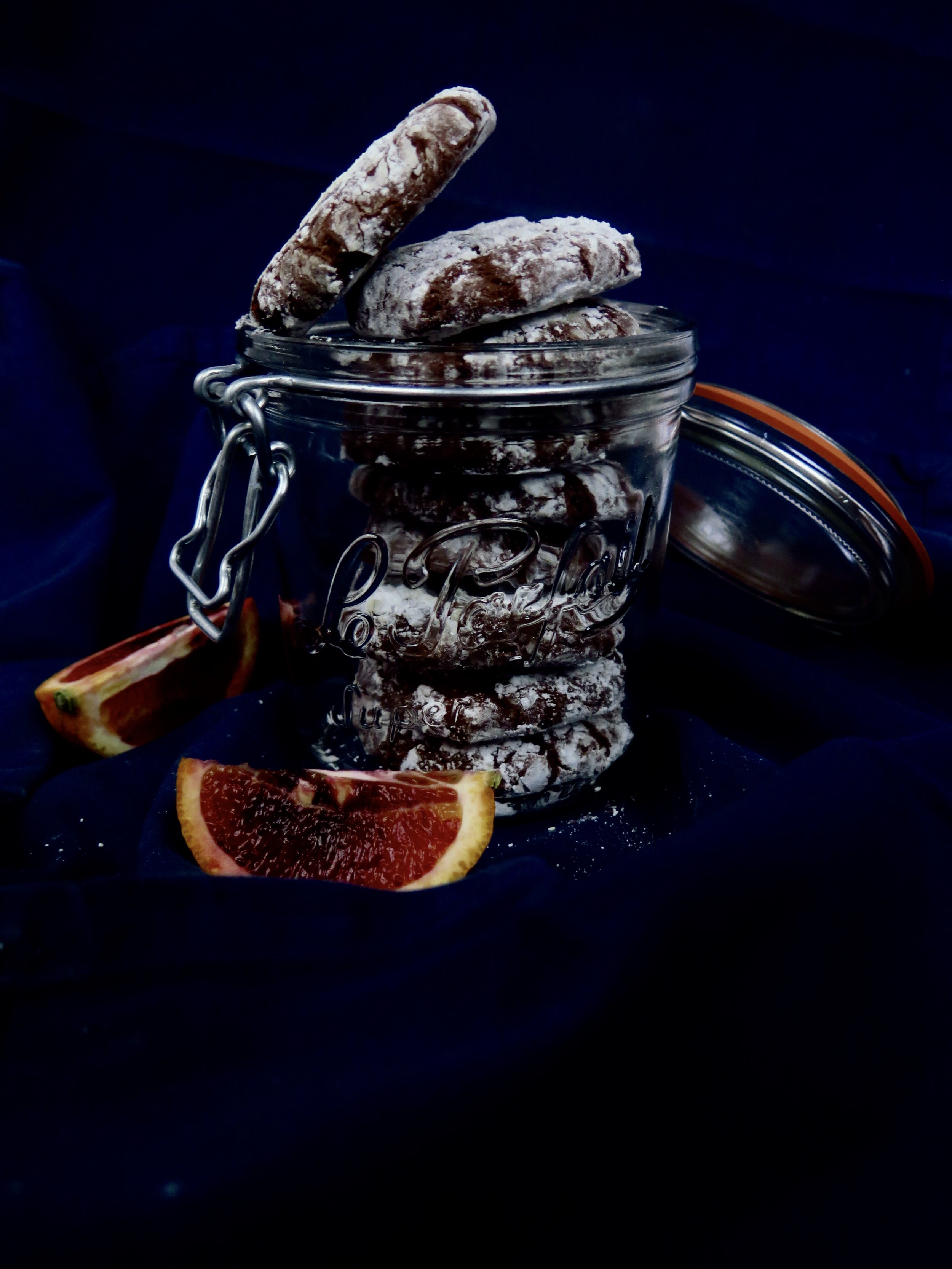















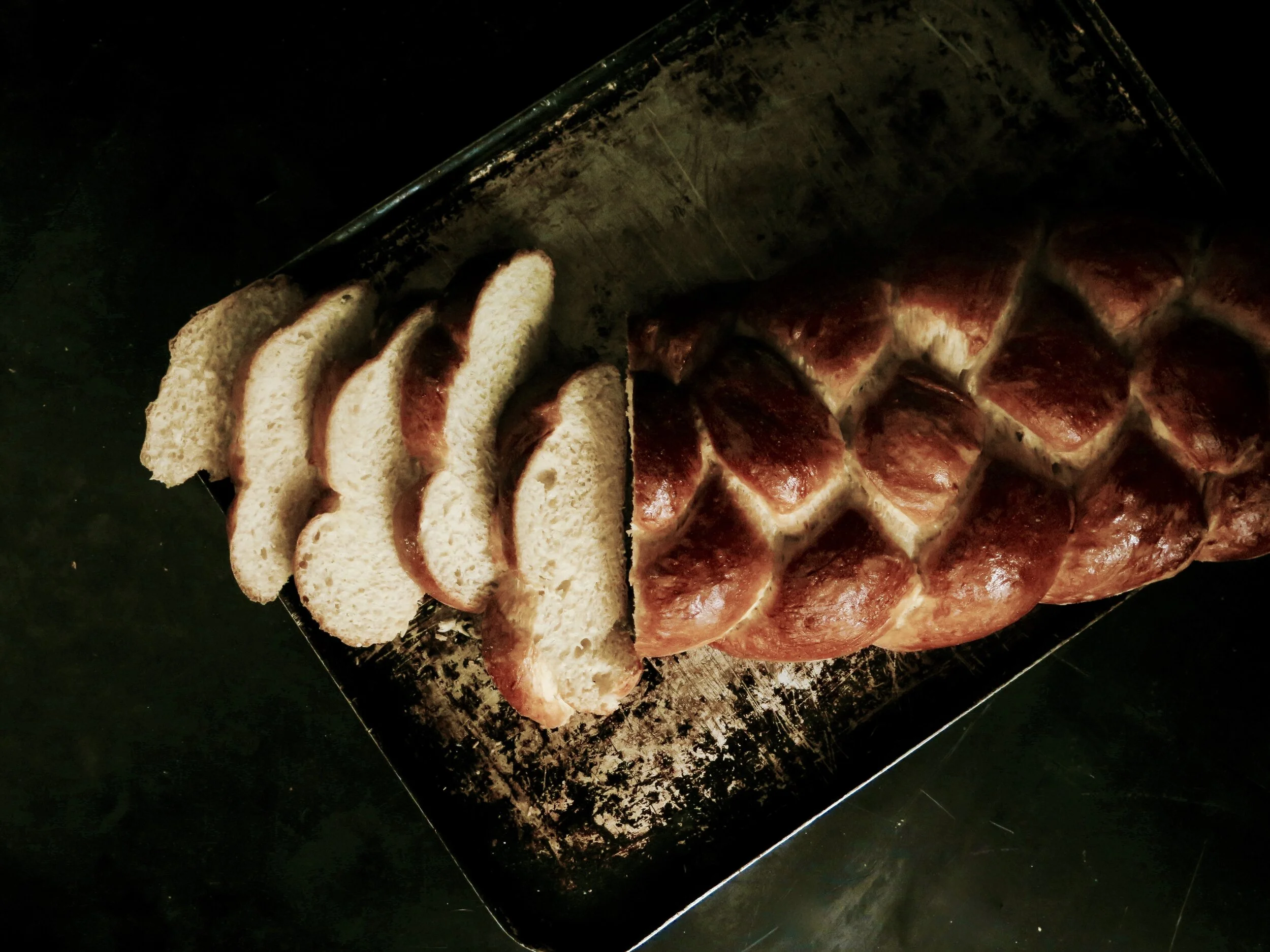
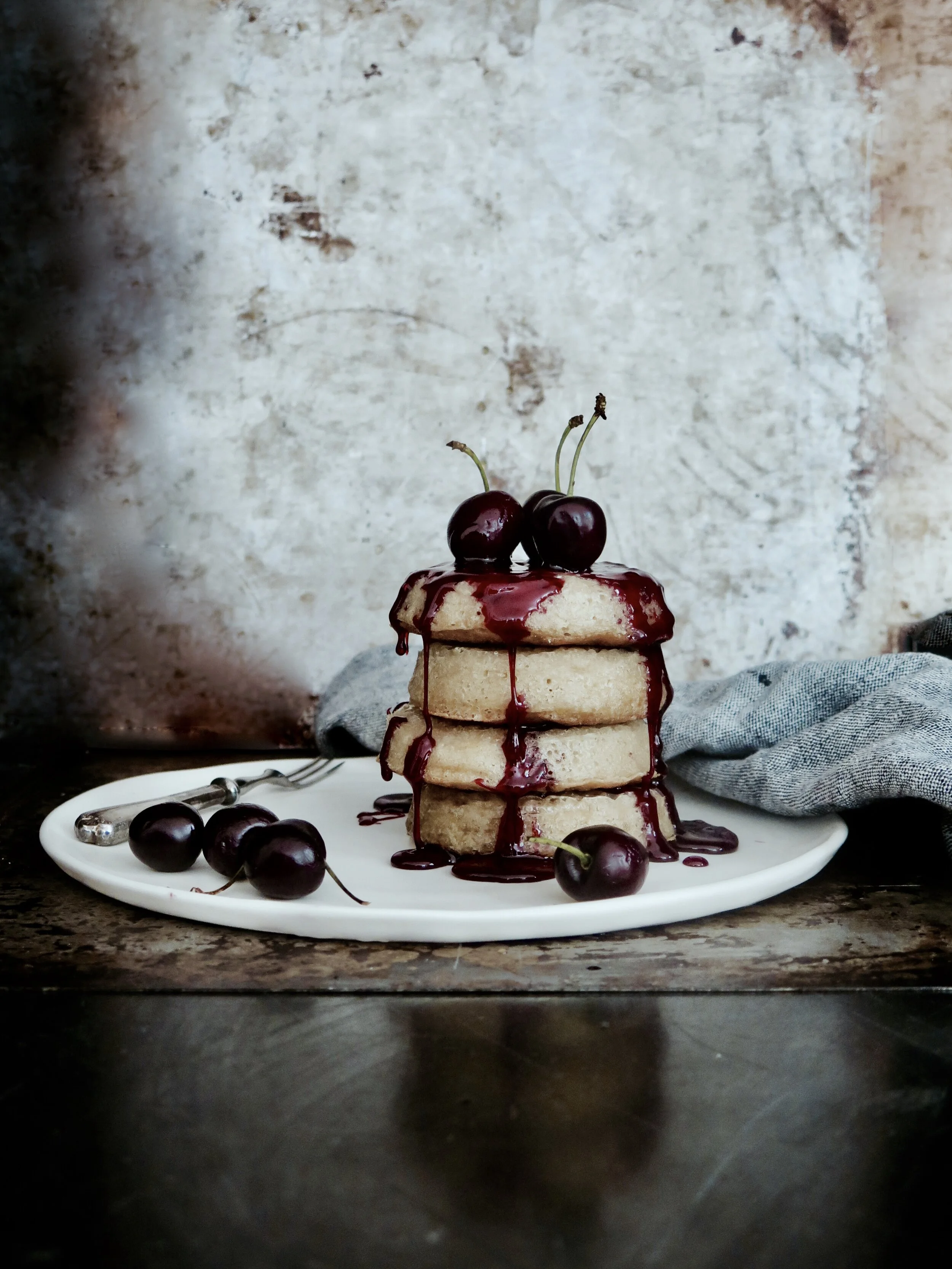
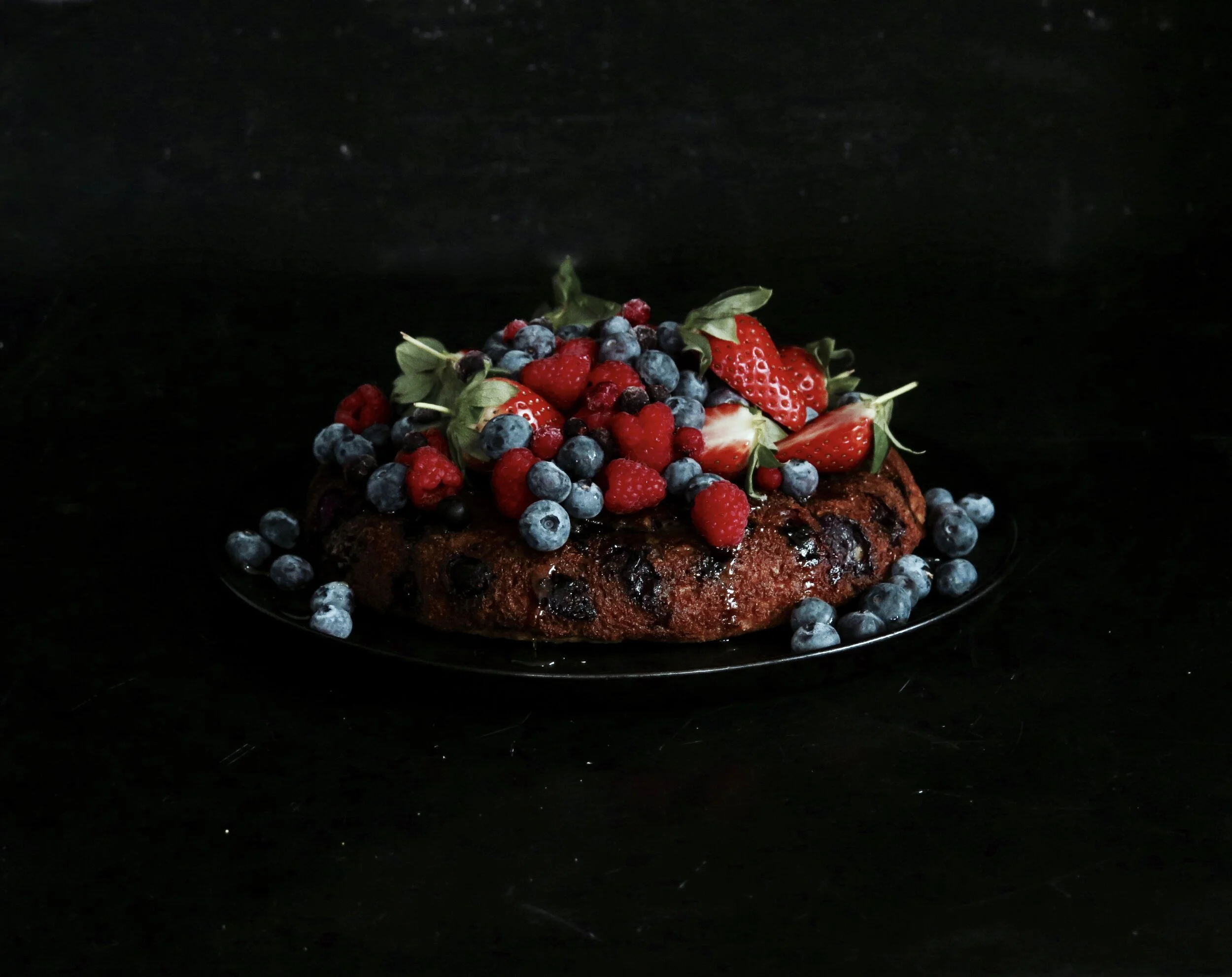














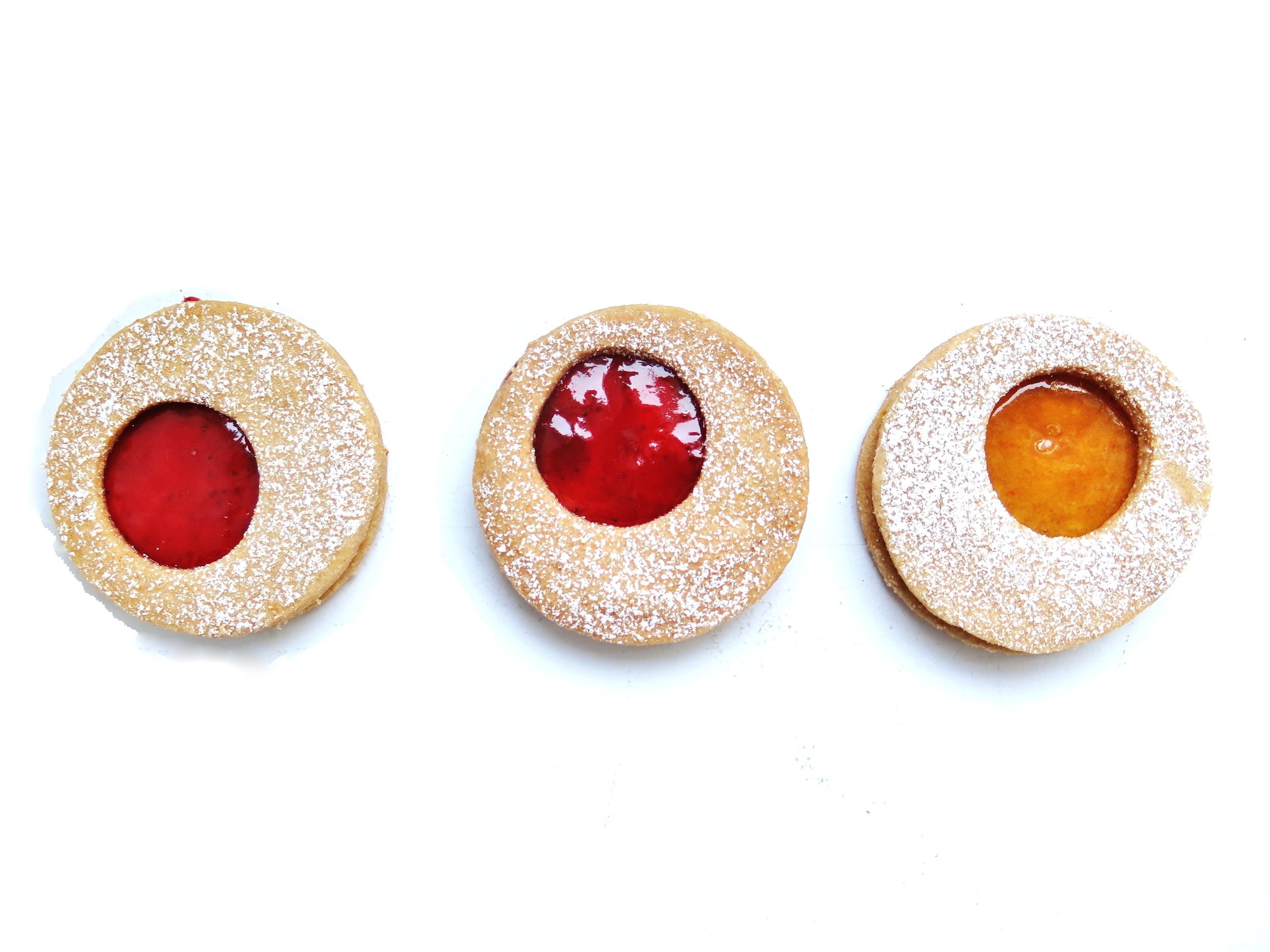






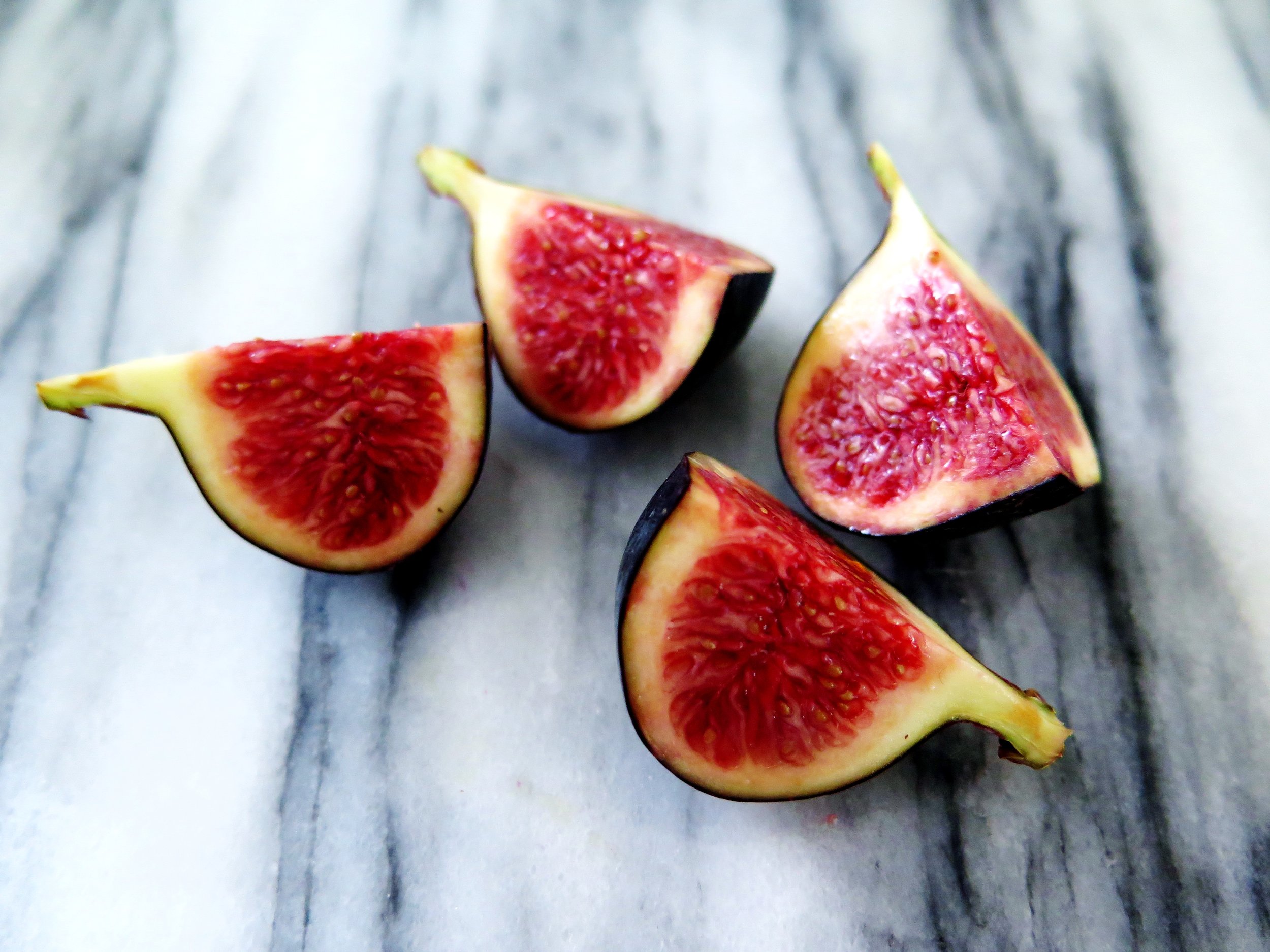













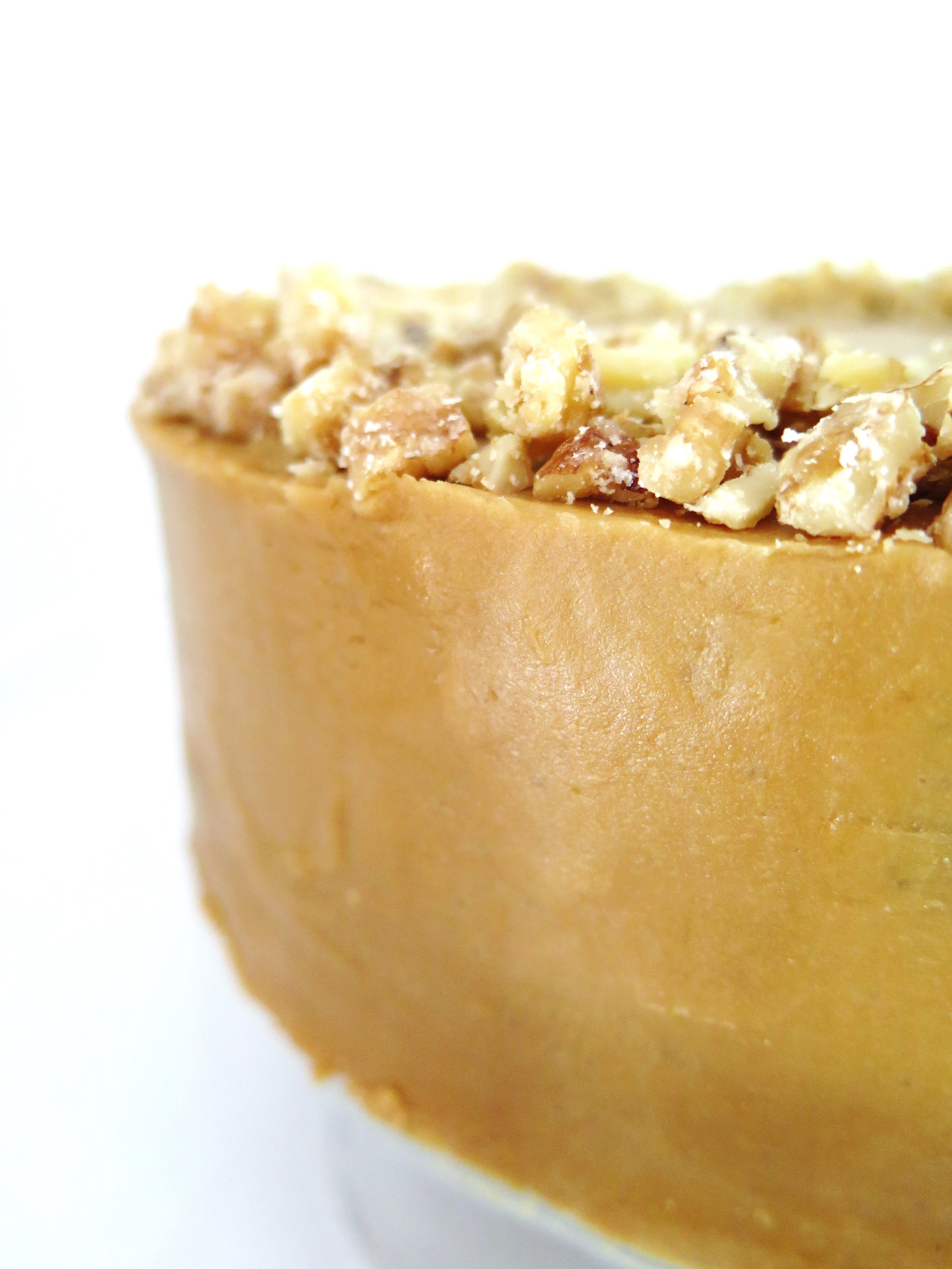
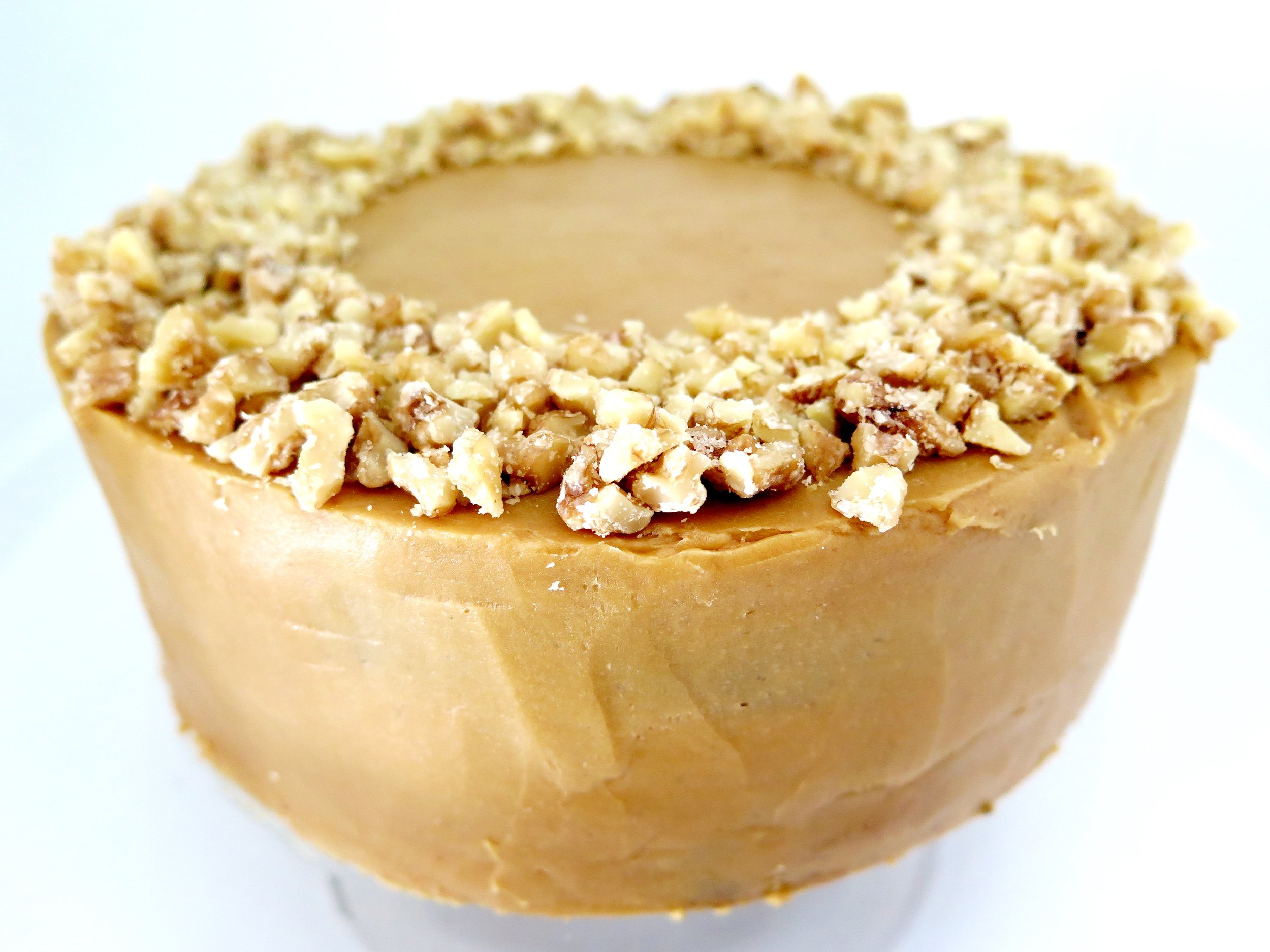

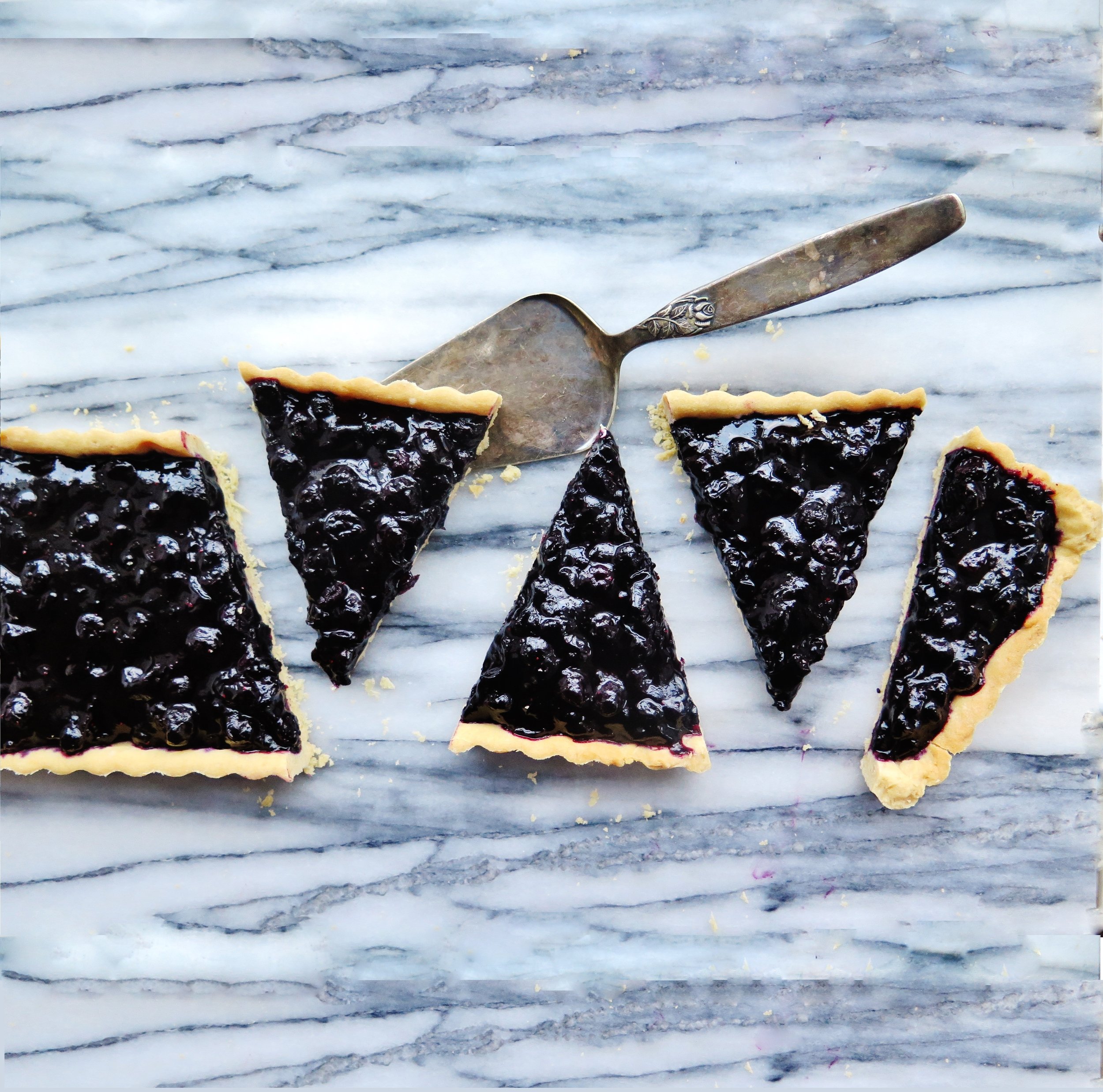
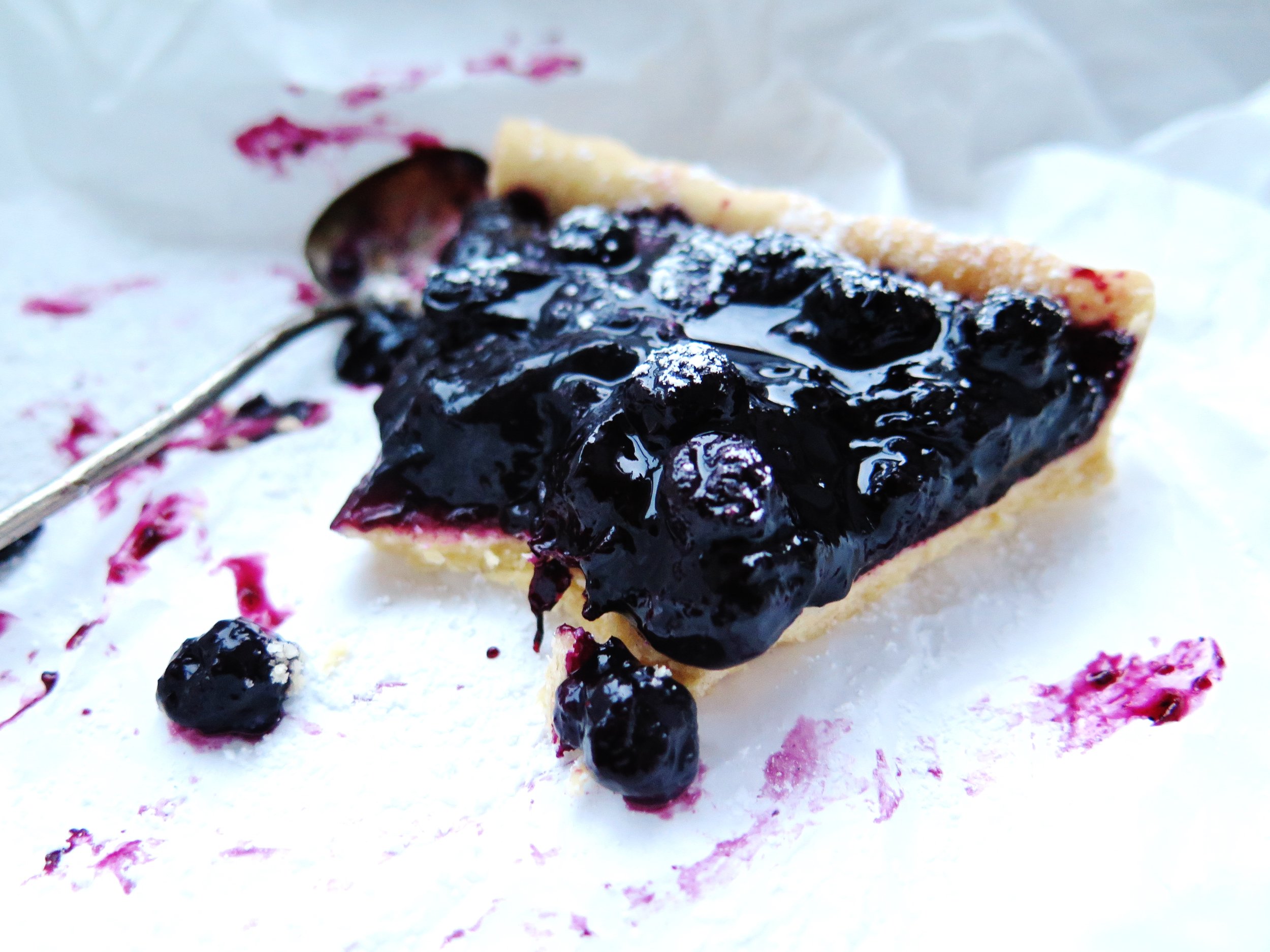


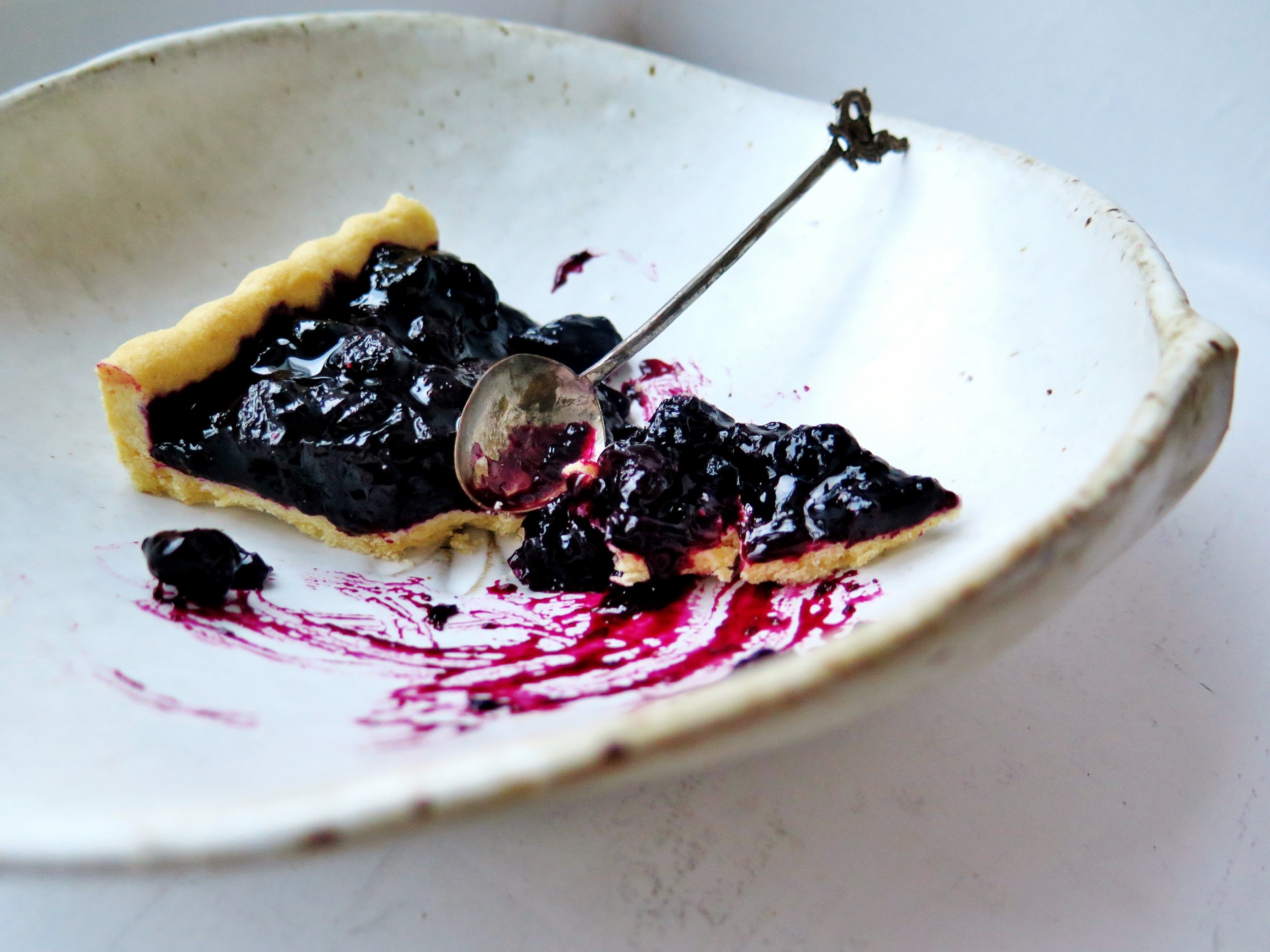









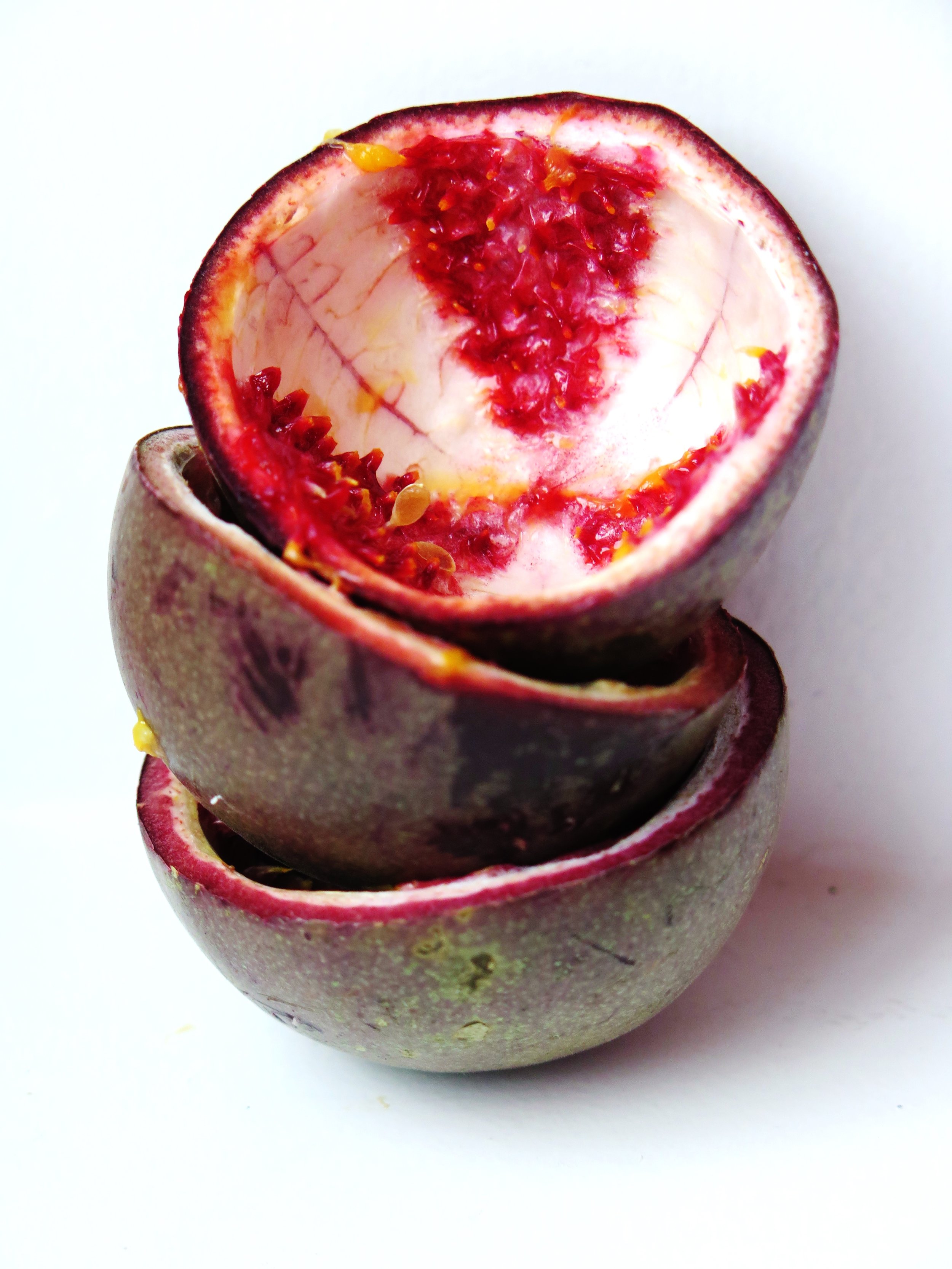
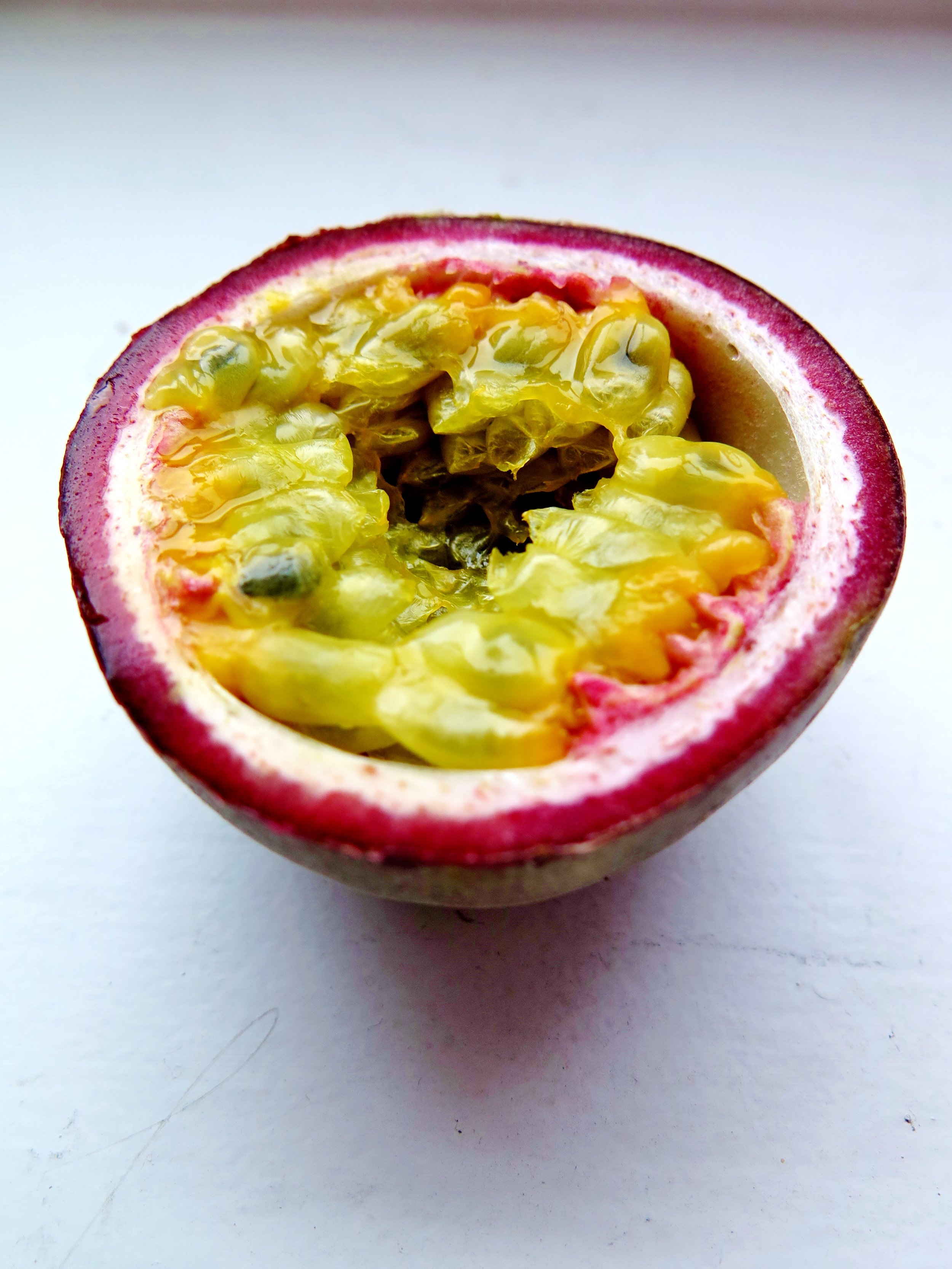

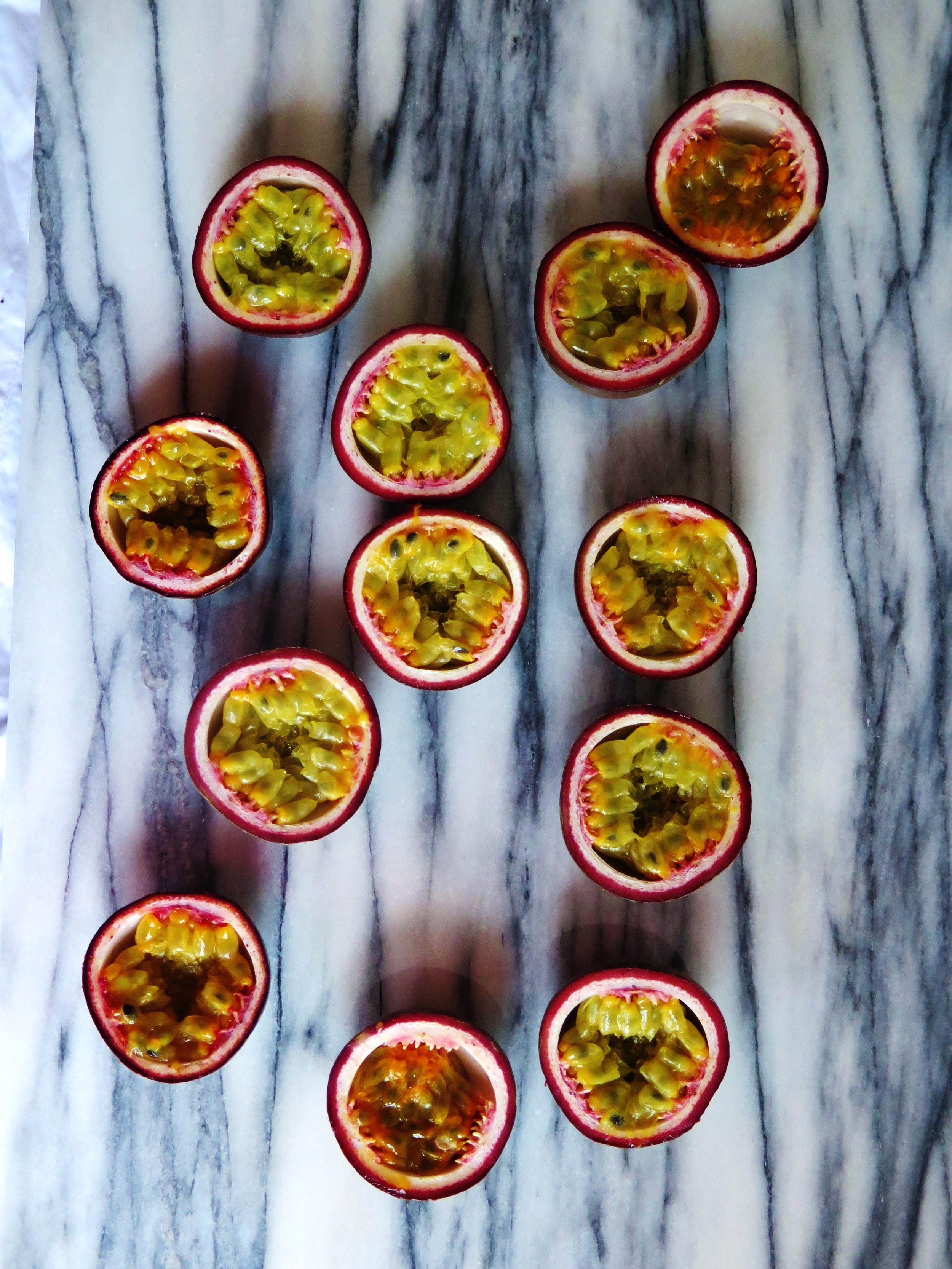
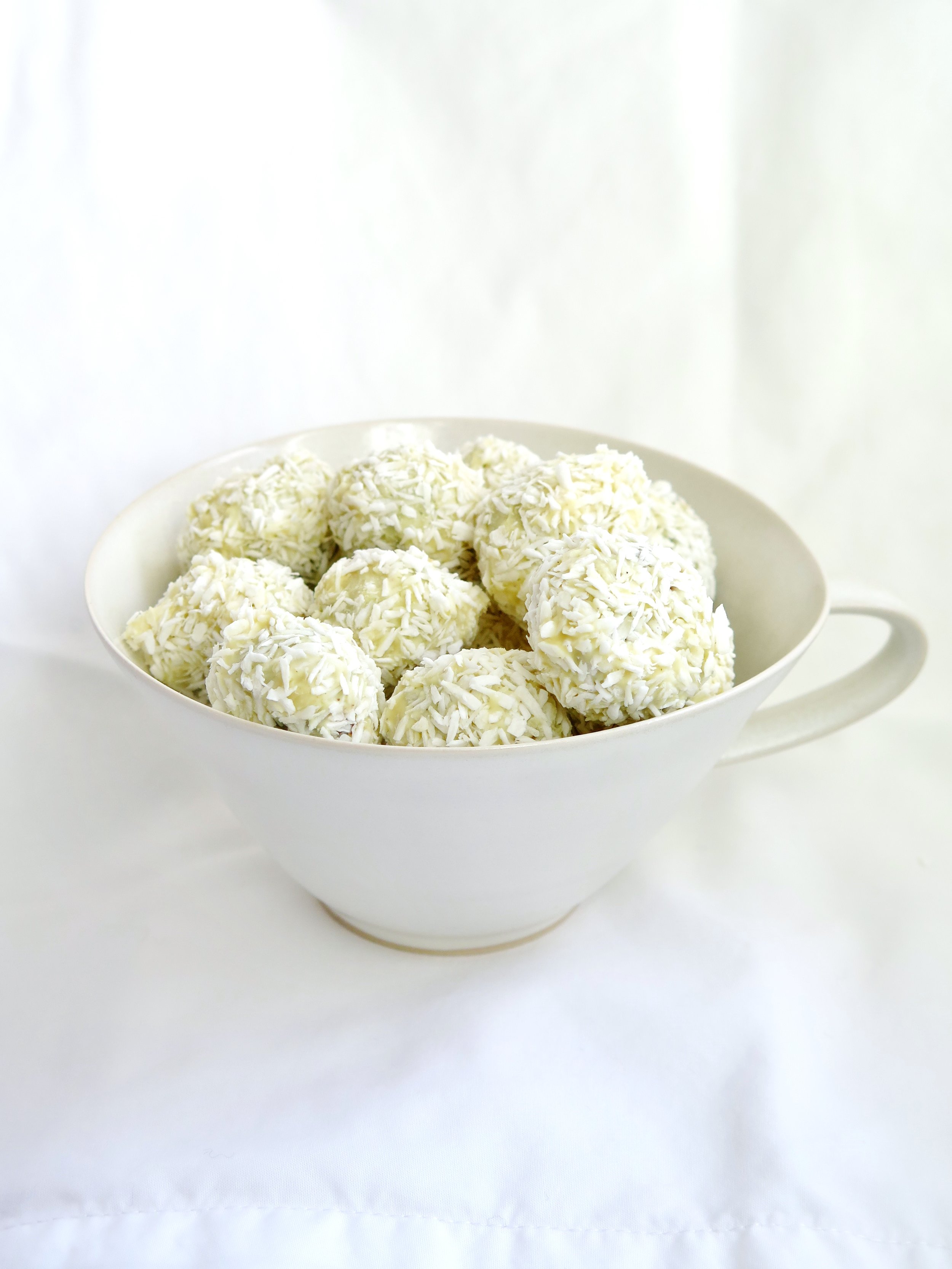












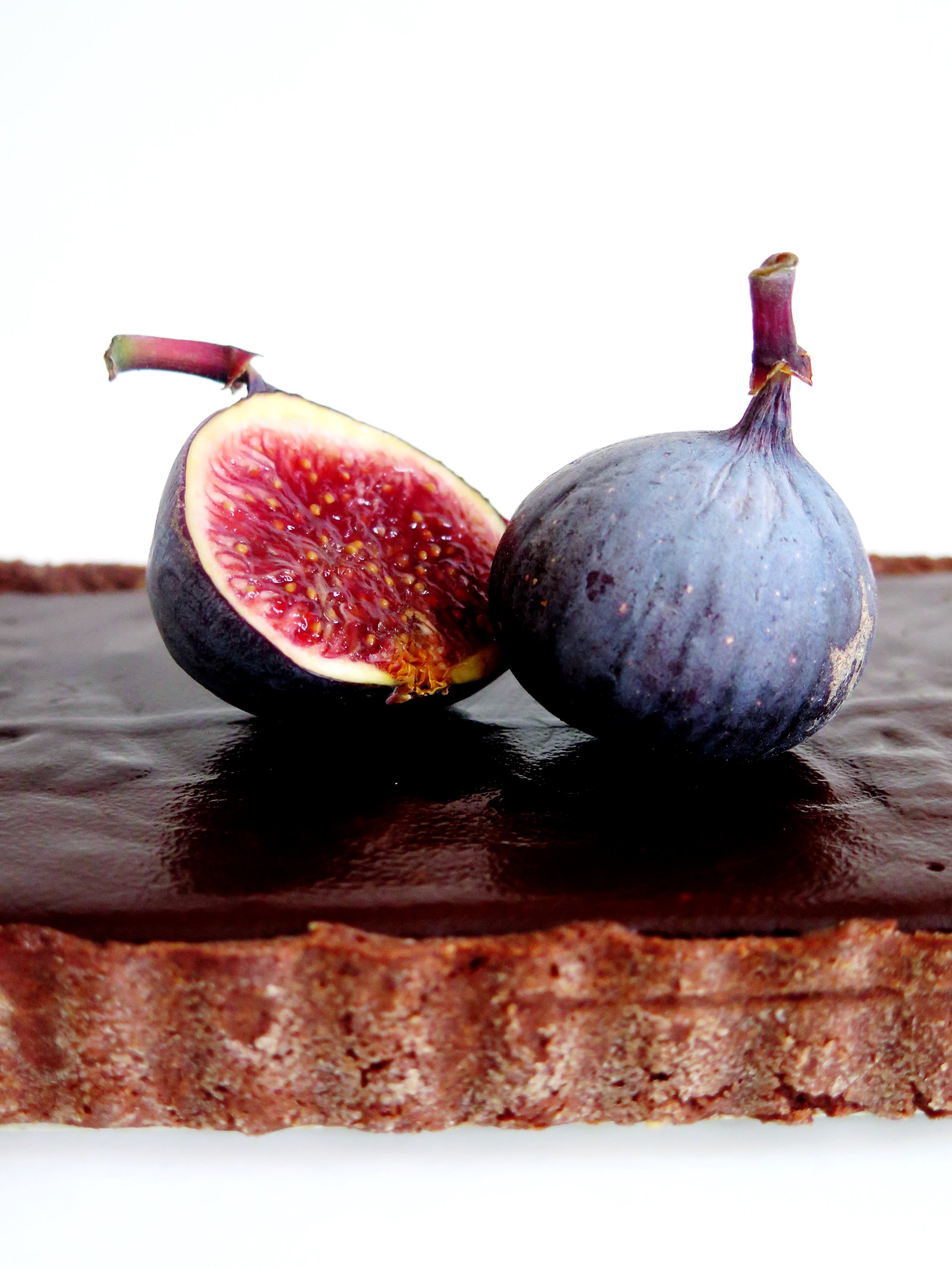
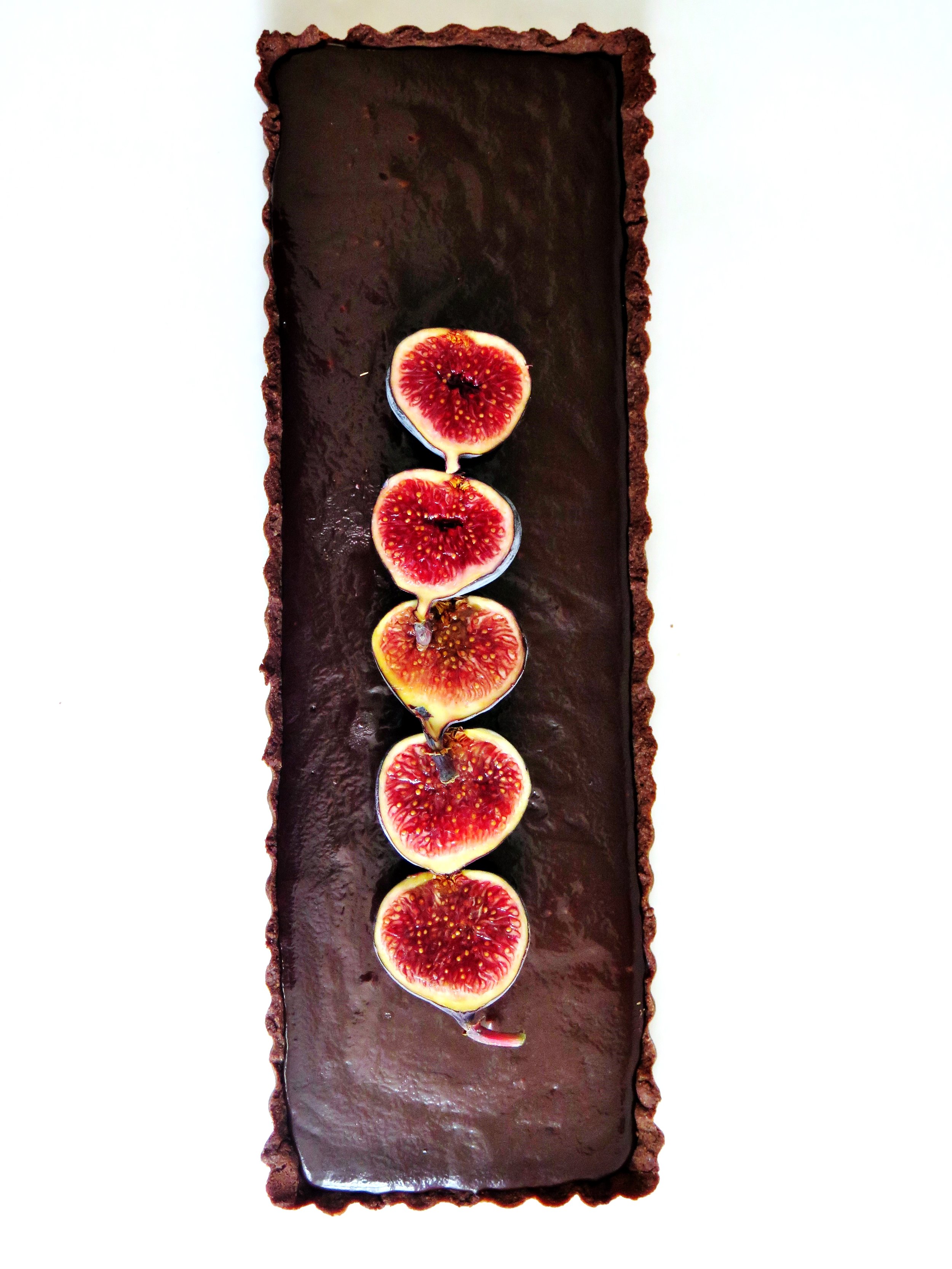


This recipe is delivered with a warning: this stollen, despite its understated, simple, appearance, is highly addictive. I ate almost an entire stollen in one day and felt quite sorry for myself afterwards (guilt streaked sugar-overload), so arm yourself with friends or a freezer before making it